- Marine Supplies
- Maintenance & Boating Guides

Catamaran vs Monohull: Pros, Cons & Main Differences
By: B.J. Porter Editor

The choice of catamaran vs monohull ultimately comes down to preference. What’s critical for one buyer may mean little to another. If your partner refuses to set foot on a boat which heels, that’s a deal-breaker for a monohull. But if you’re passionate about classic looks and styling, your quest for beauty may override other considerations and rule out catamarans.
We can’t tell you whether a catamaran or a monohull is right for you. But we can help you with the pros and cons of each for your search.
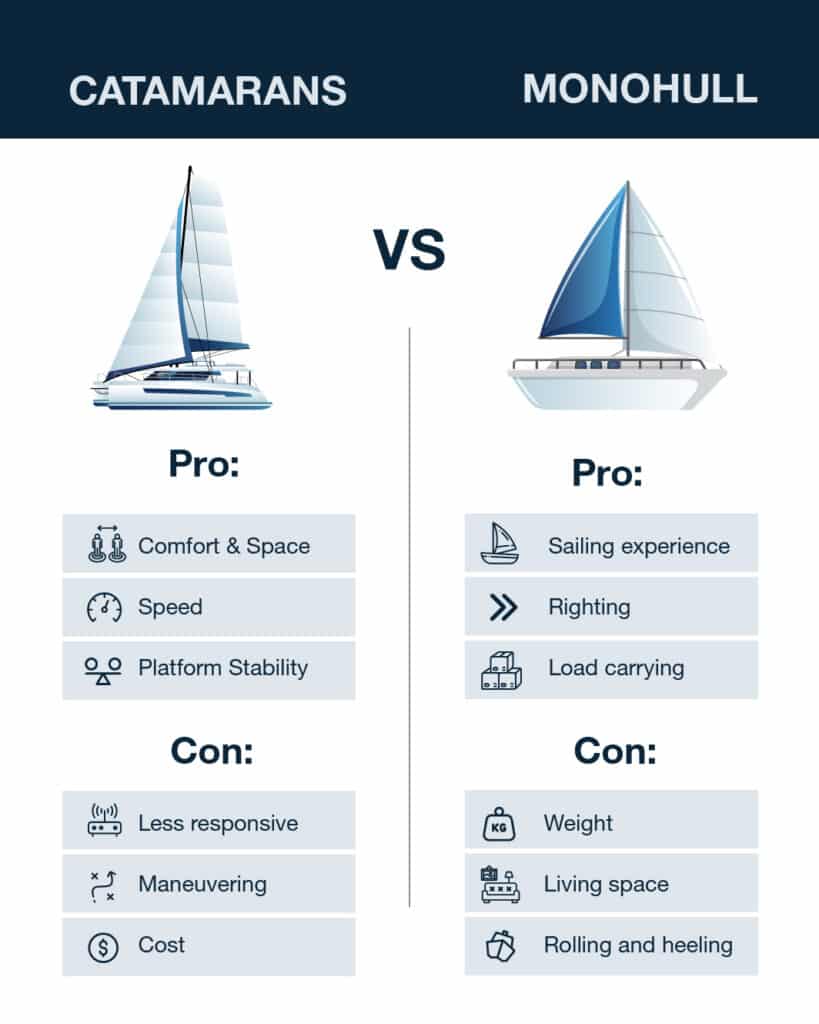
The Strengths and Pros
No matter your choice of monohull or catamaran, there are safe, comfortable, and excellent sailing boats of both types. Neither has an exclusive lock on any strength, and both sail safely and comfortably. But there’s a different emphasis on how they do it. No matter what you are trying to do – sail fast, cruise the world, or just host a crowd at the dock, there are monohulls and catamarans that can work for any requirement.
Catamaran advantages
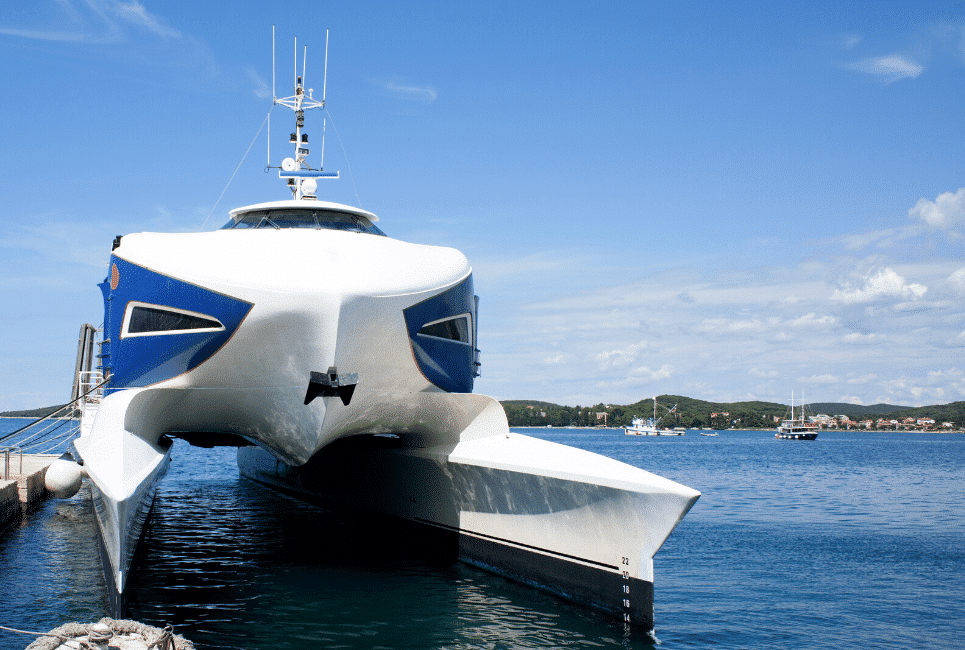
Space and comfort: Two hulls and a wide beam make a very stable platform with lots of volume in the saloon and cockpit. Most living space is above the waterline, with wonderful light and airflow. Cabins in the hulls offer better privacy and isolation, usually with standing headroom.
Straight line speed: Most catamarans are faster in straight-line sailing speed (1) that similar sized or even longer monohulls. Without a lead keel, they’re lighter, so more driving force from the sails converts to speed, and narrower hull forms may have less drag than wide hulls with deep keels. Some heavier cruising catamarans may not be faster, especially if they keep rig size small for ease of handling.
Stability : The beam of two hulls with a bridge deck leads to much higher stability and resistance to roll (2). Waves in an anchorage that induce violent roll in a monohull may make a catamaran bounce or bob. Under sail, catamarans do not heel appreciably even when powered up.
Twin engines. : With one engine in forward and balanced in reverse, most catamarans can spin in a circle in place and make sharp adjustments to the boat’s direction. If you have an engine failure, you also have a second engine, giving a safety edge when you can’t sail.
Monohull advantages

Upwind sailing performance: While catamarans have the edge at straight-line speed, monohulls sail closer to the wind. When you’re racing or you have to sail upwind to get to the next island, this can get you there faster.
Sailing feel and responsiveness : The “feel” of sailing a monohull is much better. With a single hull, you’ll feel wind pressure and trim adjustments immediately for a more responsive helm and a better ability to sail to the wind.
Maneuvering under sail: Monohulls are quite nimble tacking and turning under sail, and there’s less risk of slow or missed tacks.
Righting Moment: The primary offshore safety argument for monohulls is their ability to right when capsized. The heavy keel keeps the boat deck up when sailing, and most monohulls will come back upright even after a complete capsize.
Cargo and Loading: A higher displacement boat with thousands of pounds of lead hung from the bottom isn’t going to be as affected by loading as a relatively light multihull.
Aesthetics: This is subjective, as many catamaran enthusiasts love how they look. Classic sailboat styling, with swept sleek looks, springy sheer lines, and all the “right” proportions are more common on monohulls.
Also read: The 5 Best Electric Anchor Winches
Weaknesses and Cons
Like strengths, weaknesses are relative; just because one class has a strength doesn’t mean the other doesn’t. There are spacious monohulls and beautiful catamarans, just like there are cramped catamarans and unattractive monohulls. The differences have to be highlighted relative to each other, and the weaknesses of one are most apparent compared to the strengths of the other.
Catamaran Cons
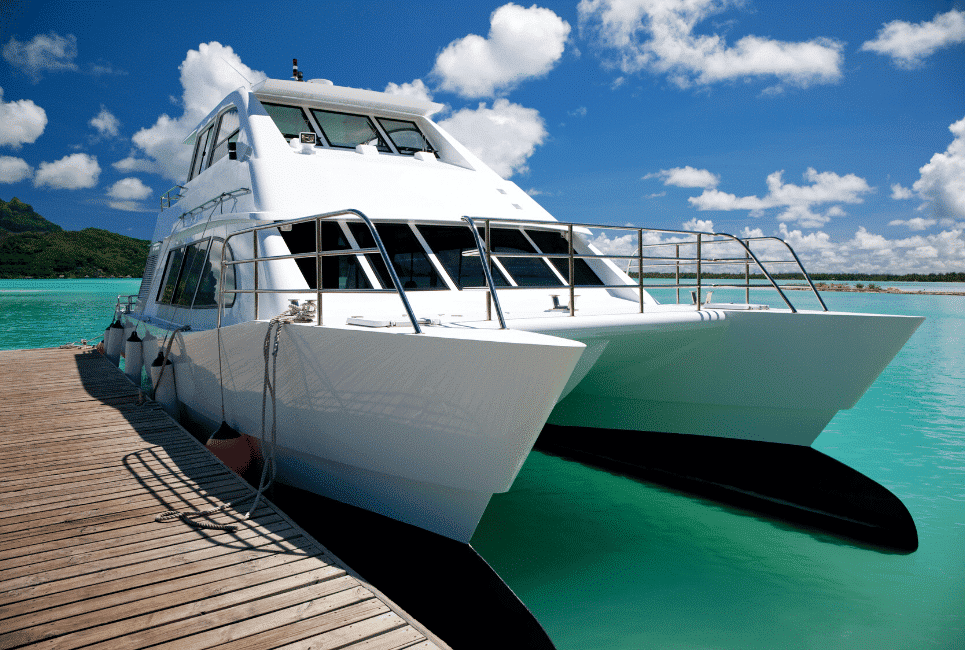
Upwind performance: Cats don’t sail as close to the wind, but they make up for it by sailing faster off the wind. You’ll sail a less direct course upwind. Even if you get in at the same time, you’ll have to sail farther.
Less responsive sailing: Two hulls with two rudders and a very broad platform reduce the helm feel when sailing, cutting responsiveness sailing in shifting wind and wave conditions. It also makes tacking slower.
No-flip zone: It is very difficult, but not impossible, to flip a large catamaran (3). But if a catamaran capsizes, it will not flip back over by itself.
Large in marina/close quarters: You have two problems in marinas. Beamy cats are tough to maneuver in tight spaces because they’re big and visibility is tough over the hulls. And many marinas charge extra because the wide beam extends into the next slip. The good news is that twin engines make tight maneuvering easier.
Price point: Catamarans are more difficult to build and need more materials. This is directly reflected in the cost of the boats.
Monohull Cons
They are heavier: Every large monohull needs a keel for stability (4). They can not sail or stay upright without thousands of pounds of ballast, and this makes them heavier and slows them down. Tiny monohulls can use a centerboard or daggerboard for stability, but most boats big enough to sleep on need ballast.
Darker interiors : Most monohull living space is lower in the boat, where you can’t put enormous windows for light and circulation. It’s very hard to get space as bright and airy as catamaran saloons.
Less living space: With one hull and no bridge deck saloon, most monohulls feel cramped compared to spacious catamarans.
More prone to rolling motions : Only one hull makes monohulls susceptible to rolling in waves, and the movement can be quite uncomfortable.
Heeling: Tipping is just part of sailing monohulls upwind and is unavoidable. It can be reduced on some other points of sail, but not eliminated. Many people, especially non-sailors and new sailors, find this movement uncomfortable or distressing.
You might also be interested in: How to Buff a Boat | A Detailed Guide by a Boating Expert

Troubleshooting Pontoon Boat Battery
Pontoon boats are a great way to enjoy the water and spend quality time with family and friends. But just like any other boat, they rely on a battery to power various systems, including navigation lights, trolling motors, and other…
Boat Accessories

Best Ice Fishing Fish Finders in 2023
In search of the best ice fishing fish finders in 2023? Not all fish finders are created equal, particularly when it comes to ice fishing. Specialized features are crucial to ensure successful outings in harsh winter conditions. You require a…

Best Side Imaging Fish Finders in 2023
Navigating the world of angling equipment can be challenging. That's especially true when it comes to side imaging fish finders, given the extensive range of options available in 2023. This post makes it easy for you to narrow down your…

How to Choose a Fishfinder for Your Boat: A Comprehensive Guide
Today, we embark on a journey to unravel the secrets of choosing the perfect fish finder for your boat. As we navigate through an ocean of options, we'll explore different types of fish finders, delve into their key features, and…
Accessories
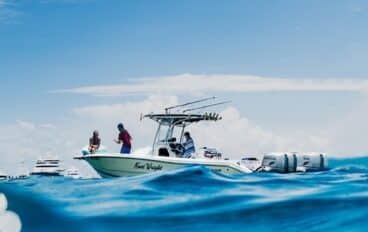
5 Best Portable Fish Finder in 2023
Looking for a portable fish finder for kayaking, ice fishing, or other activities? The good news is that there are a lot of solid products out there. The year 2023 has ushered in an array of advanced models, each brimming…
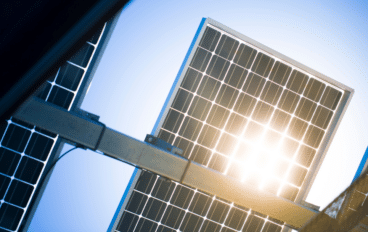
Charging Your Trolling Motor Battery with a Solar Panel
Charging your trolling motor battery with a solar panel is not just the right thing to do for the environment, it is extremely convenient. When you’re out on the boat, with any luck, you’ll have access to a good amount…
Don't miss out

Catamaran Vs Monohull

Monohulls and traditional sailboats, once ubiquitous, are giving way to modern catamarans. But how do these designs differ?
Monohulls have a single hull, and catamarans have two hulls side-by-side. Catamarans are faster than monohulls of the same length and displacement, but monohulls are stronger and more spacious. Monohulls are also cheaper and easier to build than multi-hulls.
In this article, we’ll cover the differences between catamarans and monohulls, along with the benefits and drawbacks of each design. We’ll also cover the sailing characteristics of each and why catamarans so easily outrun equivalently-sized monohulls.
We sourced the information used in this article from trusted sailboat design resources, along with manufacturer specifications and boat market analysis.
Table of contents
What is a Catamaran?
Catamarans are a kind of multi-hull sailboat with two hulls joined together. They are often short and wide, resembling a square or rectangle from above.
Catamarans are colloquially distinct from outriggers, which are double-hulled vessels with one large primary hull and a small outboard stabilizing hull.
Catamarans usually have hulls that mirror each other, both in size and arrangement. Sometimes, the interior layouts are mirrored, too—but this varies between designs and manufacturers. Catamaran hulls are narrower and taller than most monohull designs of equal lengths.
Catamarans have limited commercial and military utility, as these applications favor space and ease-of-construction over handling characteristics. That said, there are some commercial uses for catamaran designs—most commonly passenger and car ferries.
What is a Monohull Sailboat?
A monohull is probably what you traditionally think of as a boat. Monohulls are longer than they are wide. It features a single hull—it’s that simple. Sailing monohull designs have evolved over the centuries into many distinct types, usually distinguished by keel type.
Monohulls come in many shapes and sizes . For example, sailing monohulls designed for offshore use have long keels that sometimes extend much further below the waterline than the freeboard and cabin extend above it.
Monohull sailboats are also designed for other purposes, such as inland sailing and racing. These vessels have more contemporary characteristics, such as rounded shallow ‘canoe’ bottoms, V-bottoms, and fin keels.
Monohulls aren’t just sailboats. Virtually every cargo and container ship, warship, and many passenger ships are monohulls due to their strength, ease of construction, and high cargo capacity.
Are Monohull Sailboats More Common?
Monohulls are more common in every application, though multi-hulls are becoming more common for ferries. Monohulls have numerous benefits over multi-hulls, and these benefits only increase with scale.
Monohulls are easy to construct. They’re also cheap. Large monohull ships, such as container ships, can be built with very little material and effort. This is because the vast majority of the length of a monohull is just a box, with a bow and stern welded onto the end.
Sailboat construction is more intricate, but the costs are still lower. Plus, monohull designs are robust, and cabin space is plentiful. There’s a lot more study in the field of monohull design, which was the universal truth until somewhat recently.
But all in all, the reason why monohull sailboats are more common is that they work just fine. Most sailboat owners aren’t interested in breaking speed records or hosting dozens of people aboard their boats. As a result, a standard, simple, and easy-to-control monohull are more than sufficient.
Are Catamarans Faster than Monohulls?
Catamarans are most certainly faster than monohulls. This is almost always the case. Even the fastest production monohulls can’t hold a candle to the average cruising catamaran.
But why is this the case? Aren’t catamarans restricted by the same hydrodynamic forces as monohulls? As it turns out, they aren’t. This has to do with the unusual way hull waves impact speed.
Hull Speed Limitations
Monohull speed is limited by something called hull speed. Hull speed is determined using a formula that calculates the maximum speed a displacement hull can travel under normal power and conditions.
When a displacement hull moves through the water, it kicks up a set of waves at the bow and stern. These waves travel along the side of the vessel and create drag, which slows down the boat. Normally, the power of the wind can overcome this drag—but only to a point.
At a certain speed, the waves kicked up by the bow will sync with the waves kicked up at the stern and begin ‘working together’ against the boat. The speed at which this occurs is the hull speed, which is calculated from the length of the boat.
Hull speed limitations for monohulls aren’t universally true all the time. Some vessels exceed it, and some don’t—but the number is a useful estimate of the limitations of monohull designs. Modern monohulls with clever hull shapes can defeat hull speed calculations.
Do Hull Speed Limitations Apply to Catamarans?
Surprisingly no—hull speed calculations don’t work for catamarans. This is because, for one, the hulls are shaped differently. Alone, catamaran hulls wouldn’t float correctly. But together, they create different hydrodynamic effects and cancel out the effects of hull speed.
This means that catamarans can easily exceed the speeds of even the fastest monohulls of equal length—and sometimes beat them by a margin of 50% or more. It’s not unheard of for 40-foot catamarans to exceed 20 knots, whereas 40-foot monohulls rarely get past 10.
Are Catamarans More Comfortable than Monohulls?
Catamarans can be much more comfortable than equivalently-sized monohulls—up to a point. This is because catamarans engage in ‘wave piercing’ and have a wider and more stable footprint on the water.
Catamaran hulls, when properly designed, can slice through parts of a wave instead of riding over every peak and trough. This effectively reduces the height of the weight, which reduces the amount the boat rolls.
Additionally, the wide footprint of a catamaran allows some waves to simply pass right under it, keeping the boat level for longer durations. Catamarans also don’t heel under sail—instead, they plane slightly, raising the bows out of the water and reducing bumps.
Monohull Benefits
Monohulls are proven in all conditions. A well-designed displacement monohull sailboat can ride out the strongest storms, and monohull workboats can support enormous loads and move them efficiently. They can be fast, comfortable, and also easy to sail (even for beginners).
Monohulls are cheap to build and forgiving, as precision doesn’t have to be microscopic to get them to sail right. They’re robust and strong, featuring a naturally stress-resistant hull shape. They’re also easy to modify and aren’t required to meet as strict of dimensional ratios to operate.
With a monohull sailboat, you have a lot of interior room to work with. This means that monohulls are available in numerous cabin layouts and are just as easy to modify as they are to build. Monohulls often have a center of gravity at or below the waterline, which enhances stability at steep heel angles.
On the water, displacement monohulls can weather extreme conditions with ease. They lack the initial stability of multi-hulls, but they can recover from knockdowns on their own, and they’re very difficult to push past their rollover point.
Why do Catamarans Cost More than Monohulls?
Catamarans cost more than monohulls because they’re more expensive to build, more complex to engineer, and require more material. This isn’t always the case, but the design of catamarans requires much more careful engineering and strength-of-materials analysis than comparatively simple monohulls.
There are several critical structural points on catamarans that monohulls lack. In fact, the very shape of a monohull is physically strong—so it has inherent durability. Catamaran hulls must be joined in the middle, and the mast must have a strong point far from the inherently sturdy hulls.
This requires stronger materials and more care during design or construction. This is why catamarans remain a premium part of the sailboat market and why they still aren’t the most popular sailboats despite their numerous performance and comfort benefits.
Catamaran Cabin Layout
Catamaran cabins are split between the two hulls, and there’s usually a large pilothouse in the center. Pilothouse catamarans can be quite spacious, primarily due to the large space between the hulls.
The pilothouse is usually where kitchen and sitting areas are located, along with cockpit access and the controls of the sailboat. The mast is also located in this area.
Catamaran cabins sometimes mirror each other. For example, each hull may contain two identical bedroom/bathroom combos, while the center console area contains the kitchen and living spaces.
The two identical hulls sometimes make for unusual design decisions (such as small catamarans with four master bedrooms), but owners say this gives their passengers a much better experience than a monohull cabin.
Monohull Cabin Layout
Monohull cabins, with the exception of split-cabin sailboats with a center cockpit, have only one large interior space to work with. It’s usually much wider than catamarans of equal length.
Monohull cabins are usually accessible from the bow (via a flush deck hatch) and the stern via a traditional companionway. They run the span of the hull between the bow and the cockpit and sometimes include spare berths under the cockpit seats.
These spare berths are often used as convenient sea cabins, as they offer quick access to controls in case of an emergency. Catamarans often have convertible berths in the center console for the same reason.
Monohull cabins are traditional and include everything that catamaran cabins do—albeit with slightly less room overall. That said, individual spaces are often much wider, and facilities are more appropriate.
Related Articles
Daniel Wade
I've personally had thousands of questions about sailing and sailboats over the years. As I learn and experience sailing, and the community, I share the answers that work and make sense to me, here on Life of Sailing.
by this author
Learn About Sailboats
Most Recent

What Does "Sailing By The Lee" Mean?
October 3, 2023

The Best Sailing Schools And Programs: Reviews & Ratings
September 26, 2023
Important Legal Info
Lifeofsailing.com is a participant in the Amazon Services LLC Associates Program, an affiliate advertising program designed to provide a means for sites to earn advertising fees by advertising and linking to Amazon. This site also participates in other affiliate programs and is compensated for referring traffic and business to these companies.
Similar Posts

Affordable Sailboats You Can Build at Home
September 13, 2023

Best Small Sailboat Ornaments
September 12, 2023

Discover the Magic of Hydrofoil Sailboats
December 11, 2023
Popular Posts

Best Liveaboard Catamaran Sailboats
December 28, 2023

Can a Novice Sail Around the World?
Elizabeth O'Malley
June 15, 2022

4 Best Electric Outboard Motors

How Long Did It Take The Vikings To Sail To England?

10 Best Sailboat Brands (And Why)
December 20, 2023

7 Best Places To Liveaboard A Sailboat
Get the best sailing content.
Top Rated Posts
© 2024 Life of Sailing Email: [email protected] Address: 11816 Inwood Rd #3024 Dallas, TX 75244 Disclaimer Privacy Policy

Join us at the Annapolis Boat Show Oct 10 – 14 and sign up for our Charter Management Seminar. CLICK HERE!
Catamaran vs. Monohull: We Changed, Should You?

There are two schools of thought when it comes to monohull versus catamaran . We have done extensive cruising and lived aboard two monohulls and four catamarans over the past 25+ years . We experienced the good and the bad for both single hull and multihulls first hand. Quite honestly, the pluses for catamarans far outweigh the minuses. There are multiple benefits of catamarans. They are faster, more stable and spacious, and have shallower drafts allowing safer anchorage closer to shore. Being on a stable platform with no heeling cuts down on crew fatigue and seasickness leaving the crew more alert and in control of the vessel. Even novice sailors feel more confident on catamarans.
When we built our monohull Royal Salute in the early 90s, catamarans were not established and were looked upon with extreme suspicion by most cruisers, including ourselves. “Safety and the capsize” issue were always the first things to come up against sailing catamarans. It is a fact that monohulls can get rolled in heavy seas but will right themselves because of the heavy lead keel, and while crew and vessel will be battered, the roll is survivable.

However a catamaran once capsized, will remain upside down (jokingly referring to this state of the catamaran as “reaching its most stable position when upside down”). The inability of a catamaran to self-right was and still is a major bone of contention. However, what is not often discussed is that a monohull has about a 5,000 pound keel of lead that is constantly trying to drag the boat to the bottom of the ocean versus a catamaran that has no ballast and is in most cases with modern catamarans, unsinkable.
So the options are to either sail the world on a boat that, if it springs a leak, will sink like a stone or a vessel that cannot self-right in the event of a capsize but will not sink no matter what. So from a practical point of view, here are our observations over the last 25+ years of living aboard, on the advantages and disadvantages of a catamaran.
ADVANTAGES OF A CATAMARAN
1. speed equals safety.
The speed of a catamaran makes it possible to outrun bad weather. While catamarans do not point as high into the wind as a monohull (or if it does, it makes more leeway or slides sideways), it is about 20% faster than a monohull. This means that even if you sail upwind at a slightly wider angle to the wind than a monohull and have to cover more distance, you will still arrive at your destination long before a monohull.
A modern performance catamaran with daggerboards and good quality sails will point as high as a similar sized monohull. It will point the same as a comparable monohull and sail much faster and therefore arrive at an upwind position much sooner than a the monohull. It is important to note that most of the production catamarans on the market are under-powered and are equipped with standard smaller sails. In lighter breezes many of these designs perform poorly unless fitted with bigger headsails, a Code Zero and a square-top mainsail.
While we believe that more comfortable and safer in rough weather , we have to concede that when the weather gets really bad (60 knots of wind or more) we would personally prefer to be on a monohull from the standpoint of surviving. I would say that a monohull is preferable for serious offshore single-handed sailing because you can more easily hove-to in a monohull. We have been in some extreme weather on a number of catamarans and never really felt that we were in danger, although it takes some nifty seamanship.
A monohull could capsize in extreme weather or even roll in a storm, but they generally come back upright. A catamaran on the other hand, will not right itself. But the cat will generally stay afloat, offering a good place to survive while you wait out the storm or until help comes along. Well-designed modern catamarans are very hard to capsize though.
Having said all that, most catamarans can do 200 to 250 miles a day and with modern technology allowing one to pull down weather at will, there is no good reason why you should get caught in extreme weather. A faster boat is a safer boat as it will in many cases be able to outrun bad weather. With good weather routing information a catamaran can avoid most serious weather and, at worst, place itself in the most favorable position to avoid the brunt of a storm.
2. A Catamaran is a Stable, Safe Platform Underway
Catamarans have no ballast in the keels like monohulls do and therefor it relies on beam and buoyancy for stability. Typically cruising catamarans will have a beam to length ratio of roughly 50%, although many designs nowadays exceed the 50% rule of thumb. So, a 45-ft long catamaran will be about 22-ft wide, providing a very stable platform when sailing. Unlike catamarans, monohulls cannot overcome the rolling and pitching with their narrow beam and the lead ballast for stability.
This rolling and pitching makes the deck on a monohull very unsafe whereas on walking around on the deck of a catamaran while underway is far easier since the boat is much more stable, and it doesn’t heel. This makes sail changes and reefing much easier and a lot safer for the crew. Without the rolling and pitching motion, the danger of falling overboard on a catamaran is considerably less than on a monohull.
3. Crew Fatigue Reduces on a Catamaran
Because a catamaran does not heel over like a monohull, it offers far more comfort underway because the motion is mostly fore and aft pitching and very little beam-to-beam rolling. On all points of sail, a catamaran tracks upright and significantly reduces crew fatigue and seasickness. Seasickness is usually caused by things like anxiety, fatigue, hunger and cold, which all add to a sense of disorientation. This leads the crew to making bad decisions and seamanship errors that could be fatal to the crew and vessel. The more stable platform of the catamaran will hugely keep those issues at bay, making the crew more alert and energized.
Every action and chore including cooking is much easier on a catamaran when underway. It is much more pleasant to be on the deck level looking out rather than being stuck “down below.” It is also much nicer to sleep on a boat that doesn’t heel. I remember nights at sea in our monohull when I was rolling around in my bunk unless I was properly wedge in a little corner. That is simply not the case on catamarans.
All these factors ensure that your crew will not expend unnecessary energy to simply try and stay upright, onboard and safe on a long passage. Your crew on a catamaran will be well rested and alert and will be able to function well if a stressful situation arises.
4. Comfort at Anchor
Catamarans provide a wide platform and therefore offer lovely spaces to relax at anchor without the rolling motion that monohulls have a tendency to do in a swell. During our 15 years of cruising on a monohull, we have often had to leave anchorages that we really were not finished exploring because of a rolly, uncomfortable anchorage. Big rollers or swells coming into an anchorage can make conditions in an anchorage very uncomfortable and unsafe.
We were anchored off Funchal on the island of Madeira in our monohull Royal Salute once, when we were forced to leave our anchorage. The rolling became so bad, we were rolling from gunnel to gunnel. The anchorage became untenable to remain anchored, forcing us to go out to sea in foul weather in the middle of the night. This is an extreme case but believe me, we have left many an idyllic anchorage because of a rolling swell into the anchorage. Catamarans, on the other hand, do not roll from like monohulls have a tendency to do and are far more comfortable at anchor.
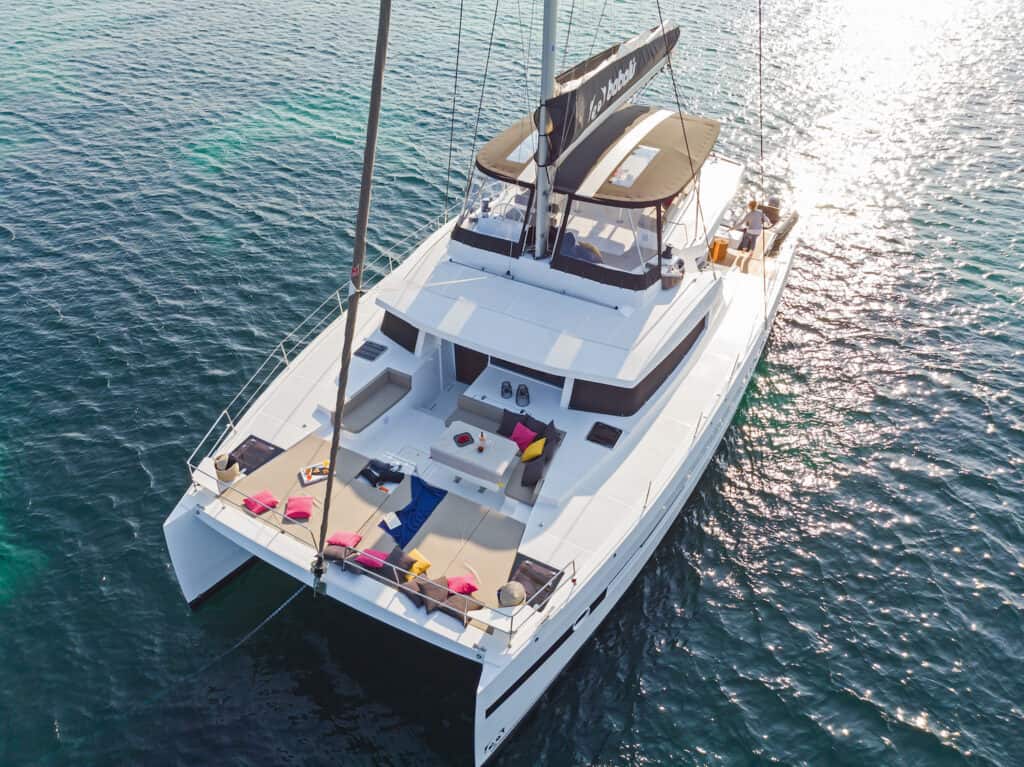
5. Anchor Bridal Setup

Catamarans are fitted with a bridle, attached to both bows and down to the anchor chain, resulting in a very stable position at anchor. What we found with our monohull was that because the bow acts as a sail (because of the high freeboard), the boat tended to sail at anchor in high winds. It sailed in one direction until the chain snatched and tacked over and sailed in the other direction, feeling like it might dislodge the anchor altogether. The catamaran on the other hand sits at anchor a lot more stable and doesn’t sail around as much.
6. Ease of Boarding on a Catamaran
Thank goodness we were much younger and more agile during our monohull days. Royal Salute and most monohulls of her generation or older, have high free-boards, making it quite a feat to get onto the boat from the dinghy. It was one of the most challenging things to do because unlike the more modern monohulls that have a scoop at the back, we had to climb up on the side of the boat to get on and off. We, of course rigged steps, etc. but it was always a hassle compared to the ease of getting on and off a catamaran from a dingy or from the water.
7. Shallow Draft Equals Better Anchorages
Catamarans have significantly shallower drafts than monohulls, allowing for safer anchorages closer to shore. Most catamarans in the 40-ft to 50-ft range draw between 3-ft to 4.5-ft, so they can anchor in places that a monohulls can not even consider. In the shallow waters of the Bahamas for example, the catamarans have a big advantage. We often anchor our own catamaran just a few feet away from a beach. It definitely allows one to be able to explore areas where the water is shallow without the fear of running aground.
The shallow draft also allows for emergency repairs in shallow water and even doing the bottom job when the tide goes out as we have done in places like Mtwapa Creek in Kenya, East Africa. The catamaran easily rests on her keels on the sand without help making it a breeze to do the “annual haul out” even in remote locations.
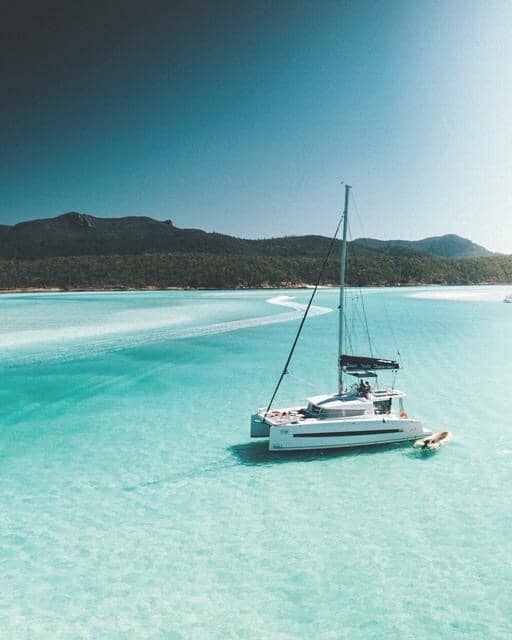
8. Dinghy Davits & Dinghy Size
All catamarans have a set of davits that make it very easy to raise and lower the dingy. Our monohull and most cruising monohulls do not have an efficient or easily accessible set of davits. This makes raising and lowering the dingy an elaborate production. Catamarans on the other hand, has davits systems easily accessible and some even have platforms to rest the dinghy on.
The lack of beam and difficulty of lifting the dinghy also limits the size and type of dingy that one can reasonably carry on a monohull. As we all know, the dingy is your transport to and from shore and diving or fishing spots, so the bigger and faster the dingy, the better off you are. A catamaran can carry both a heavier and bigger dinghy which makes the popular center consul dinghy so much more possible.

9. Interior Space and Comfort on a Catamaran
We sailed 32,000 NM on our 45-ft monohull, happy as clams, not realizing that sailing does not have to be done lying on your ear 24/7 while on passage or sitting knee-to-knee in the cockpit at anchor with your two other guests at the dinner table! One can liken sitting in a monohull cockpit to sitting in an empty Jacuzzi, you are always nice and close to the other folks.
Now that we are on our fourth catamaran, there are a few things that have become more evident to us than the incredible space and comfort of a catamaran, not only at anchor but also underway. The cockpit and living space in general are huge compared to a monohull, making for very comfortable and spacious living conditions. It feels more like you are at home, rather than just on a camping trip.
Knowing that one spends at least 90% of one’s cruising life at anchor, it’s important to have good open living space, which most modern cats nowadays offer. A lot of cats have walk around beds, lots of storage, every modern appliance including washer/dryer, etc. However, one has to fight the urge to fill the space if you want to keep the cat light and fast.

Sailing with guests onboard for extended periods of time, in close quarters can become claustrophobic but on a catamaran people are spread out and separated. With guests sleeping in one hull and the owners in another, catamarans offer much more privacy and separation. Some cats even have privacy doors that will close off the entire hull and has a separate entrance onto the deck, which really separates you from the guests completely.
There is very little heeling on a catamaran, so there is no need for hand grips and safety harnesses inside the boat. There is nothing better (and safer) than being able to walk from the cockpit into the living room (saloon) on one level or one step down at most. In a monohull, when heeling at a severe angle, you would have to claw your way from the companionway steps down to the living area, while fighting to stay upright, significantly tapping your energy.
Unless you hit extreme conditions, everything stays put on a catamaran reducing the anxiety before doing passages of having to stow and secure everything. This very issue makes a lot of cruisers reluctant to weigh anchor and explore more often. It is just too much effort to pack away all your stuff once comfortable in an anchorage!
One thing you will notice is that the stove on catamarans are not gimbaled like it is on monohulls and this should tell the story in itself. The stability and comfort on a catamaran is far superior. Cooking is easy and safer. I often open a nice cold beer, put it down to do something and forget about it only to find a warm beer later in the same place I left it. This is not something that happens on a monohull.
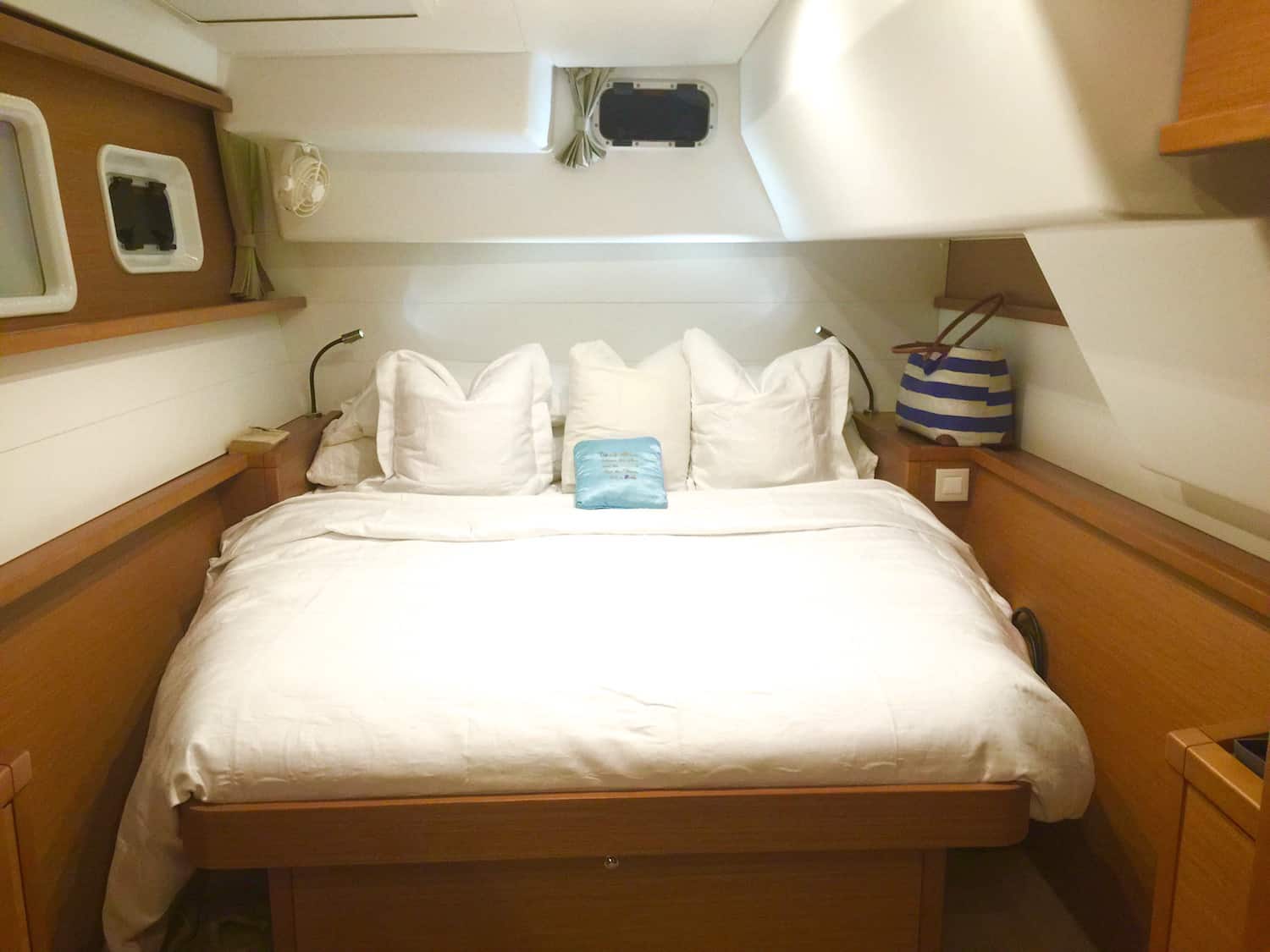
10. Redundancy on a Catamaran
Unlike monohulls, catamarans have a lot of critical redundancies. That of course means two hulls to clean and anti-foul, double the engine maintenance, etc. but having two of the critical equipment like engines for instance, outweighs the downside.
With two engines, if one fails you still have adequate propulsion to go anywhere. If by some fluke the second engine also fails, you have a full set of spares to fix at least one of them. Our friends once hit a sleeping whale off Tanzania, and when it dove, it hit the prop, bending it. They limped into the narrow channel on the one engine but at least they could make it to a safe harbor where we surveyed and repaired their damage.
We often only use one engine when motoring while making passage in order to conserve our fuel. The one engine is totally capable of moving the boat along at a good speed unless you are in heavy seas and you may need more power. Other than that we only use two engines to dock or maneuver the boat in close quarters.
Because there are two engines there are also two independent charging systems via the alternator on each engine. If one alternator goes out, there is still another complete charging system. There are two rudders and if one fails or falls off (as has happened to our friends on a monohull off Columbia, where they almost lost their boat) you have a second rudder that is completely capable of steering the boat by itself indefinitely. That holds true for several things on a catamaran!
11. Maneuverability
The engines are spaced far apart on a catamaran and it makes maneuvering much easier and more precise than monohulls, unless the monohull has a bow thruster. We did not have a bow thruster (not many monohulls do) and had to rely on prop-walk and using prop wash on the rudder. A modern catamaran can do a 360 turn on her own axis. A monohull cannot do this and have a bigger turning circle. However, a monohull under sail is much more maneuverable and certainly will tack a lot faster than a catamaran. The ease in maneuverability under engine on a catamaran in close quarters specifically, is vastly superior comparatively.
12. Rigging
Because of the beam on a catamaran the spinnaker pole has become unnecessary equipment. Hallelujah, I say. That pole on our monohull was a pain the behind and I always hated having to use it. On a catamaran, one can fly an asymmetrical cruising chute or spinnaker, using the bows to tack the clew or run a guy through a block so it is very much simplified, easier and safer.We also sail wing-on-wing with twin headsails when we sail downwind. We use our furling jib and furling Code Zero. It is as easy as one, two, three.
DISADVANTAGES OF A CATAMARAN
1. bridgedeck slamming.
One advantage most monohulls do have when underway is that they don’t slam. Catamarans with a low bridgedeck clearance can experience significant slamming in confused seas sailing upwind. This slamming can be quite disconcerting when you first experience it as we did on a Shuttleworth 44 design, our first ever catamaran experience, 20+ years ago. At times, it felt as though the boat was falling apart. Of course the boat was fine but nevertheless, the stress on the crew from the constant noise and discomfort was significant.
Monohulls don’t have a bridgedeck which means no slamming and are therefore a bit more comfortable than l ow bridgedeck catamarans when beating into severe confused conditions or “washing machine” conditions as we call it. Modern catamarans mostly have better bridgedeck clearance and the slamming is significantly less. However, not all cats have a good clear tunnel under the bridgedeck. Some manufacturers build beds into the bridge deck in order to make more space in the chest of the catamaran where the slamming occurs. These protuberances into the bridgedeck tunnel will likely increase slamming. So be mindful of that when selecting a catamaran. We currently own a Bali 5.4 and the bridgedeck clearance on this boat is more than adequate and the tunnel is clear. We therefor experience very little slamming compared to our Prout 45 that we previously owned (picture of sister ship below) with a much lower bridgedeck.
We Explain Bridgedeck Clearance
In the pictures below, the Bali 5.4 has very good clearance from the water to the bridgedeck and has a nice clean tunnel versus the very low bridgedeck of the Sunreef 50.

2. Sailing Downwind
Monohull spreaders are set at 90 degrees to the mast whereas a catamaran has to have backswept spreaders. The reason is that, on a monohull, there is a backstay and using this, plus the intermediates you can get a nice pre-bend in the mast (the pre-bend is to flatten out the main sail and allow for better performance).
On a catamaran with no back stay, you need to use the back swept spreaders and the diamonds to pre-bend the mast. The reason I point this out is because on a catamaran, if you want to broad reach or run, the mainsail cannot be let out all the way because the backswept spreader tips could punch holes in the fabric.
On a monohull, the spreaders are at 90 degrees so you can let the main and the boom out much further which is, of course, much more effective. This is one of the reasons it is better to broad reach and tack downwind on a catamaran.
Whether a monohull or multihull, sailing dead downwind doesn’t usually make great VMG. Therefor a regular cruising cat, much like a monohull, needs a lot of sail area and has to sail deep downwind if it is to achieve a decent speed made good (VMG). This video demonstrates how we achieve this by sailing wing-on-wing downwind.

It is more difficult to find a dock either as a transient or a permanent slip for a catamaran in general because of the wide beam. But this is changing fast and will soon not be too much of an issue. In the USA dockage is charged by the length of the boat in feet, so there is no disadvantage there but, in some places, (the Mediterranean for example), dockage is charged at length times one and a half because of the additional beam.
Since the catamaran is stable at anchor, we mostly anchor out. We have more privacy, a better breeze and usually a stunning view.We have a nice dinghy with a good outboard engine and is big and comfortable enough to get to shore fast and together with the modern conveniences like the generator, watermaker and washer/dryer, docking becomes a non-issue.
It is definitely more difficult to find a travel lift with enough beam for a catamaran for a haulout, while, for a monohull, there are absolutely no problems anywhere. The wide beam of cats also greatly limits the number of shipyards that can haul them out. Most catamarans over 40-ft must be hauled out with a 50-ton travel lift. This not only increases the cost of the haulout, but greatly limits the choice of the shipyards for repairs and maintenance. With limited choice, prices are high for shipyard services.
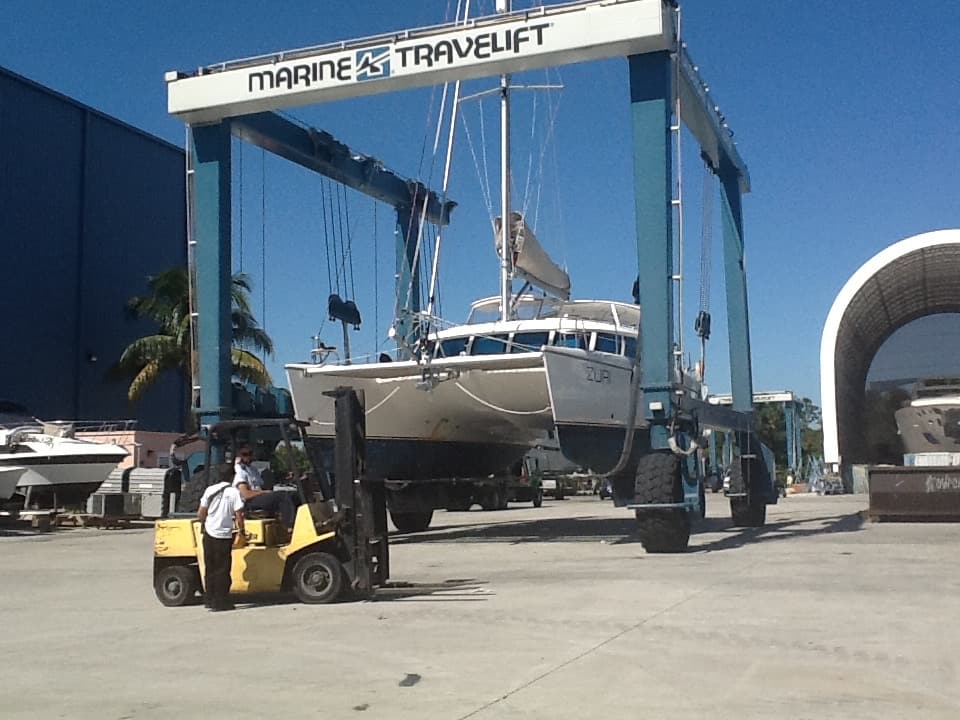
Catamarans do tend to have a lot more windage than monohulls. This can be an issue especially when maneuvering in close quarters with a strong wind. But I have found that, provided the engines are powerful enough for the size of catamaran, that twin engines negate this problem. Also, many modern large catamarans now have a bow thruster fitted. It is super easy to dock.
The cost of getting into a catamaran is much higher than that of monohulls. That could put a serious dent in your cruising kitty or require you to put your dream on hold a little longer. Pre-owned monohulls on the other hand are very cheap to buy comparatively, because the supply presently far outweighs the demand.
Catamarans are in high demand and they typically hold their value much better and longer and the trend is now heavily in favor of the catamaran market. When prospective buyers contact us for catamarans under $250,000 the choices are very limited and catamarans under $100,000 is near impossible to buy. In this case, your best bet is to go with a monohull unless you go with much older boats like the Prouts or the less expensive Geminis.
Our Own Catamarans & Monohulls
FYI: Royal Salute , a Bruce Roberts 45 monohull, was the first boat we owned and sailed approx. 30,000NM on. Mythral, a Seafarer 30, was our “toy boat” while we were waiting for our catamaran to be built. Even though this classic little monohull sailed around the world, it didn’t have much in modern conveniences like running water. Siyaya was an Island Spirit 40 catamaran that we sailed from Cape Town to Florida on and then taught live-aboard sailing classes for several years. Zuri I was a Prout 45, a beautifully crafted catamaran but by today’s standards is considered old technology. Our Lagoon 450 SporTop ( Zuri II ) is a fantastic live-aboard catamaran. We lived and taught aboard her for three years but sold her last year and we currently own a Bali 5.4 ( Zuri III or Z3 as we call her now). Read about our various boats .

CONCLUSION: CATAMARAN vs MONOHULL
We were dyed in the wool monohull sailors for 15+ years. We loved the pretty lines of monohulls, the sailing ability and what we believed at the time to be much safer vessels. However, now that we have been avid catamaran enthusiasts, we simply can never go back to monohulls. Catamarans have come of age and with modern technology have overcome most objections that sailors of old had against them. They are well designed and built, are safe, and we simply love that they sail fast and upright. There is not a whole lot to dislike about a catamaran when you live aboard. We have weighed all the pros and cons of catamarans and found that the pros far exceed the cons. We made the change to a catamaran and do not regret it one bit!
We hope that this article will clear things up for all the prospective catamaran owners out there.
Contact us if you have any questions regarding catamarans, Fractional Yacht Ownership or our Charter Management Programs .
Estelle Cockcroft
Join our community.
Get the latest on catamaran news, sailing events, buying and selling tips, community happenings, webinars & seminars, and much more!
4 thoughts on “Catamaran vs. Monohull: We Changed, Should You?”
I read that the engineering on the catamarans were improved over the years. Whats the oldest year would you recommend designwise?
Scott, my apologies for the late reply. We’ve been traveling in Africa. Anyway, catamarans have come a long way and improvements in technology is happening at lightning speed. I reckon that even the older model catamarans are good. It depends on what your needs are. If you want something a little better performance wise, I would go for something no older than 15 years.
After buying a catamaran what is the difference in expense of a catamaran vs a monohull. Many articles state that not only the initial cost of a catamaran is more it the operating cost as well.
Hi Todd, it is more expensive. The annual dockage and haul out as well as maintenance will be more expensive. You obviously have two engines to maintain and various other pieces of equipment to service in both hulls. While there is more equipment there is also more redundancy and of course you have the comfort factor. So, depending on your situation, it’s probably worth it.
Leave a Comment Cancel Reply
Your email address will not be published. Required fields are marked *
Save my name, email, and website in this browser for the next time I comment.
Recent Posts

Top 10 Reasons to Sell (and Sail) Your Catamaran in Annapolis, MD
We have a new home in Annapolis! The office is located in Annapolis, Maryland

Top 10 Reasons to Sell (and Sail) Your Catamaran in Texas
Our Texas Office is located in the Watergate Marina Center in Clear Lake Shores,
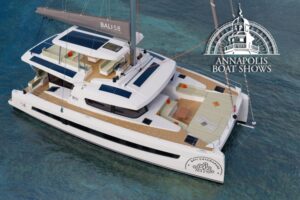
Annapolis Boat Show 2024
Meet with our team! Want to learn more about the Bali and Catana

Exploring the Catana OC 50 Catamaran: A Comprehensive Overview
The Catana OC 50 Catamaran, the latest addition to the Catana Ocean Class series,
For more than 30 years, we have been a part of the catamaran community and created Catamaran Guru™ to encourage and educate all the aspiring sailing out there. We understand the dream of traveling the world by catamaran and created a one-stop-shop to make that dream a reality for you.

- Stephen & Estelle
- Testimonials
Get Started
- Yacht Sales
- Used Yachts
- Charter Management
- Boat as Business Programs
- Seminars & Events
Catamaran Show.com
Catamaran vs monohull: choosing the right sailboat for your adventure in 2024.
In the world of sailing, few debates are as passionate and enduring as the catamaran vs monohull showdown. As we sail into 2024, this discussion continues to evolve, shaped by advancing technology and changing sailor preferences. But which vessel truly offers the best experience for modern sailors? Let's dive in and explore the pros and cons of each, helping you navigate the choppy waters of this age-old debate.

The Rise of the Multihull: The Catamaran's Case
Speed demons and safety champions.
Catamarans have earned a reputation as the speedsters of the sailing world, and for good reason. With their twin-hull design, these vessels can reach impressive speeds, especially when sailing downwind or on a beam reach. This speed isn't just about the thrill – it's a crucial safety feature. The ability to outrun bad weather can be a game-changer in open waters.
But speed isn't the only safety advantage. Catamarans offer exceptional stability in rough seas. Their wide stance minimizes rolling and pitching, creating a more comfortable ride and reducing the risk of seasickness. Plus, modern catamarans are designed to be virtually unsinkable due to their lack of ballast and buoyant hulls.
Space: The Final Frontier
Step aboard a catamaran, and you'll immediately notice one thing: space, and lots of it! The wide beam of a catamaran translates to expansive living areas both above and below deck. Imagine a spacious saloon with panoramic views, a cockpit that's perfect for al fresco dining, and cabins spread across two hulls for added privacy.
This abundance of space isn't just about luxury – it's practical too. A stable platform makes daily activities like cooking, sleeping, and moving around much easier while underway. Long passages become less taxing on the crew, reducing fatigue and stress.
Shallow Waters and Sweet Anchorages
One of the catamaran's secret weapons is its shallow draft. This feature opens up a world of cruising grounds that deeper-keeled monohulls can only dream of. Imagine anchoring close to that perfect beach in the Bahamas or exploring coastal nooks that other boats can't reach.
When it comes to anchoring, catamarans shine again. Their wide beam provides excellent stability at anchor, significantly reducing the rolling that can make life aboard uncomfortable. And let's not forget about dinghy management – most catamarans come with dedicated davits, making it easy to launch and retrieve your tender.
Maneuvering Marvel
Twin engines on a catamaran aren't just about redundancy (though that's a nice safety feature). They provide incredible maneuverability, especially in tight spaces. Imagine being able to spin your boat in place or slide sideways into a slip – it's all possible with a cat.
Modern catamaran designs have also made significant strides in sailing performance. While they may not point as high into the wind as some monohulls, the gap is closing. With features like daggerboards and efficient sail plans, today's cats can hold their own in a variety of conditions.
The Classic Choice: The Case for Monohulls
A true sailing experience.
For many, sailing is as much about the journey as the destination. Monohulls offer a sailing experience that's hard to beat. The heel of the boat as it cuts through the waves, the direct feedback from the wind and water – it's sailing in its purest form.
Monohulls generally excel in upwind performance, pointing higher into the wind and tacking more efficiently. This can make a big difference on long upwind passages or when navigating narrow channels.
Friendly on the Wallet
When it comes to cost, monohulls often have the upper hand. Generally, you'll get more boat for your money with a monohull, both in terms of length and features. This is especially true in the used boat market, where there's a much wider selection of monohulls available.
Marina fees can also be more wallet-friendly for monohull owners. Most marinas are designed with monohulls in mind, meaning you won't face the surcharges or limited availability that catamaran owners sometimes encounter.
Maintenance Made Simple
With just one hull, one engine, and generally simpler systems, monohulls can be easier and less expensive to maintain. When it comes time for a haul-out or repairs, you'll have more options available. Almost any boatyard can accommodate a monohull, which isn't always the case for wider catamarans.
Heavy Weather Heroes
When the going gets tough, many sailors feel more confident in a monohull. Their ability to self-right after a knockdown provides an extra layer of safety in extreme conditions. Monohulls have a long track record of handling heavy weather, and traditional storm tactics like heaving-to are often more effective on a single hull.
Choosing Your Perfect Vessel: Factors to Consider
Know your mission.
Are you planning coastal cruises or blue water passages? Family vacations or long-term living aboard? Your intended use should be a primary factor in your decision. Catamarans might edge out for family cruising and living aboard, while monohulls could be preferable for serious offshore work or single-handing.
Crunch the Numbers
Don't just look at the purchase price – consider the total cost of ownership. This includes maintenance, marina fees, insurance, and potential resale value. While catamarans are often more expensive upfront, they tend to hold their value well.
Skills and Thrills
Consider your sailing experience and what kind of sailing you enjoy. If you love the feel of a heeling boat and hands-on sail trimming, a monohull might be your match. If you prioritize comfort and ease of handling, a catamaran could be the way to go.
Crew Comfort
Think about who you'll be sailing with most often. Large families or those who frequently sail with guests might appreciate the space and privacy a catamaran offers. Solo sailors or couples might find a monohull more manageable and cozy.
YouTube Sailors: The Monohull to Catamaran Transition
An interesting trend in the sailing world is the shift many popular YouTube sailing channels have made from monohulls to catamarans. This transition provides real-world insights into the benefits and challenges of both types of boats. Let's look at some well-known examples:
Sailing SV Delos :
Before: Amel Super Maramu 53 (Monohull)
After: Delos 2.0 (Custom Catamaran) The Delos crew, known for their extensive blue water sailing, made the switch to a custom-built catamaran, citing the need for more space and comfort for long-term living aboard.
La Vagabonde :
Before: Beneteau Cyclades 43.4 (2007) (Monohull)
After: Outremer 45 (Catamaran) Riley and Elayna, who started their journey on a monohull, upgraded to a performance catamaran as their family grew, valuing the additional space and stability.
Sailing Zatara :
Before: Beneteau 55 (Monohull)
After: Privilege 585 (Catamaran) The Zatara family moved to a large luxury catamaran, emphasizing the importance of space and comfort for full-time family living aboard.
Sailing Ruby Rose :
Before: Southerly 38 (Monohull)
After: Seawind 1370 (Catamaran) Nick and Terysa made the switch after extensive monohull sailing, attracted by the catamaran's space, stability, and shallow draft capabilities.
Sailaway World Sailing :
Before: Hunter 46LE (Monohull)
After: Privilege 482 (Catamaran) This transition showcases the appeal of catamarans for long-term cruising and living aboard.
Sailing With Six :
Before: Dufour Gibsea (Monohull)
After: Leopard 46 (Catamaran) For this family of six, the move to a catamaran was driven by the need for more space and the stability offered by multihulls.
What This Trend Tells Us
The shift from monohulls to catamarans among these popular sailing channels highlights several key points:
Growing Families : Many of these sailors transitioned as their families grew, valuing the additional space and privacy catamarans offer.
Long-Term Living : For those living aboard full-time, the comfort and stability of catamarans became increasingly attractive.
Performance vs. Comfort : While many started with performance-oriented monohulls, the balance of performance and comfort offered by modern catamarans proved appealing.
Evolving Needs : As these sailors gained more experience and their cruising goals evolved, their boat preferences changed accordingly.
Technological Advancements : The improvement in catamaran design and performance has made them viable options for serious blue water cruising.
It's important to note that while this trend is significant, it doesn't mean catamarans are universally superior. Each of these sailors made the choice based on their specific needs, experiences, and future plans. Their journeys serve as valuable case studies in the monohull vs. catamaran debate, offering real-world perspectives on the strengths and trade-offs of each boat type.
For aspiring sailors or those considering a switch, these YouTube channels offer a wealth of information about the transition process, the advantages they've found, and the challenges they've faced. It's a testament to the evolving nature of the sailing world and the diverse options available to modern sailors.
The Verdict on Catamaran vs Monohull: It's Personal
In the end, the choice between a catamaran and a monohull comes down to personal preference, sailing style, and intended use. Both types of boats have their strengths and weaknesses, and both can provide incredible sailing experiences.
The good news? The gap between catamarans and monohulls is narrowing. Advances in design and technology mean that modern catamarans are becoming better sailors, while many new monohulls are offering more interior volume and stability than their predecessors.
My advice? If possible, try both. Charter a catamaran for one vacation and a monohull for another. There's no substitute for firsthand experience when making such an important decision.
Remember, the best boat for you is the one that fits your specific needs, sailing style, and dreams. Whether it's a monohull or a catamaran, the most important thing is that it gets you out on the water, exploring the world and creating unforgettable memories.
Remember, the best boat is the one that gets you out on the water, enjoying the wind in your sails and the horizon ahead. Whether you choose two hulls or one, the adventure of a lifetime awaits. Happy sailing!
Recent Posts
Navigate Choosing YOUR Catamaran with Confidence: CatamaranShow.com's Ultimate Information Guide
VAAN R4 Review: From Scrap Yard to Shipyard - Rewriting the Story of Sustainable Sailing
Top Features of a Sailing Catamaran: 10 Key Characteristics for Smart Buyers in 2024

My Cruiser Life Magazine
Monohulls or Catamarans – Which is Best for the Cruising Sailor?
The debate between catamarans vs monohulls still rages, and most boaters are firmly on one side or the other. The truth is, either a catamaran or a monohull can provide a wonderful way to enjoy sailing, traveling, and being on the water.
Both have advantages and disadvantages, and both have large and loud fan clubs. The choice between a catamaran and a monohull depends on your budget, lifestyle, and personal preferences.
My wife and I have owned both types of vessels over the years. After five years of cruising on a Lagoon catamaran, we decided to go old school and bought our current boat—a heavy, full-keel monohull. The catamaran was fun, for sure—but it wasn’t for us in the end. Here’s a look at all of the differences we learned about during our journey.
Table of Contents
Life at anchor, life at a dock, life underway, living space, storage space, ride comfort and motion at sea, maintenance time and costs, docking and maneuvering, capsize risk, hull breach scenarios.
- Rigging Safety
Rigging Strength and Configuration
Monohull vs catamaran speed, thoughts on catamaran vs monohull for circumnavigation, deciding monohull vs catamaran, faqs – catamarans vs monohulls.
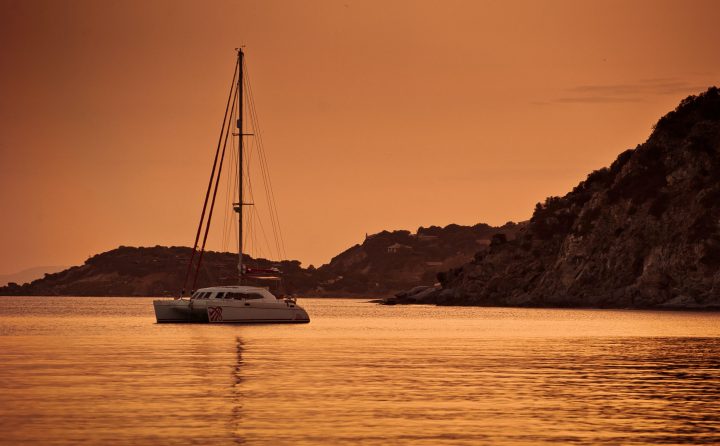
Life on Sailing Catamarans vs Life on a Monohull Vessel
At anchor, a catamaran provides superb comfort and living space. The “upstairs” cockpit and salon mean that boaters can enjoy non-stop wrap-around views. Monohull boaters are stuck in their caves and must peek out of their small portlights or climb into their cockpits to view the world.
A modern catamaran will also have swim steps that make it easy to get on and off the boat and provide easy access to dinghies and water toys.
If there’s an uncomfortable roll or swell in the anchorage, the catamaran’s stability will make the roll a bit less noticeable. Monohull boaters are more likely to be adversely impacted in a rolly anchorage. This does not mean that the cat owners are getting a perfect night’s sleep every evening, however. Catamarans just have a different motion in rocky anchorages, not a lack of motion.
Life at a dock gets a little more tricky for catamarans. Most marinas were built long before the catamaran trend and feature traditional slip sizes meant for monohulls. Marinas have to put catamarans on t-heads or make other accommodations. Therefore, it can be harder and more expensive to find a catamaran-friendly dock.
Once at a dock, the massive space of a catamaran can be harder to heat and cool efficiently. Catamarans usually need several air conditioners or heaters installed, whereas a monohull can get by with only one or two. That also means that cats might need more power (50 or 100 amp service instead of 30 amp) than some marinas can provide.
Monohulls will have fewer issues finding marinas that can accommodate them, and they pay standard rates.
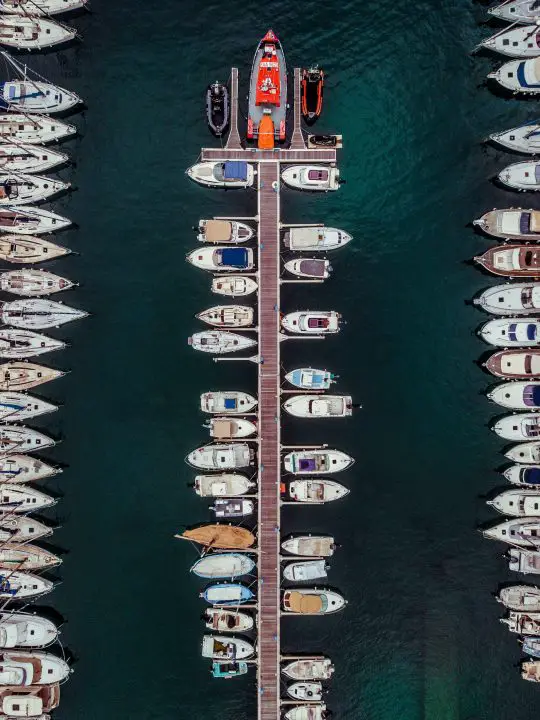
When sailing in protected waters, catamarans usually speed past their monohull friends. A catamaran provides a flat ride and sailors can move around their boats easily to make sail changes as needed. Walking on a catamaran’s deck is undemanding.
Catamaran sailors also have many options to rest comfortably underway. Because catamarans don’t heel over, catamaran sailors can sleep in their usual cabins. They can move about the interior of the boat with ease. Cooking in the galley doesn’t usually look any different underway.
In similar conditions, a monohull will heel over. Some sailors love the feeling of being heeled over and feeling the wind in their hair. Some don’t. It can be more challenging to walk the decks and work sails on a monohull vs a catamaran. While in the cockpit, monohull sailors will want to sit on one side and may even need to brace themselves to stay comfortable. For long trips, there is no doubt that living while heeled over for days at a time is exhausting.
Moving around the interior of a monohull boat at sea is also more challenging. Monohull sailors usually sleep in sea-berths with lee cloths instead of their usual quarters. It would be very uncomfortable to sleep in a v-berth underway, as the bow may be continuously pitching in seas. The lee-cloth in the sea-berth helps keep a resting sailor in their berth instead of falling onto the floor.
Monohull boats have gimbaled stoves. Even while the boat is heeled over, the galley stove will remain level. However, cooking in a monohull while underway is still more challenging than cooking in a catamaran since the cook needs to constantly brace themselves against the heel and rolling motion.
At the same time, none of this is to say that catamaran sailors have it easier at sea. In reality, catamarans may be more level, but they feel every wave in the ocean twice. The result is a choppy, bumpy ride with no rhythm. It can be just as tiring as being heeled over in a monohull.
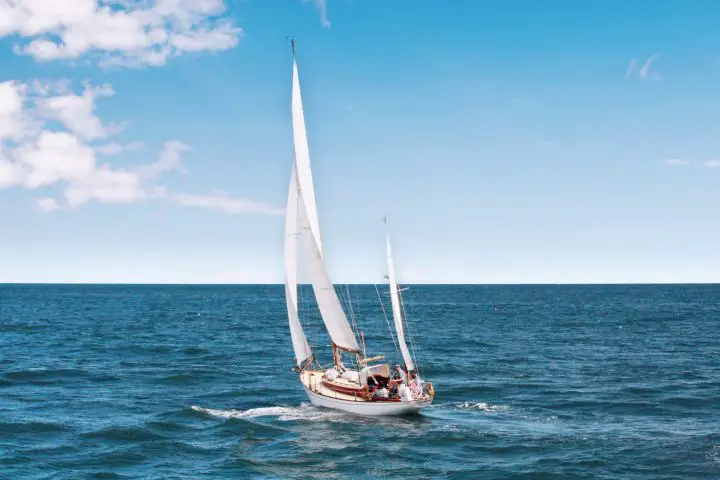
Catamaran vs Monohull Sailing Compared
Here are just a few ways that catamarans differentiate themselves from monohulls as platforms for living aboard.
- Living space—quantity and quality
- Storage space and weight
- Budget—purchase and routine maintenance
- Maintenance
- Catamaran vs Monohull for Circumnavigation
- Docking and close-quarters maneuvering
Catamarans have significantly larger and often more attractive living spaces. On the other hand, the living space on a monohull is usually small and can be dark due to small windows.
A monohull’s cockpit tends to be small and focused on safety. Families are more likely to feel in each other’s way, and moving around while others are seated can be awkward. On a catamaran, the cockpit is likely to be large and social. Catamaran cockpits have large tables and lots of lounging space in the cockpit.
Catamarans have large trampolines forward, which provides another comfortable, social lounging space that monohulls lack. Many catamarans also feature additional lounge space via the large cockpit roof.
The salon on a monohull is located in the main cabin. A monohull’s salon will be smaller than a similarly-sized catamaran. Often there is a small table, room for several people to sit, and a single sleeping berth.
Catamarans feature a wide bridge deck that crosses both hulls. This large living area features great visibility, ventilation, and natural light. On some catamarans, the galley is located on the bridge deck (called “galley up”), and on others, the galley is located in one of the hulls (called “galley down”).
Monohulls have sleeping quarters in the bow and stern of the boat. On smaller monohulls, the main sleeping area is usually a v-berth. Older, smaller monohulls usually have just one head.
On a catamaran, the sleeping quarters are located in each hull. These cabins often feature regular-sized boat beds and large en-suite heads. Cabins on a catamaran usually offer more privacy than monohulls.
Catamarans are popular with charter companies because large families or groups of friends can enjoy living on a boat together in style and comfort. Each will have a private cabin and a private head. In addition, if you want to find space to exercise, do yoga, or watersports, you’ll find these activities much easier and more comfortable on a catamaran.
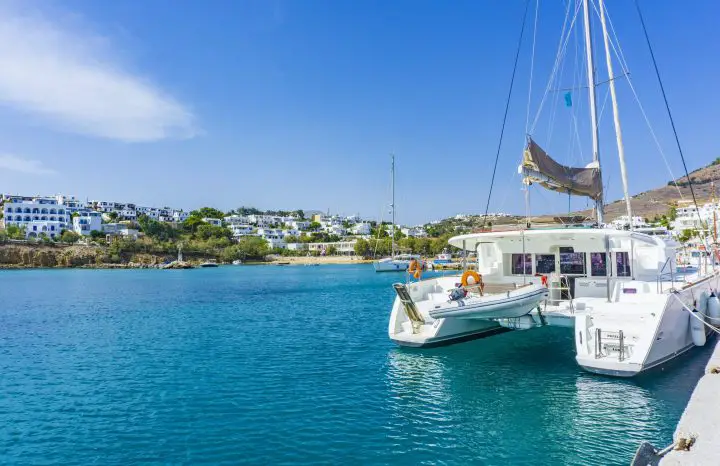
Catamarans have more space in general and certainly have more storage space. The additional deck space catamaran designs offer lends to easy storage for larger items, such as paddleboards and kayaks. Catamarans can often hoist and store larger dinghies than monohulls can. Large compartments make storage easy.
However, many catamaran owners are very cautious about storing too much. Additional weight can slow down a catamaran’s performance speeds. With so much space to put things in, it’s remarkably easy to overload a cruising catamaran. Many owners complain about the performance of smaller cats, when in reality they are often just badly overloaded.
Monohulls have less space and less storage. Finding space for big items like water toys can be challenging. But monohullers worry less about weight and freely carry around their cast iron skillet collections—because weight doesn’t impact performance on a monohull nearly as much.
This is a consideration when cruisers consider adding additional equipment. For example, a catamaran owner will have to consider the added weight of a generator and its detriment to sailing speed. In contrast, a monohull owner will have to consider finding space for the new generator.
Some prefer the motion of a monohull while sailing. Monohulls heel over but are steady, and sailors usually get used to the heeling motion. On a catamaran, if conditions are good, the boat won’t heel and will provide a comfortable ride.
When sailing upwind, some catamarans experience bridge deck slamming. Waves get caught between the two hulls and create a slamming motion and sound. It’s hard to predict the timing and strength of each slamming motion, so some catamaran sailors can find it tiresome.
The amount of bridge deck slam varies from boat to boat. Catamarans with higher bridge decks will experience less slamming, while boats with bridge decks closer to the water experience more.
Beyond that often-discussed issue, there is also the issue of the boat’s motion. It’s very difficult to imagine how different the motions are when compared to one another. The monohulls slice through the waves, usually with a predictable rhythm. A catamaran, built lightly to sail fast, feels more like it bounces over the tops of waves. The crew will feel each impact as each hull hits each wave. The result is a choppy, unpredictable motion—but it’s generally flat and level.
Monohulls have been around for ages. Therefore, sailors just starting out can find inexpensive, older monohulls. If you have a tight budget, you’ll probably start looking for a monohull.
Catamarans are newer to the market. Therefore, the initial purchase price of a catamaran is likely to be higher. Monohull buyers can often find a used, well-equipped, comfortable monohull for less than $100,000. Catamaran buyers usually spend upwards of $250,000 for a used cruising catamaran.
Because monohulls have been produced for so long, there is much more supply. The catamaran’s more modern pedigree means that there are always fewer catamarans on the market than monohulls. As more and more customers are drawn to the attractive living space and stable sailing offered by catamarans, demand keeps going up, while supply remains low.
Besides the higher up-front costs, catamarans are more expensive to keep and maintain. A monohull usually just has one engine. A monohull might have one head (bathroom) and will generally have less equipment. Monohulls have less space and storage, after all. Catamarans have twin engines, multiple heads, more hatches—more everything.
With more equipment, catamarans have higher maintenance costs. When a monohull owner services their engine, they have just one engine. A catamaran owner will need to service twin engines. Furthermore, each hull on a catamaran usually has separate and independent systems like bilge pumps, plumbing, fuel, water tanks, holding tanks…the list goes on.
A monohull owner will paint one hull bottom and wax only one hull. A catamaran owner will do everything twice. Therefore, the effort and cost of maintenance are often doubled on a catamaran.
Not only does it cost more money, it can also be harder to accomplish maintenance on a catamaran. You see, catamaran owners have fewer options to haul out. Most older boatyards have travel lifts that only accommodate boats up to 18 or 20 feet wide. Therefore, catamarans need to find a boatyard that has a large enough travel lift or a trailer to haul them. Because there is less supply and more demand for these larger travel lifts, the cost of hauling out a catamaran is often higher.
While some monohulls have lifting or swing keels and can reduce their draft, most catamarans have a shallow draft. This allows them greater flexibility while choosing anchorages. Even if a catamaran and monohull boat choose the same anchorage, the catamaran can get closer to shore and get better wind protection.
One final big difference between these two types of vessels is their ability to maneuver in tight spaces. Monohull sailboats are notoriously difficult to maneuver around docks and marinas. They often have poor visibility from the helm and difficult handling, especially in reverse. The single-engine design often requires a bow thruster, even on smaller boats.
The contrast that catamarans offer is pretty stunning. Even though they appear massive and ungainly in comparison, their twin engines mounted far outboard enable them to spin in their own length. Catamarans can be maneuvered in pretty much any direction using only differential thrust from the engines–all without a bow thruster.
Safety Considerations — Are Cruising Catamarans Safe?
Since most people have only limited experience with these vessels, many people wonder are catamarans safe. Even though they have been making large cruising cats for decades now, most of us have only really played on Hobie cats at the beach. And if there’s one thing we know about Hobie cats, it’s that they’re a lot of fun until you flip it over!
Here’s a look at a few safety considerations and how catamarans stack up against monohulls.
- Catamaran stability — capsize potential
- Hull breaches and sinking risk
- Rigging failures
- Designing for speed
- Redundancy on board
So, can you capsize a cruising catamaran? The answer is yes, no matter what the fanboys and girls say. It is technically possible but highly unlikely. Cruising cats are massive, and in all likelihood, you’re more likely to break the rigging than flip the boat. But in rough seas and extreme conditions, it does happen even on modern catamarans.
If a monohull encounters strong winds and rough weather, it will heel and roll significantly—but it will keep righting itself. In dire conditions, the vessel could suffer a knockdown. But a monohull will always right itself after a roll—it has tens of thousands of pounds of heavy keel to ensure that it does. Of course, the rig and anything on deck will sustain serious damage in the process, but the boat will be upright in the end.
In the same scenario, while unlikely, a catamaran can capsize. And the catamaran will then remain capsized, with no possibility of righting itself.
One of the scariest risks at sea is that of a serious hull breach, one that a bilge pump couldn’t keep up with. For example, a boat could be holed by an errant floating object or suffer a stuffing box or through-hull failure.
If a monohull sailboat is holed, it could sink straight to the bottom of the ocean. The crew would be left with only a liferaft and whatever they were able to recover before the sinking.
But a catamaran is filled with foam and is (more or less) unsinkable. If a catamaran experienced a hull breach or capsizes, it would take on water and may become less habitable. However, it will still float. In many cases, not much of the boat is left above the water—but it’s still at the top of the water.
Boaters may be able to perform emergency repairs and get the boat to port themselves. Or, they may have to stay with their vessel until help arrives. In either scenario, the crew maintains access to supplies and can stay with a much larger vessel, increasing the likelihood of being found and rescued.
Some catamaran sailors are so certain of their vessels floating in all scenarios that they don’t even carry a liferaft aboard. This is fool-hearty, to say the least, given the crazy and unpredictable things that can happen to any boat on the ocean. But one scenario is equally scary for the monohull or the catamaran sailor and should convince everyone that any offshore vessel should have a liferaft—the possibility of an uncontrollable fire.
Rigging Safety
When wind speed increases, a monohull will heel over. This heeling motion sheds the excess power of the wind. Monohull boaters should pay attention to the weather and reduce sail to ensure they aren’t overpowering the boat. This is why knowing how to reef a sail is so important for all sailors.
However, on a catamaran, the sails and rigging take the increased load when wind speed increases. Catamarans don’t heel, and therefore, don’t shed excess power. If the weather becomes gusty and a catamaran has too much sail up, all that extra power is transferred to the sails and rigging.
This can cause a dangerous situation. For example, there have been reports of catamarans being de-masted in sudden gusts of wind. In a worst-case scenario, a catamaran could capsize if they are over-canvassed when experiencing extreme wind conditions.
Most monohulls have strong standing rigging. The forestay is connected to a solid structure, the hull. This means that the forestay has a strong, stable platform and gives a monohull better upwind performance. Monohulls also usually have backstays, which provide rigging redundancy.
On a catamaran, the forestay is attached to a crossbeam. Because the platform is not as rigid as a monohull’s hull, the forestay is not as strong. In addition, catamarans usually don’t have backstays, and therefore have less rigging redundancy.
The configuration of the rigging is another rigging consideration. On a monohull, the spreaders and shrouds are perpendicular to the mast. Most catamarans come with fractional rigs that don’t have backstays, and their shrouds are set far back. Because of this configuration, catamaran sailors can’t let their mainsails out all the way on a downwind run because the shrouds are in the way. This leads to less efficient sail shapes when sailing downwind.
However, catamaran sailors can rig their sails to sail wing-on-wing. While monohull sailors can also use this configuration with the help of a whisker pole, catamaran sailors have a nice, wide, stable platform to fly large downwind sails.
There’s no doubt about it–catamarans sail faster. Most articles and comparisons state that catamarans are about 20% faster than a similarly sized monohull. Catamarans have a lower wetted surface area and less drag than monohulls. They’re especially nice to sail in light winds, conditions that heavy cruising monohulls tend to not do well in.
While most cruising cats can’t sail upwind as high as monohulls can, they still win the race. However, if a catamaran has daggerboards and a good sail inventory, it can point as well as a monohull.
Many boat owners believe that speed equals safety, as you might be able to outrun an impending storm. That’s a debatable strategy since weather systems often move faster than any cruising boat can move. It has a lot more to do with planning and the decisions made by the skipper, in the end.
Furthermore, more speed means a rougher ride. A heavy, full-keeled monohull might not move very fast, but the sea-kindly and forgiving ride means a more comfortable and better-rested crew. This only goes to illustrate that the “more speed” argument is far more of a personal preference than many sailors admit—especially when it comes to long-distance cruising.
A faster boat provides a skipper with more options, but it does not ultimately equal inherent safety. That will always come down to the skipper and the crew, and the choices they make. A slow boat in the hands of an experienced and careful crew will always be safer than a fast racer under the command of an inexperienced and green crew. In other words, there is no replacement for seamanship and careful planning.
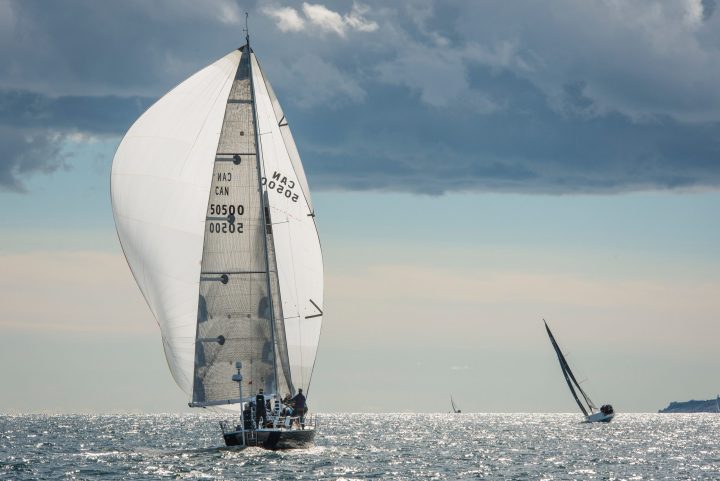
Catamarans have two of everything. While this does equal double the cost and maintenance, it also provides redundancy. If a monohull’s single engine dies and there is no wind, they may have to call for a tow or wait for wind. If a catamaran’s left engine dies, sailors can just continue on the right engine.
Twenty years ago, the majority of boats completing circumnavigations were classic bluewater monohulls. Monohulls are considered safe and capable circumnavigators.
But today, catamarans are establishing themselves as the more desirable choice for many circumnavigators. Catamarans are fast, stable, and capable of crossing oceans. In addition, catamarans can carry significant supplies and offer redundancies. Plus, the extra space that catamarans provide also means that the crew will enjoy watersports like diving, paddle boarding, and surfing.
Since nearly all traditional routes are downwind “milk runs,” catamarans naturally excel along the way. If you take a look at the competing boats for the World ARC rally for the last few years, a definite trend is growing. More catamarans compete every year. Common entrants include Lagoon 450s and Antares 44s.
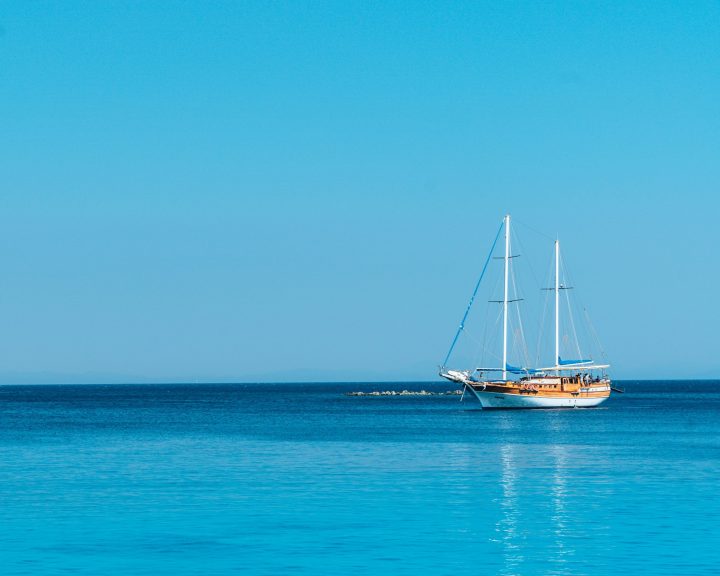
One of the most significant decision points when thinking about catamarans versus monohulls is your budget. If your budget is under $100,000, a monohull will be your best bet. If your budget is between $100,000 and $250,000, you can consider a smaller, older catamaran. Catamarans such as PDQs, Prouts, and Geminis will be in your budget. If you have a budget of over $250,000 and can afford higher dockage and maintenance costs, you can consider a catamaran.
Next, consider your comfort level. To try it out, you might want to charter both a monohull and a catamaran. Check out a sailing vacation in the BVI or with a company like Cruise Abaco. Taking classes at our local sailing school might also be helpful. https://cruiseabaco.com
Many folks are attracted to the larger, more comfortable spaces of a catamaran. However, some people feel more seasick on a catamaran and can’t get used to the motion. So a lot of your decision will come down to personal preference.
If you can’t imagine squeezing into a darker, smaller cabin in a monohull, then a catamaran might be calling your name. On the other hand, if you are a traditionalist who loves heeling and boats with a lot of teak, a monohull might be your dream boat. It’s just impossible to know how a boat will make you feel until you’ve experienced both.
Boaters often discuss the compromises involved in boat choices. Whether you choose a monohull or a catamaran, there will be some compromises involved. However, no matter which boat you choose, you can enjoy smooth sailing, beautiful anchorages, and some adventure along the way.
Worried about getting caught in severe storm conditions in your boat ? Visit our guide!
Which is better monohull or catamaran?
Both monohulls and catamarans are popular choices for cruising sailors. Which one is better depends entirely on your personal preferences and which boat is more comfortable and appealing to you. If you are on a tight budget, a monohull is your best choice. On the other hand, if you love large open living spaces, a catamaran will be the better option.
Which is safer catamaran or monohull?
When wondering are catamarans safe, always remember that the primary determinant of the safety of a vessel is its captain, not the vessel itself. Both monohull sailboats and cruising cats have important limitations that their skippers must know and abide by.
Some consider catamarans safer because they are virtually unsinkable. If it has a hull breach or capsizes, it will still float.
Others see the sea-kindly monohull to be the safer bet, as they are better designed to protect their crews from the elements in severe weather. They also cannot capsize, as their ballast provides a righting moment in all conditions. But on the other hand, if a monohull experiences a hull breach, it can sink.
Can catamarans handle rough seas?
Modern cruising catamarans are built strong enough to cross oceans and survive in all kinds of conditions. It might be an uncomfortable ride, but not an unsafe ride. In the end, it is the skipper of the boat who ensures its safety at sea. Good seamanship makes a far bigger difference in how a boat handles rough seas than the design of the boat does.
In extreme conditions, such as hurricanes or sudden gusty winds, catamarans can capsize. Once a catamaran has capsized, it won’t right itself. However, it will still float, although upside down. Heavy seas are more likely to cause maintenance and chafing issues on both catamarans and monohulls.
Matt has been boating around Florida for over 25 years in everything from small powerboats to large cruising catamarans. He currently lives aboard a 38-foot Cabo Rico sailboat with his wife Lucy and adventure dog Chelsea. Together, they cruise between winters in The Bahamas and summers in the Chesapeake Bay.

Monohulls vs. Catamarans: Which One is Best for You?
If you’re considering purchasing a sailboat, you might be wondering which type of vessel is best suited for your seafaring adventures. Fear not, for we’re here to help you weigh the differences between monohulls vs. catamarans to make an informed decision.
Now, before we dive into the nitty-gritty details of hull design, sail handling, and the like, let’s take a moment to appreciate the quirky personalities of these two boats. Sloop rigged monohulls are the classic, old-school sailboats with a single mast and a triangular sail. They’re like the wise old grandpa who’s been sailing the seas for decades and has plenty of stories to tell. On the other hand, catamarans are the younger, hipper cousins of the boating world. With their twin hulls and sleek designs, they’re like the trendy millennials who are always up for an adventure.
But enough with the stereotypes, let’s get down to business. In this article, we’ll explore the pros and cons of monohulls and catamarans across various factors such as stability, maneuverability, accommodations, and cost. By the end of it, you’ll have a better idea of which boat is best suited for your sailing style and preferences. So, hoist the anchor and let’s set sail!
What are classic monohulls?
Let’s start with the basics – what exactly are classic monohulls? Well, sloops. To put it simply, a sloop is a type of sailboat with a single mast and a fore-and-aft rigged mainsail. But there’s more to these boats than meets the eye.
Sloops are the OGs of the sailing world, tracing their roots back to the 17th century. They were the go-to boats for explorers, pirates, and adventurers alike, with their simple yet effective design making them perfect for long journeys at sea. Nowadays, they’re still a popular choice for sailing enthusiasts who appreciate the classic, traditional look and feel of a sloop.
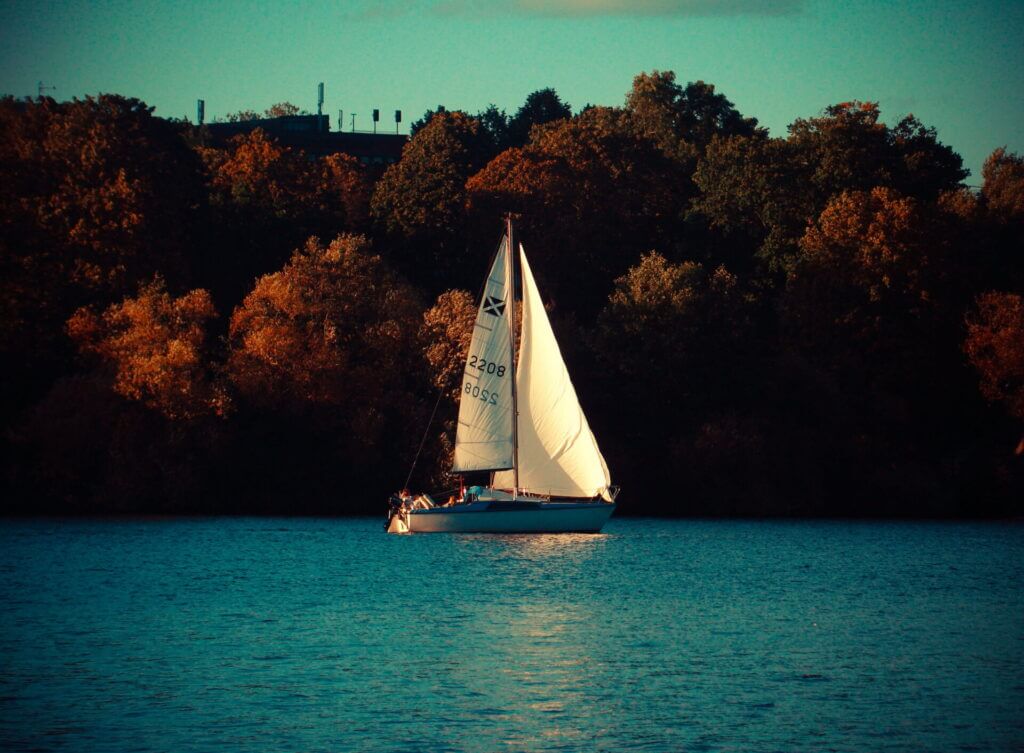
One of the defining characteristics of a sloop is its versatility. They come in a range of sizes, from small day sailers to larger offshore cruisers, and can be easily handled by a single sailor. Their rigging is relatively simple, making them a great option for beginners or those who prefer a less complicated sailing experience. But don’t let their simplicity fool you – sloops can pack a punch when it comes to speed and performance upwind.
Of course, there are some downsides to monohulls as well. Due to their single-hull design, they can be less stable in high winds or rough seas. They also tend to have less living space below deck compared to their bigger brothers. But if you’re looking for a classic, reliable, and versatile sailboat, a monohull might just be the vessel for you.
What are catamarans?
Now let’s talk about the other contender in this seafaring showdown – catamarans. These boats are a bit like the cool kids in high school – they’re sleek, modern, and always turning heads.
So, what exactly are catamarans? Well, to put it simply, they’re boats with twin hulls that are connected by a platform. But don’t let their basic design fool you – these boats are anything but ordinary. Catamarans come in a range of sizes, from small day boats to luxurious yachts, and offer a unique sailing experience that’s hard to beat.
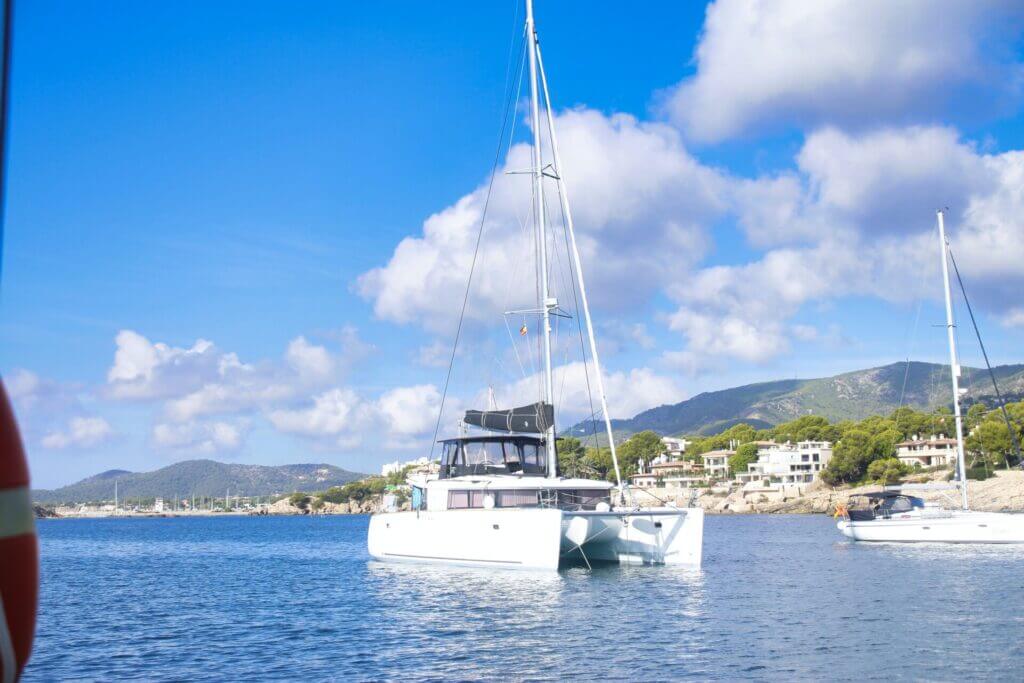
One of the biggest advantages of catamarans is their stability. With two hulls instead of one, they’re less likely to tip over or roll in rough waters. This makes them a popular choice for families or those who prefer a smoother sailing experience. They also have more living space above and below deck compared to monohulls, with spacious cabins, lounges, and kitchens that are perfect for extended trips.
But let’s not forget about performance – catamarans are no slouches when it comes to speed and agility. Their twin hulls create less drag in the water, allowing them to glide through the waves with ease. And with their sleek, aerodynamic designs, they can often outpace traditional monohull boats.
Of course, catamarans do have their downsides as well. They can be more complicated to handle compared to monohulls, and require more space to in marinas or docks. They also tend to be more expensive than other types of sailboats, but hey, you can’t put a price on luxury.
Hull design
Per definition, the hull design is the biggest differences between monohulls and catamarans.
Let’s start with monohulls. These boats typically have a single hull that’s shaped like a long, narrow tube. This design allows them to slice through the water with ease, making them great for speed and agility. The hull is usually rounded or V-shaped at the bow, which helps to cut through waves and reduce drag. At the stern, the hull flares out to create a wider, more stable base.
Now, onto catamarans. These boats have two hulls that are connected by a platform, giving them a unique look and feel. The hulls are usually wider and flatter than those of monohulls, which provides a greater amount of stability. This can be especially beneficial for those who are prone to seasickness or prefer a smoother sailing experience. The flat shape of the hulls also creates less drag in the water, allowing for higher speeds and better maneuverability.
When it comes to sailboats, stability is crucial for a comfortable and safe journey on the high seas. So, which type of boat – monohulls or catamarans – reigns supreme in this category?
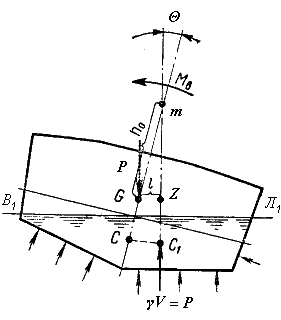
Well, let’s start with monohulls. These boats have a single hull, which means that their stability comes from the shape and weight distribution of the hull. Generally speaking, monohulls tend to be less stable than catamarans, especially in rough waters. This is because the single hull has to work harder to maintain balance, and can be more prone to tipping or rolling.
With two hulls connected by a platform, catamarans are the kings and queens of stability. The twin hulls provide a wider base and more buoyancy, making them less likely to tip over or roll in rough conditions. This can be especially beneficial for those who are new to sailing or prone to seasickness.
Maneuverability
Let’s talk about maneuverability – the art of smoothly navigating your vessel through the choppy waters. When it comes to monohulls vs. catamarans, the level of maneuverability can vary depending on the design and size of the boat.
Starting with monohulls, these boats are typically designed for speed and agility, which can translate to better maneuverability in certain situations. Their narrow hulls and single keels allow them to slice through the water and make quick turns, which can be useful in tight spots or when navigating through busy marinas.
Now, onto catamarans. With two hulls and a wider beam, these boats can be more challenging to maneuver in tight spaces. However, they do have some tricks up their sleeves. For example, many catamarans have engines that can rotate 360 degrees, allowing for greater control and maneuverability in tight spots.
Of course, when it comes to maneuverability, the skill and experience of the captain also plays a big role. A skilled sailor can make even the most unwieldy vessel dance through the water with ease, while a novice may struggle with even the most nimble of boats.
So, whether you’re piloting a monohull or a catamaran, it’s important to keep your wits about you and stay alert to your surroundings. And if all else fails, just remember the time-honored sailor’s adage – “When in doubt, let it out!”
Accommodations
Starting with monohulls, these boats typically have a more compact interior layout, with limited headroom and sleeping quarters. However, this can be a trade-off for a sleeker and more agile vessel that can slice through the waves with ease. Plus, with some creative packing and organization, a monohull can provide all the basic amenities you need for a comfortable voyage.
With their wider beam and spacious design, catamarans offer more room for living and sleeping quarters, as well as additional amenities like a galley kitchen and a bathroom. This can make for a more luxurious and comfortable sailing experience, especially for longer voyages. In addition, the two-hull design offers more space on deck for dinner parties or sunbathing in the trampolines

Of course, when it comes to accommodations, everyone’s preferences are different. Some sailors may prefer the cozy intimacy of a monohull, while others crave the roominess and luxury of a catamaran. It all depends on your personal style and needs as a sailor.
Performance
Let’s delve into the topic of performance, which is a critical factor when selecting a sailing vessel. Each sailor may have a different perspective on what constitutes optimal performance, but generally speaking, it comes down to speed and efficiency.
When it comes to speed, catamarans have an advantage in downwind performance. Their wider beam and twin hulls give them more sail area and a greater ability to surf down waves, resulting in faster speeds. However, monohulls are often faster when sailing upwind, as their pointed hull allows them to sail closer to the wind.
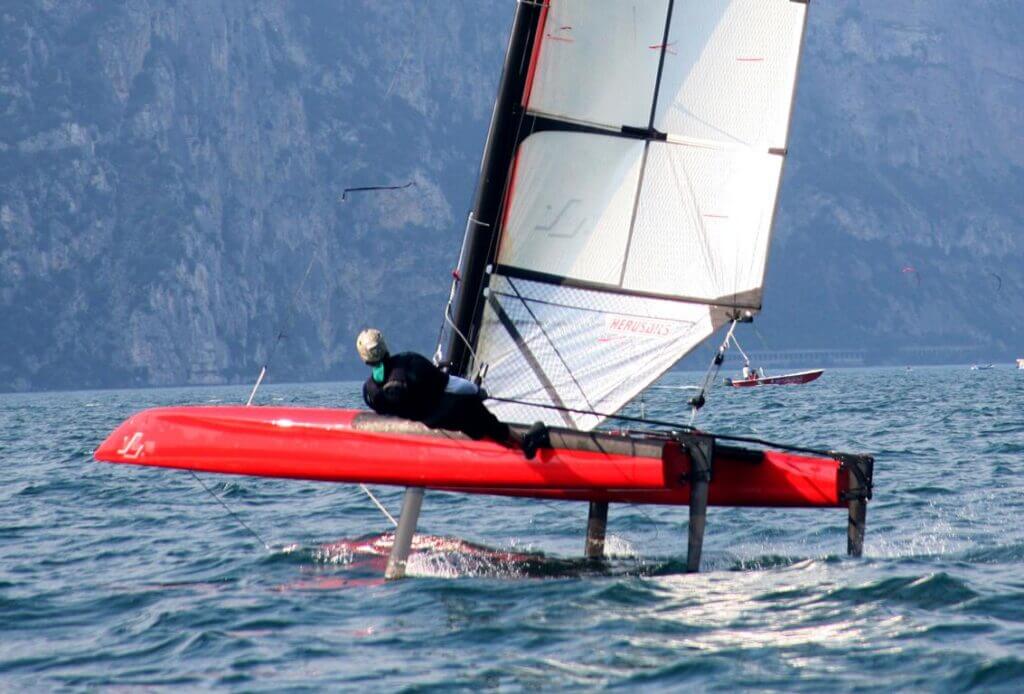
The upwind angle is an important consideration for sailors, as it affects how close to the wind they can sail. sloop rigged monohulls are known for their ability to sail at a higher angle upwind, which can be a major advantage when sailing in areas with narrow passages or limited space to maneuver. Catamarans, on the other hand, may need to tack more frequently in order to reach their destination when sailing upwind.
Maintenance
When it comes to sailing, we all know that proper maintenance is key to keeping your vessel in tip-top shape. So, when it comes to choosing between a monohull vs. a catamaran, it’s important to consider the maintenance requirements for each type of vessel.
Monohulls generally have simpler systems and structures, which can make maintenance a bit easier and more straightforward. However, the tradeoff is that they may require more frequent maintenance and repairs due to their smaller size and simpler design.
Catamarans, on the other hand, can be more complex and may require more maintenance in terms of their twin hulls, rigging, and systems. However many important systems like engines, bathrooms, or water tanks are in both hulls which give you redundancy and options. Also, their larger size can make accessing and maintaining these components a bit easier.
Regardless of which type of vessel you choose, regular maintenance is a must. From checking and maintaining the sails and rigging to ensuring the engines and electrical systems are in good working order, taking care of your vessel will ensure that you’re able to sail safely and confidently.
When it comes to the cost of a sailing vessel, there are many factors to consider. Let’s take a closer look at how monohulls vs. catamarans stack up.
First off, monohulls are generally considered to be more affordable than catamarans, both in terms of the initial purchase price and ongoing maintenance costs. This is due in part to their simpler design and smaller size, which requires less materials and labor to build and maintain.
On the other hand, catamarans can be quite costly to purchase and maintain, especially if you opt for a larger or more luxurious model. The wider beam and heavier construction of a catamaran can also mean higher slip fees and storage costs at marinas. But don’t let that deter you! If you have the means and the desire for a more spacious and comfortable sailing experience, a catamaran might be worth the investment.
Of course, the cost of a sailing vessel is just one piece of the puzzle. You’ll also need to consider other expenses like fuel, insurance, and ongoing maintenance and repairs. And let’s not forget the most important cost of all: the cost of living your best life on the open sea!

So weigh your options carefully, and remember that the true value of a sailing vessel goes far beyond the price tag. May the winds of fortune guide you to the vessel of your dreams, and may you sail with joy and a full wallet!
Resale value
Resale value is an important consideration when it comes to buying any type of vessel, and monohulls and catamarans are no exception. Generally speaking, catamarans tend to hold their value better than monohulls due to their popularity among sailors and their reputation for being spacious and comfortable. However, resale value can also depend on the specific make and model of the boat, as well as its age, condition, and location.
Of course, there are always exceptions to the rule. Some monohulls may have a cult following and fetch a higher price on the resale market, while some older catamarans may not hold their value as well as their newer counterparts. Additionally, factors such as maintenance, upgrades, and customization can also affect resale value.
In conclusion, when it comes to monohulls vs catamarans, there is no one-size-fits-all answer. Each boat has its own advantages and disadvantages, and the decision ultimately depends on your personal preferences, needs, and sailing goals. If you have the money, looking for a faster ride downwind and don’t mind sacrificing a bit of upwind performance, a catamaran might be the way to go.
Resale Value
On the other hand, if you want something cheaper, prioritize sailing close to the wind and want a boat that is more easily handled in a variety of conditions, a sloop rigged monohull might be the better choice. Of course, other factors such as accommodations, and maintenance also play a crucial role in the decision-making process.
So whether you prefer the sleekness of a monohull or the stability of a catamaran, make sure to consider all the options and weigh the pros and cons carefully before making your final choice. And as with any big decision, it never hurts to consult with experienced sailors, boat dealers, or brokers to get their expert opinions. Happy sailing!
Similar Posts
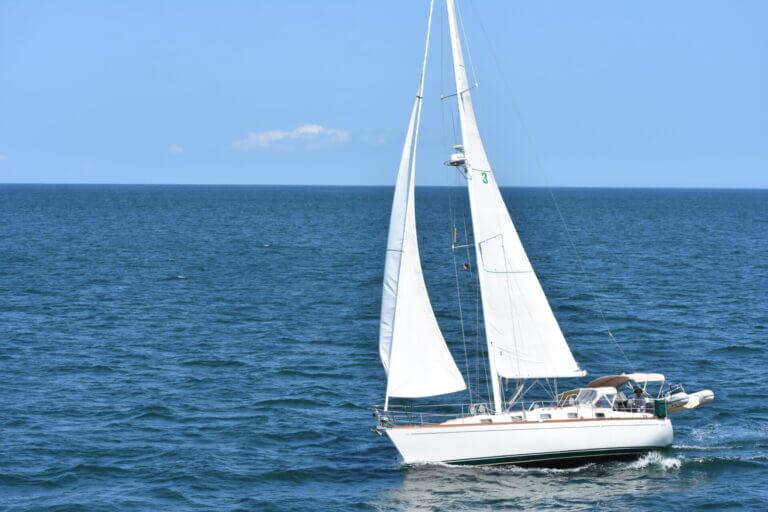
What is a Sloop? Definition, Types and History
A sloop is a type of sailboat that has a single mast and a fore-and-aft rig. Sloops are a type of sailboat that has been around for centuries. They are known for their versatility and ease of handling, making them popular among sailors of all skill levels. Sloops have a single mast and a fore-and-aft…

Basic Sailing Terminology: Sailboat Parts Explained
Sailing is a timeless activity that has captivated the hearts of adventurous souls for centuries. But, let’s face it, for beginners, sailing can be as intimidating as trying to navigate through a dark, labyrinthine maze with a blindfold on. The vast array of sailing terminology, sailboat parts and jargon can seem like a foreign language…
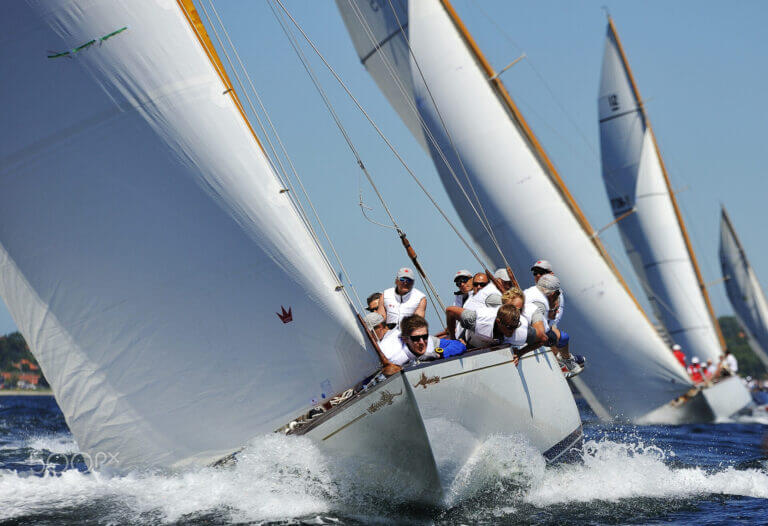
How Much Does Biofouling Slows Down your Boat?
Are you wondering how much biofouling can impact the performance of your sailboat? The amount of how much biofouling slows down a sailboat depends on various factors, such as the type of boat, its size, and the severity of the biofouling. On average, a sailboat with a heavily fouled hull can experience a reduction in…

How do Boats Float? Exploring the Science Behind Buoyancy
Sailboats float because the average density of the boat is less than the density of water. When boats displace as much water as it weights, this is known as the buoyancy force generated by Archimedes’ principle. If you’ve ever wondered how do boats float and therefor enable us to embark on thrilling water adventures, you’ve…
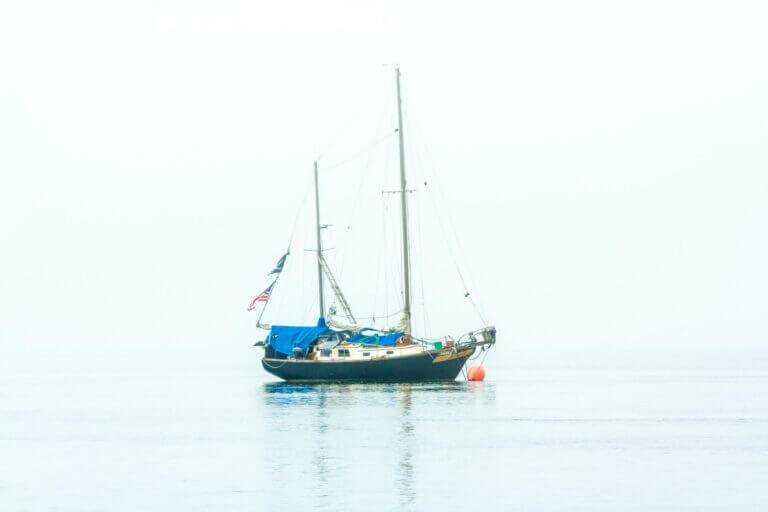
What is a Ketch Sailboat?
Ketch boats are frequently seen in certain regions and offer various advantages in terms of handling. However, what is a ketch and how does it stand out? A ketch is a sailboat with two masts. The mainmast is shorter than the mast on a sloop, and the mizzenmast aft is shorter than the mainmast. Ketches…
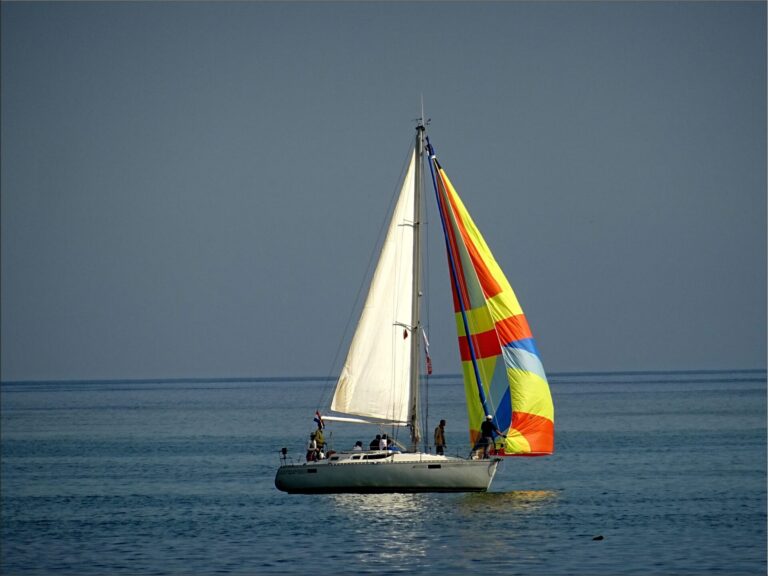
Types of Sails: A Comprehensive Guide
In the enchanting world of sailboat dynamics, where the dance between wind and water takes center stage, the significance of sails cannot be overstated. Like the wings of a bird, these meticulously crafted sails unfurl to catch the slightest whisper of breeze, converting it into a powerful forward thrust that carries us through the vast…
- Articles and Guides
Catamaran vs Monohull: The Great Sailboat Debate
16th jun 2023 by john burnham.

Do you love the natural sounds of water sliding past the boat’s hull and a breeze blowing across your rigging and sails while gliding ahead powered only by the force of the wind? If yes, you are well-suited to spending plenty of time on a sailboat, like so many generations of boat people before you.
But do you take your lead from the Egyptians who rigged sails on their boats built of reeds along the Nile River or follow the path of the Polynesians, who used an outrigger for extra stability and sailed from one Pacific island to the next in the earliest catamarans?
The question of which is better for sailing, one hull or two, has been a matter of debate over thousands of years. Today, let’s explore these two basic types of sailboat, and while we may not settle the argument once and for all, hopefully in the process you will begin to discover which option is better for you.
What Are the Differences Between Catamaran and Monohull Boats?
The monohull and the catamaran (often referred to as “cat”) are the two most common categories of sailboats, and of the two, the monohull far outnumbers the catamaran in popularity due to its simplicity and sturdiness. Advocates of the catamaran, however, are typically even more convinced than monohull sailors that their boats are best due to performance potential and overall spaciousness.
What are catamaran-style boats?
Catamarans are easily identified by their two-hull design. Two hulls sit side by side with an interconnecting deck or structural beams across the bap in the middle. Catamarans have been around since Pacific Islanders and other Austronesian people sailed them centuries ago, and they continue to gain popularity in a wide range of designs both as high-performance racing boats and ocean-cruising designs.
Although not part of this debate, a third sailboat type comparable to a catamaran is a trimaran. Trimaran sailboats are constructed similarly to catamarans but have three parallel hulls rather than two. Collectively, catamarans and trimarans are referred to as multihulls, and sailors of both types often refer lightheartedly to monohulls as “monomarans.”
What are monohull-style boats?
Monohull sailboats are the most common boat type because they feature a single hull, typically with a single mast and two sails. Rather than maintaining stability with a second hull creating a wider beam, monohull boats usually carry lead or other heavy ballast in their keel, or are stabilized by human weight as their crews lean out to counter the force of the wind. Monohulls can also be excellent racers and cruisers, depending on their size, volume, sail area, and displacement or weight.
Where Catamarans and Monohulls Excel
Each type of boat has its advantages, depending on what the owner wants in a boat. Here are the main advantages of each type.
Catamaran advantages
• More space . Catamarans have greater beam for a given length, which provides more space for the crew on a daysailer and larger living quarters on cruising designs, which are often laid out with berths in each hull and living quarters across the bridgedeck between hulls.
• Faster hull . If they are light enough, the sleeker shape and reduced wetted surface of two narrow, shallow hulls can produce quicker straight-line sailing speed than a single, deeper and wider hull.
• Comfort and stability . Two hulls provide better initial stability and generally heel less than monohulls, especially in light- or medium-strength winds and waves.
Monohull advantages
• Upwind sailing . When sailing against the wind, monohulls often sail at a closer angle to the wind and arrive more quickly at their destination.
• Easier motion . Heavier monohulls often have a slower, gentler motion in waves than a lighter catamaran.
• Load carrying capability . A monohull’s performance is reduced less than a catamaran’s when the boat is loaded heavily with cargo or crew.
• Righting characteristics . Larger monohulls have weighted keels that provide increased resistance to a capsize when the boat is heeled far over by wind or a wave and if capsized will return the boat to an upright position.

Catamaran vs. Monohull Sailing Speed
There are several reasons why a catamaran is often faster than a monohull boat. These include the fact that most catamaran hulls have less water resistance than monohulls, they are often lighter, and they can be more easily driven by a relatively small sailplan. At similar lengths, a catamaran can be dramatically faster than a monohull under similar sea conditions. However, weight is the enemy of a catamaran’s speed; a heavy or heavily loaded catamaran may be much slower than a lightweight monohull.
Catamaran vs. monohull power
A monohull under auxiliary power may be faster than a catamaran in certain conditions, like powering against a strong wind. In other wind and wave conditions, the catamaran is often faster. Also, with an engines on each hull, the cat is often much more maneuverable in close quarters or at the marina. While it may seem counter-intuitive, turning and controlling the boat is often less challenging than when sailing a monohull boat with the typical single engine. Monohull boats require more finesse when in tight quarters like berthing in a marina.
Catamaran vs. Monohull Efficiency
A sleek monohull may sail against the wind super efficiently, pointing close to the wind and making an excellent speed. However, the power-to-weight ratio of the catamaran allows it to make good use of whatever wind it has. Some fast, light catamarans can travel at speeds equal to or faster than the wind, something very few monohulls can achieve. When the wave action increases and you start sailing into the wind, the catamaran may lose its advantage, and in strong winds, the greater windage of the wide catamaran may have a pronounced slow-down effect compared to the sleeker monohull.
Catamaran vs. Monohull Stability
Despite not having a weighted keel, a catamaran design is able to avoid heeling over in strong winds or bad weather due to its greater width or beam. As a result, the multihull also tends to be more stable at anchor and any time in calmer seas. However, if the winds are strong and the waves are large, a monohull, with its keel weight and ability to sail against the wind while controlling the sails, is sometimes the steadier of the two types. While a monohull with weighted keel can be knocked down by strong gusts of wind, it will only capsize in extremely large waves. Likewise, a cruising catamaran can only capsize in large ocean waves, unless it is a fast, lightweight catamaran, that can more easily tip over in gusty winds and waves.
Catamaran vs. Monohull Safety
Power catamarans and power monohulls are relatively comparable in terms of safety. But depending on the size of the mast and sails, the weight of the boat, and the wind and wave conditions experienced, many sailors believe that a monohull configuration is safer than a catamaran for a sailboat. That’s mainly because while a monohull will initially heel over further in a strong gust of wind, the weight of its keel provides increasing stability as described above and if completely capsized, the keel typically helps the boat self rescue.
It should be clarified that many sailing catamaran designs are conservatively configured and difficult to capsize except in extreme ocean wave conditions—and the same can be said for larger power catamarans.
In terms of ultimate safety in the event of a capsize, however, the catamaran is considered safer because even should it turn once upside down, even if damaged, the catamaran with its two hulls and minimal ballast typically remains buoyant and provides a safer configuration in which to await rescue. By contrast, if a monohull’s hatches and port windows suffer damage in a knockdown, the boat can more quickly take on water and, weighed down by its keel or other ballast, be more difficult to keep afloat in extreme conditions.
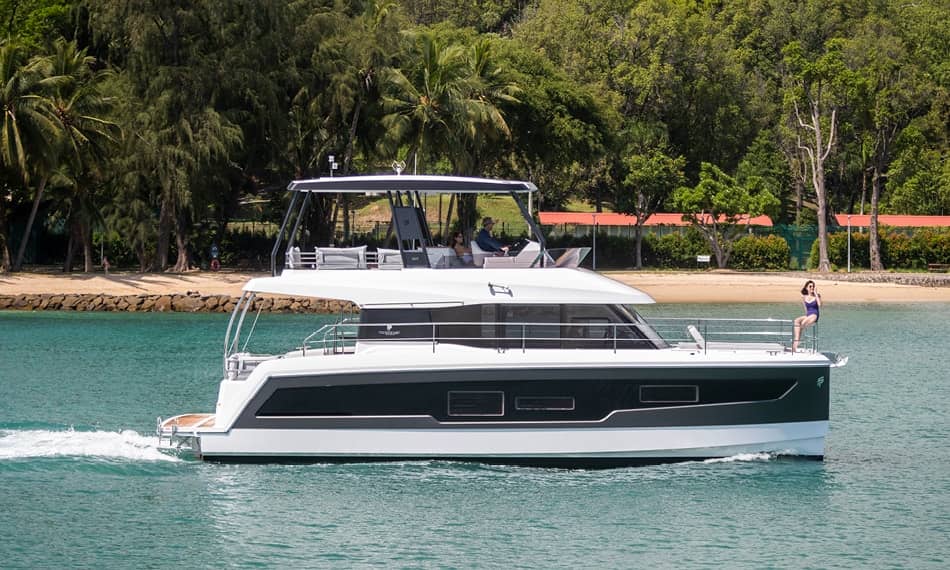
Photo credit: Fountaine Pajot
Monohull vs. Catamaran Maintenance
Depending on size, age, and type of hull construction, maintenance costs will vary, but when comparing two fiberglass sailboats of similar length, the catamaran typically costs more to maintain. That’s because there are two hulls to care for, two engines, connecting structures that align the two hulls, and an overall larger boat due to the catamaran’s greater beam. Hauling and launching a catamaran can be more expensive at many boatyards, as well.
However, smaller catamarans of about 20 feet in length or less are often more comparable and sometimes cheaper to maintain than a similar length monohull. That’s because cats are often lighter and suitable for keeping on a trailer rather than in a slip or on a mooring.
Catamaran vs. Monohull Cost
Compared to similar length monohulls, a catamaran will likely cost more than a monohull boat. That’s mainly because when you purchase a 40-foot catamaran, you are buying two hulls and two engines, but you are also buying a bigger boat that typically has much more volume. In the case of a 40-footer, you end up with a boat that has a large saloon and three or four private cabins, whereas in the monohull, the saloon is smaller and you’ll have three smaller sleeping cabins. Annual maintenance will also be greater, as described above.
Among smaller catamarans and monohulls, pricing will vary, and a lightweight beach cat may be less expensive than a heavier monohull keelboat of similar length.
Catamaran vs. Monohull, Pros and Cons
Depending on a variety of factors, there are plenty of catamaran and monohull pros and cons. These are some to keep in mind when comparing the two boat types.
Catamaran pros
• Comfort . On a cruising designed catamaran, two hulls with a wide beam create a stable and comfortable living environment with open spaces and plenty of standing room.
• Speed . Smaller, lighter catamarans are speed champions, especially in a moderate wind and modest waves. Cruising cats are often fast when sailing at reaching angles.
• Maneuverability . When equipped with two engines, a catamaran is highly maneuverable under power.

Monohull pros
• Upwind sailing . Although catamarans are often faster when sailing in a straight line, monohulls typically perform better against the wind.
• Self-righting . Except for unballasted monohulls that rely on crew weight for stability, the ballasted keel of a monohull prevents capsizing in most circumstances and the keel makes the boat self-righting.
• Maneuvering under sail . Monohulls turn more easily due to their shape, maneuvering in close quarters or tacking when sailing against the wind.
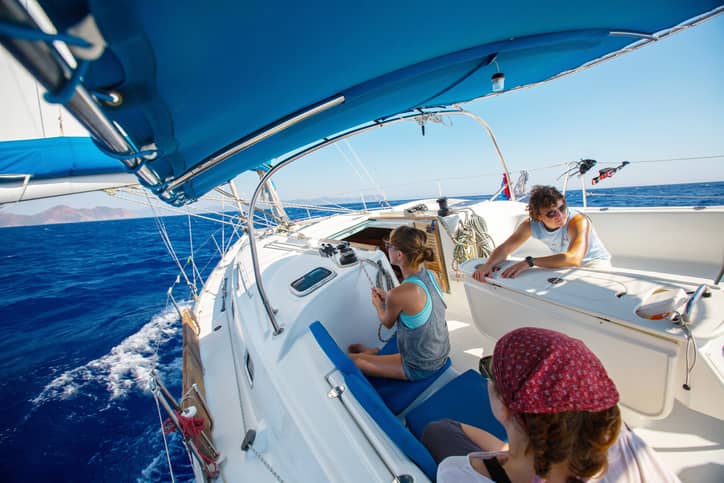
Catamaran cons
• Lack of feel when steering . Except in lighter, more performance-oriented catamarans, the broad platform with two rudders and two hulls sometimes isolates the sailor and provides little feedback through the helm when under sail.
• Sailing against the wind . Upwind sailing is generally not a catamaran’s best point of sail, but its straight-line speed can be such that it may arrive quickly at its destination, even though you will have traveled much farther than in a monohull.
• Pricing . Catamarans are typically more expensive than monohull boats due to their two hulls and other required build components and complexity.
• Not self-righting . Thanks to its wide beam and two-hull design, a catamaran is more difficult to flip, but it is not designed to right itself except for small beach cats where the crew can use their weight to re-right the boat.
Monohull cons
• Weight . Most monohulls have thousands of pounds of weight in the keel for ballast that is vital to its stability but can degrade performance.
• Wave motions . Monohull boats are much more susceptible to rolling wave motions.
• Cabin . With the monohull cruising design, you'll typically find a darker interior with smaller port windows and fewer space options.
• Heeling effect . Monohulls will heel over in a moderate wind, which is normal but often uncomfortable for newer sailors.
Written By: John Burnham
John Burnham is a marine editor and writer with decades of journalism experience as Chief Editor of boats.com, Sailing World, Cruising World, and other boating websites. As a competitive sailor, he has led teams to world and national titles in the International One-Design, Shields, and other classes. Based in Newport, Rhode Island, John is a PCC leadership coach, a member of the America’s Cup Hall of Fame Selection Committee, and a past board member of Sail America and US Sailing. For more, see johnsburnham.com .

More from: John Burnham
Related Articles and Guides
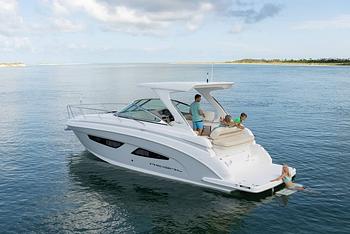
6th Sep 2024
The Best Mini Yacht Brands for Cruising and Luxury
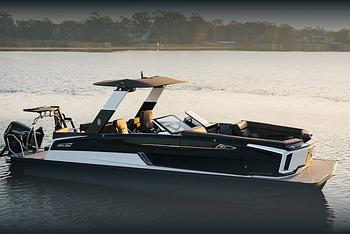
16th Aug 2024
Best Luxury Pontoon Boat Brands Have it All: Glamor, Speed, Fishing, Waterslides...
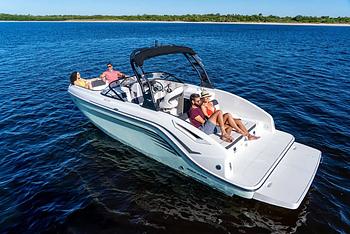
10th Aug 2024
Deck Boat vs. Bowrider: Which Runabout is Best?

19th Jul 2024
The World’s Best Yacht Brands

- Explore Rightboat
- Boats for Sale
- Boating Articles
- Buyers Guide
- About RightBoat
- Sell Your Boat
- Boat Selling Advice
- All manufacturers
- All categories
- Are you a broker/dealer?
- Learn more about the Rightboat:HUB
Enter your email to keep up to date with the latest news
Join for free
Sign up now for free and discover how easy it is to keep up to date with THE latest boats for sale. Find your right boat, and tailor your voyage to finding your next boat.
Benefits of becoming a member:
- Set up tailored alerts
- Personalise your experience
- Download full specifications and broker details
- Keep tabs on your favourite boats
Are you a broker? Join as a Broker
Rightboat - join for free.
Do you have an account already? Login
Save this search
Save your search and receive new boats in your email..
You can unsubscribe from your alerts whenever you like. By pressing the button you accept the Legal Terms and conditions
- Course Checklist
- Important Information
- How to Get to Us
- Our Instructors
Monohull vs Catamaran: A Deep Dive into Design and Performance
The genesis of two designs.
In the world of sailing, the debate between monohulls and catamarans is a tale as old as time. The history of these two iconic designs stretches back to antiquity, reflecting the evolution of human innovation and our insatiable desire for exploration.
The monohull's genesis lies in the early days of human seafaring. Traditional cultures from the Mediterranean to the South Pacific have all used some form of monohull craft for fishing, trade, and exploration. The monohull's sleek, single-hulled design, characterized by a deep keel and distinct bow and stern, offers an efficient shape for cutting through waves. Over centuries, the monohull design has been refined and perfected, culminating in the magnificent yachts we see gracing our waters today.

On the other hand, the catamaran, a vessel with two parallel hulls, boasts a legacy equally steeped in seafaring history. Its origins can be traced back to the outrigger canoes used by ancient Austronesian cultures.
The word 'catamaran' itself is derived from the Tamil word 'kattumaram', which loosely translates to 'logs tied together'.
These innovative sailors discovered that by adding a second hull, they could greatly improve the stability and speed of their vessels, a design principle that holds true to this day.
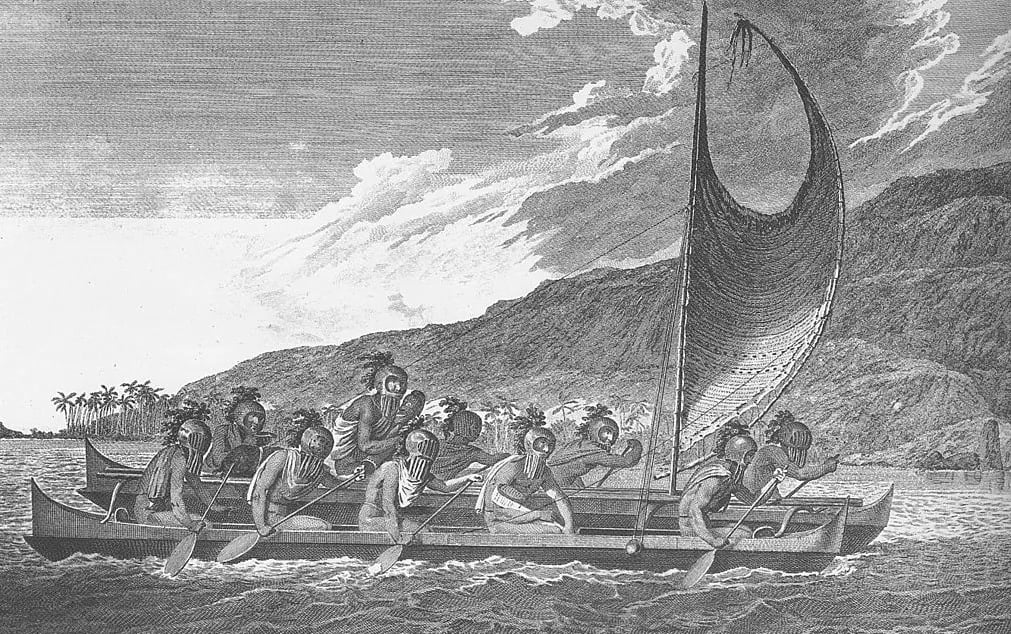
Exploring the Monohull Design
Stepping into the present, let's delve deeper into the modern monohull design. Its traditional single hull offers a quintessential sailing experience that's hard to match. Monohulls are typically seen as the embodiment of the romantic sailing ideal, thanks to their elegance and the graceful way they heel under sail.
One of the major benefits of monohulls lies in their seaworthiness. Their deep keels provide excellent stability, allowing them to handle heavy seas and high winds effectively. In addition, the keel acts as a counterbalance, enabling the boat to right itself after being heeled over by a gust of wind. This 'self-righting' characteristic is a significant safety feature exclusive to monohulls, adding a level of reassurance when navigating challenging sea conditions.
Monohulls are also known for their responsive handling and satisfying sailing performance. The mono-hulled design cuts cleanly through waves, resulting in a smooth and predictable ride. If you're the type of sailor who enjoys feeling the wind and waves' raw power, the visceral connection that a monohull provides is unparalleled.
However, as with everything in life, monohulls also have their downsides. For one, space can be at a premium. The deep keel and the rounded hull shape necessary for stability and performance take up much of the interior volume, leaving less room for living space compared to a similarly sized catamaran.
Another consideration is the heeling motion. While some sailors love the feeling of a boat leaning into the wind, others may find it uncomfortable or disorienting, especially during prolonged passages.
Despite these trade-offs, monohulls continue to hold their charm for many, offering a blend of tradition, performance, and adventure that has stood the test of time. In the next part of this deep dive, we'll shift our focus to the twin-hulled wonder of the sailing world: the catamaran.
The Catamaran Conundrum
As we switch gears to catamarans, it becomes apparent how contrasting they are to their monohull counterparts. Catamarans, with their dual hulls connected by a central platform or cabin, present an entirely different set of strengths and challenges.
Let's start with one of the most prominent features of catamarans: their stability. The wide beam of a catamaran provides a significant increase in stability over a monohull, reducing the boat's tendency to roll. This stability not only enhances the comfort of your crew but also allows for safer and easier movement on deck and below. If the notion of preparing a meal in a level galley while underway appeals to you, a catamaran might be the perfect fit.
Space is another major advantage of catamarans. With essentially two hulls worth of volume, catamarans typically offer much more living space than a similarly sized monohull. This makes them an attractive option for those planning extended cruises or living aboard. The additional space also allows for separate, private cabins in each hull, perfect for accommodating families or groups.
When it comes to performance, catamarans have a distinct edge in certain areas. Their dual-hulled design and lack of a ballasted keel result in less drag, allowing them to often outpace monohulls in moderate conditions. However, this speed advantage may be offset in heavy weather, where the ability to cut through waves (rather than ride over them) can make a monohull's ride smoother and faster.
But, just like monohulls, catamarans aren't without their drawbacks. While their stability and flat sailing characteristics are often seen as benefits, they can also create a false sense of security, leading some sailors to push their boats beyond safe limits. Additionally, while catamarans are significantly harder to capsize than monohulls, if they do flip, they generally won't self-right like a monohull would.
Furthermore, catamarans can be more challenging to handle in confined spaces due to their wider beam. Docking, in particular, can be trickier, especially in marinas designed with narrower monohulls in mind. Also, the increased beam and dual hulls often lead to higher mooring and maintenance costs.
Monohull vs Catamaran: Performance Parameters
Before we take this deep dive to its conclusion, it's important to touch on a few key performance parameters. These can greatly influence whether a monohull or catamaran would be a better fit for your sailing needs.
For starters, how a boat handles various wind conditions is critical. Monohulls, due to their keeled design, tend to excel upwind. Their ability to 'point' into the wind is usually superior to that of a catamaran. On the other hand, catamarans, with their lighter weight and reduced drag, often have the upper hand in downwind and lighter wind conditions.
Another factor to consider is load carrying capacity. While catamarans have more space for storing gear and provisions, they can be more sensitive to overloading. Additional weight can significantly impact a catamaran's performance, whereas monohulls tend to be more forgiving in this regard.
In the final part of this blog, we'll wrap up our deep dive by considering these and other factors to help determine which design might be the best fit for your sailing needs.
Choosing Your Vessel: What Suits Your Sailing Style?
Now that we’ve explored the design principles and performance traits of monohulls and catamarans, it’s time to consider what kind of vessel will best cater to your personal sailing needs and preferences.
If your sailing plans involve long passages in open waters, especially in rougher seas or challenging wind conditions, a monohull's sturdy and seaworthy design might be the most fitting choice. Their excellent upwind performance and smoother ride in heavy weather will provide you with both comfort and safety on lengthy oceanic voyages.

For those attracted to the exhilaration of speed, catamarans, with their swift downwind capabilities, can offer a thrilling sailing experience. They can be the ideal choice if your sailing adventures are primarily focused on coastal cruising, island-hopping, or participating in sailing races where their speed advantage can shine.
Lifestyle preferences play an essential role as well. If you value space and comfort, and perhaps are contemplating living aboard or planning extended family cruises, the spacious interior of a catamaran, with its level sailing and private cabins, may be the superior option.
However, if you're a sailing purist who enjoys the classic feel of a boat that heels under sail, the thrill of mastering the art of balancing a boat in various wind conditions, a monohull will likely provide the sailing experience you're seeking.
As for cost considerations, remember that while catamarans offer more living space and stability, they can also come with higher purchase, maintenance, and mooring costs.
Closing Thoughts: Your Ideal Adventure on the Water
If you're looking to buy or charter a sailboat , the choice between a monohull and a catamaran ultimately boils down to your sailing goals, personal preferences, and budget. There's no definitive answer to which is better because it's subjective to the individual sailor.
Whether you're lured by the traditional appeal and seaworthiness of a monohull or the comfort, stability, and speed of a catamaran, the most important thing is to choose a vessel that will provide you with many memorable and safe adventures on the water.
At Sailing Virgins , we love them both and appreciate their unique characteristics. Whatever you choose, the sea will always be an ever-changing playground that continually challenges and rewards those who embrace the sailing lifestyle.
If you're still unsure about which one is for you, why not join one of our sailing courses or adventures? It's the perfect way to gain hands-on experience and discover what type of sailing brings you the most joy. Feel free to press the button below to check out our courses.
Fair winds and following seas to all prospective boat buyers out there!

Related posts
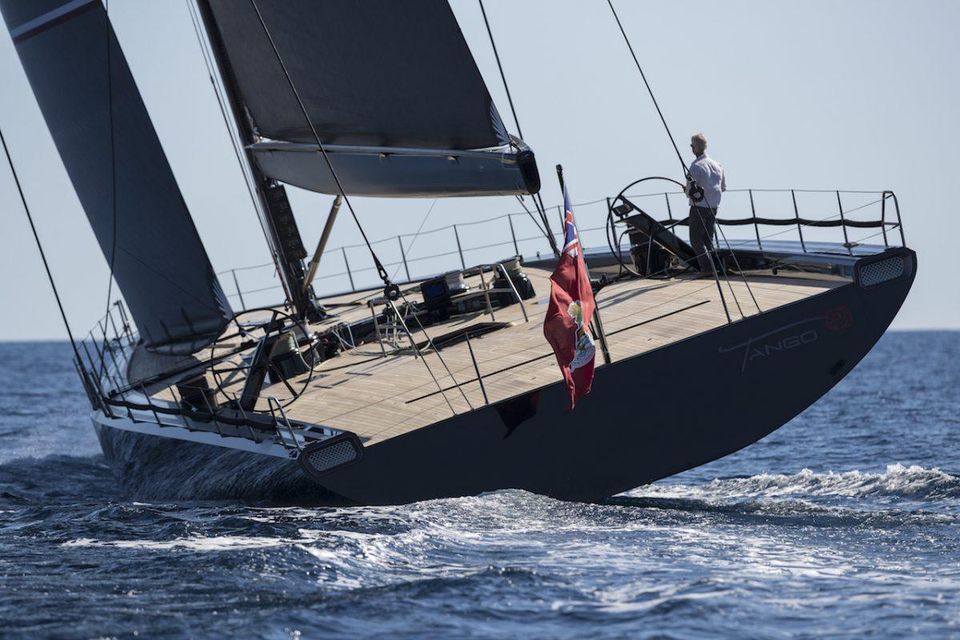
Catamarans vs. Monohulls
Which is better, a monohull or a catamaran.
This question gets asked a lot in sailing. Especially...
Recent Posts
- August 2016 (11)
- May 2023 (11)
- April 2023 (10)
- September 2016 (8)
- November 2016 (5)
- June 2016 (3)
- July 2017 (3)
- March 2018 (3)
- November 2018 (3)
- June 2019 (3)
- June 2023 (3)
- October 2016 (2)
- January 2017 (2)
- February 2017 (2)
- May 2017 (2)
- August 2017 (2)
- October 2017 (2)
- February 2018 (2)
- December 2018 (2)
- June 2022 (2)
- July 2022 (2)
- November 2015 (1)
- April 2016 (1)
- May 2016 (1)
- December 2016 (1)
- April 2017 (1)
- September 2017 (1)
- November 2017 (1)
- December 2017 (1)
- January 2018 (1)
- April 2018 (1)
- July 2018 (1)
- September 2018 (1)
- January 2019 (1)
- July 2019 (1)
- September 2019 (1)
- January 2020 (1)
- March 2020 (1)
- April 2020 (1)
- May 2020 (1)
- June 2020 (1)
- April 2021 (1)
- August 2022 (1)
- October 2022 (1)
- December 2022 (1)
- July 2023 (1)
- August 2023 (1)
- January 2024 (1)
- how to (21)
- sailing (14)
- Sailing Tips (12)
- corporate (9)
- sailing course (7)
- General (6)
- Insider (6)
- professional development (6)
- vacation (6)
- Mindfulness (5)
- leadership (5)
- Performance (4)
- group travel (4)
- opinion (4)
- opinions (4)
- qualifications (4)
- Interview (3)
- Trip Notes (3)
- Uncategorized (3)
- adventure (3)
- sailing virgins (3)
- Instructor Course (2)
- Self-Care (2)
- catamarans vs monohulls (2)
- charter boat (2)
- island adventure (2)
- networking (2)
- preparation (2)
- sailing guide (2)
- youtube (2)
- Athlete (1)
- Beginner (1)
- City Guides (1)
- Failure (1)
- First Time (1)
- Maderia (1)
- check out (1)
- fishing (1)
- french polynesia (1)
- gear tips (1)
- golf vs sailing (1)
- safety brief yacht (1)
- the yacht week (1)
- trip review (1)
The founders of Sailing Virgins started things as a result of having some incredible sailing seasons in the Mediterranean and Caribbean working for sailing company The Yacht Week. James then worked for and for a while managed Tortola Sailing School. In 2016 he branched off and started Sailing Virgins. We LOVE how sailing is changing. Top speeds in the America’s Cup were thirteen knots not so long ago. Now they’re 45 knots. If you’re excited by that, we’re with you. Giddy up!
- Wickhams Cay 2 Road Town, Tortola VG1110, British Virgin Islands
- +1 (272) 999-1920
- [email protected]
© LOVE SAILING VIRGINS 2016-2024
- Terms & Conditions
- Privacy Policy

Catamaran Or Monohull? 27 Important Facts (Explained)
Catamarans and monohull boats are two very different kinds of vessels. Each craft offers distinct advantages and disadvantages that you’ll want to consider before choosing between the two.
In this post, we’ll go over some of the important things to consider when choosing between catamarans and monohull boats:
Table of Contents
Cost & Availability
Both catamarans and monohull boats come in small recreational sailing versions, larger motorboat versions, and larger sailing models. In all cases, the catamarans will cost more and will be harder to find.
The reason catamarans are harder to find because there are not as many of them, and they’re mostly made overseas.
Also, there aren’t as many catamaran manufacturers, so sailors have fewer options when buying them.
On top of this, catamarans have only recently become popular in the United States and other areas of the developed world. This means the used market for boats doesn’t have as many catamarans on it. You might find that you have fewer options when making a used catamaran purchase, which could bring costs up to a premium.
Two Times The Fun with Catamarans

Another reason that catamarans are more expensive than monohulls is the fact that catamaran buyers have to purchase two hulls, two engines, and two of all of the components that help make an engine work.
Traditional sailboats and large powerboats with one engine don’t have this cost issue.
On top of this, a catamaran is much wider than a monohull, and thus you have more space to build and equip.
On the other hand, once you’ve purchased the boat, you do get to enjoy the benefits of having two of everything. We’ll talk about the advantages of this further down in this post.
Maintenance Cost Makes A Difference
The maintenance on a catamaran is also more expensive than the maintenance on a monohull boat. This goes back to the fact that there is twice as much of everything to maintain.
Catamaran owners will need to do preventative maintenance on two different engines, and they’ll have two hulls and a large deck area to clean and maintain as well. If they’re getting the bottom of the boat treated, they’ll have to do this twice (once for each hull).
Even the interior components can usually be found twice.
Each cabin will usually have a head in it, so you’ll have at least two toilets and sinks to maintain, which obviously has its plusses and minuses.
One positive aspect of this is that catamaran owners do have the option of deferring some of their maintenance. For example, if one head is no longer functioning properly, you always have the second one that you can use.
It also adds a bit of safety as well.
This is because while the catamaran does have two engines to maintain, the owner does have power even if one of the engines happens to go down.
Some catamaran owners also like to point out that maintenance may not have to be done as frequently. This is because the engines don’t have to work quite as hard, and other items like additional bathrooms and sinks might only be used half as much.
How Much Space Do You Need?

A catamaran has more space than a monohull. This is because the boat is wider, and it has a much larger deck area. It also has twice as many hulls, so you have more overall space between the two of them.
The additional space is great for people looking to throw parties on their boats.
Most boat owners would agree that the catamaran is usually the party boat of choice at the docks.
Even if you aren’t into throwing parties, the extra space can still be nice for relaxing on the deck or getting a suntan. The wide-open space also makes it easy to use the boat as a fishing platform.
Additionally, you have more space for stuff like surfboards, rafts, and other items that can easily clutter up the deck of a monohull. Even fishing can be easier from a catamaran as the deck provides plenty of space between different anglers.
Catamaran owners also have additional space for carrying fresh water and adding generators and solar panels.
Interior space is generally more plentiful on a catamaran, and luxury catamarans have an easier time fitting large items like washers and dryers inside of them. You can have these on larger monohulls as well, but it will be harder to make them fit than it is in a catamaran.
On the other hand, all of the additional space means the catamaran owner has more space to maintain and clean. Also, all of the additional items that can be brought onto the boat will make it heavier. A heavier boat will use more fuel, and it will travel more slowly.
Living Quarters Vary Between The Two
The living quarters on a catamaran are much different than they are on a monohull. Most people would agree that the berths in a monohull are much more spacious than in a catamaran.
A monohull offers people the opportunity to have a large bed with space on either side to walk around it. This is great for couples who want to get out of bed without waking up their partner.
Catamarans, on the other hand, have the advantage of being able to offer large above-deck salon areas. The galleys, the dining areas, and the living areas can all be above-deck, while the two hulls can provide heads and berths.
Some boat owners say that living in a monohull is akin to living in a basement apartment . Other boat owners prefer the monohull because it brings them closer to the water and gives them the feeling of being at sea.
Privacy Can Be Prioritized On Catamarans
A catamaran offers up many different living areas that people can take advantage of. For example, each hull will typically have its own bathroom and bedroom.
This gives each sleeping area complete privacy from the other.
The living quarters are usually up on the deck, so early risers can wake up and move to these quarters without waking up the others.
The same holds for night owls. A night owl can stay up late without bothering the people who want to retire to their beds earlier.
With two hulls, large catamaran owners can hire a crew and give them their own hull to live in so that there is separation between the cruisers and the crew. This is a wonderful advantage for honeymooners looking to have their own space.
The downside to all of this, of course, is that sometimes a family may not want the additional privacy. For example, a family with small children might not want their children in a different hull than they are.
Additionally, the extra privacy can make it hard for people on the boat to communicate. This could become a big problem in the event of an emergency.
For this reason, it is often recommended that each hull have a radio in it so that the occupants can quickly communicate with each other. Remember, even in inland areas, cell phone reception may not be very good inside the boat hulls.
Recreation In a Monohull vs. a Catamaran
Most sailors agree that sailing a monohull boat is much more exhilarating than sailing a catamaran. Traditional sailboats heel, and sailors get instant feedback while they’re sailing. For the most part, catamarans stay stable, and you don’t get the same feeling with the movement of the wind and the water.
When it comes to monohull powerboats, you have the advantage of being able to pull water skiers, kneeboarders, and tubers with ease, as long as the boat has the power and a planing hull. A power catamaran usually doesn’t have the speed or maneuverability to pull off these recreational opportunities because they are displacement hull designs.
Catamarans excel in more leisurely recreational activities. A catamaran makes a great party deck as well as a great cruising deck. Catamaran owners can comfortably walk around a catamaran without having to worry that the boat might knock them over the next time it decides to heel. This allows boaters to sit and talk with one another comfortably.
A catamaran can also be used as a beaching vessel. This makes it a great platform for people looking to go swimming or fishing around sand bars and other shallow water areas. It also makes it a great boat for sailors looking to sail a larger boat on a river or lake known for having shallow areas.
Swimming and Diving
Swimming and diving off of a catamaran are usually much easier than doing the same from a monohull. The wide stance of the two hulls offers boat designers the option to put in staircases at the back of both hulls.
In between these staircases, some boats will have an additional diving platform and/or a dedicated frame for pieces of equipment and dinghy storage. This makes catamarans great for swimmers, snorkelers, and divers.
On the other hand, modern monohull sailboats can also have good transom stairs for easy access to the dinghy and swimming. Both types of boats can easily travel far out to sea, giving boaters the option of diving in areas that can’t be accessed from beaches and developed areas.
Boat Draft In Shallow Waters
For the uninitiated, the boat’s draft refers to how deep the boat’s hull sits within the water.
A monohull typically sits deep within the water, while a catamaran sits much higher on the water. This is why we stated that a catamaran is good for shallow waters.
The advantage of having a boat that can go into shallow waters isn’t restricted to just recreational activities like swimming and fishing. A boat that can go into shallow water is safer to operate in areas where a boat with a deeper draft might become damaged.
Additionally, a catamaran has more stability on calm waters. This helps make a catamaran more comfortable to relax or sleep on while at anchor or the dock.
The deeper draft of a monohull boat has its advantages as well. A deeper draft provides more stability in rough waters and allows a boat to go further into the sea.
For this reason, many coastal cruisers will prefer catamarans, while many ocean voyagers will prefer monohull boats. In fact, some areas of the Caribbean and the Florida Keys can be off-limits to boats with deep drafts as it simply isn’t safe for the boat to navigate these waters.
This isn’t to say that you can’t navigate these waters in a monohull boat, but you will have to be cautious depending on how deep your monohull’s boat draft is. You wouldn’t have this issue in a catamaran.
Stability On The Sea

A catamaran offers a lot more stability in shallow waters, in calm waters, at the dock, and anchorage. This makes the boat great for cruising and for relaxing in port.
A monohull offers a lot more stability in rough waters.
This makes this boat great for heading out to sea and for navigating vast distances.
Safety Issues To Consider
Both catamarans and monohulls can be built to navigate the waters they were made for safely. This will be determined more by the boat’s category designation rather than the type of boat.
However, each boat deals with unsafe situations in different ways. For instance, a monohull boat is likely to right itself if it is capsized.
This means that even in rough seas, you’re unlikely to find yourself permanently capsized.
The downside to this is that should you become completely swamped from a capsize in a monohull boat, you are much more likely to sink. In fact, if there is a hull breach on a monohull boat, your boat could sink.
Catamarans are said to be unsinkable. This isn’t completely true, but it is very unlikely that a catamaran will sink. Even if a hull is breached, you still have a second hull to keep the catamaran afloat.
However, a catamaran can’t right itself. If you capsize your catamaran, it will stay capsized.
One other safety concern to consider is that a monohull sailboat will heel while a catamaran will not. This increases the chances that someone could fall off the boat or onto the deck in a monohull boat.
Catamarans Are Faster Than Monohull Boats
A catamaran is faster than the average monohull boat.
This is because they face less water resistance, and their narrow hulls don’t have to deal with their own bow waves as a monohull does.
Of course, catamarans aren’t always faster. Old cruising catamarans may not go faster than 8 knots, and modern monohulls can exceed 10 knots.
Monohull boats tend to sail downwind and in choppy seas better than catamarans. This gives them a speed advantage during ocean voyages.
We have a separate post with complete average speeds per type of catemaran . It’s a must read if you are at all concerned about speed!
Fuel Consumption Considerations
Catamarans have two engines to burn fuel, which can drive up fuel costs.
However, a catamaran is lighter on the water, so it usually takes less energy to move a catamaran. This means you’ll end up using less fuel in a catamaran than you would in a monohull.
On top of this, catamarans can decide to use just one engine in low wind areas. This further decreases the amount of fuel that a catamaran consumes.
These rules only apply to calm waters.
A monohull navigates waters with high waves and strong winds much more efficiently than a catamaran. In this case, you’ll use less fuel in a monohull than you would in a catamaran.
Sailing Differences To Notice
Sailing a monohull boat can be exhilarating. These boats can glide through choppy waters, and you get to feel the motion of the boat as the sea rushes by the cockpit and the wind causes you to heel.
This type of sailing also provides instant feedback as you’ll know what you need to do with the sails as you’ll feel what is going on through the boat’s motion.
Sailors all over the world have been using monohull sailboats for years, and you’ll find plenty of outlets for recreational sailing with a monohull sailboat.
Sailing catamarans do not heel like a monohull sailboat.
These boats, therefore, do not provide the sailor with instant feedback. Also, if you incorrectly sail a catamaran, you do risk capsizing the boat more easily.
Training Can Be Quite Hard
Sailing a catamaran and sailing a monohull boat are two different experiences. People looking to sail either should probably get professional training.
Obtaining this training will always be easier with a monohull boat.
This is because monohulls are more popular, so you’ll have more instructors available to you.
Do You (Or Your Friends) Get Seasick?
People who are prone to getting seasick easily might want to consider a catamaran. A catamaran provides much more stability in calm waters, and you get a lot less movement.
On the other hand, people who are not prone to getting seasick might prefer a monohull in choppy waters.
This is because a monohull will deal with deep and choppy waters with high waves much better than a catamaran will.
As a result, a catamarans movement can seem extreme under these types of conditions. People who have never gotten seasick before can end up sick under these conditions.
Here’s a separate article we wrote with everything you should know about seasickness on Catamarans . There are some things you can do and some things you should know!
Docking Is (Usually) Easier With A Monohull Boat
Docking a catamaran can be a difficult endeavor.
This is because catamarans are often too wide to be docked within the slips located in central areas of a marina.
Because of this, they need to be docked at the end of the dock. This leaves them with fewer spots to dock. It also makes docking more expensive.
Catamaran owners traveling through areas that are unlikely to have many catamarans in them may find it difficult to find a dock at all. This is true in areas of the northern Atlantic where monohulls are much more popular than catamarans.
Storage Issues To Consider
Even storing a catamaran can be more difficult. This is because storage facilities often do not have the equipment to get a catamaran out of the water.
The wide width of these boats requires special lifts, and not all boat marinas will have them.
Storage facilities that do get the catamaran out of the water will often charge more money for it. They’ll charge additional fees for taking the catamaran out of the water, and they’ll charge additional fees for the actual storage of the boat as well.
Redundancy And Backup Equipment
We touched upon this earlier, but it is worth repeating that catamarans have many redundancy built into them. This can be a big advantage when it comes to safety.
For example, if one rudder becomes inoperable, the boat can still be steered with the other one. If one engine becomes inoperable, the boat can still be driven with the other one.
In extreme cases, a hull could become damaged, and you could still stay afloat because the other hull will keep the boat safely above water. These safety advantages can save lives and keep people from becoming stranded out at sea.
The primary downside is the maintenance issue that we mentioned earlier. All of these redundant components will need to be maintained. As a result, maintenance costs will be close to twice as expensive in a catamaran.
Cooking Is Easier On Catamarans

Cooking on a catamaran is usually easier than it is on a monohull. The main reason for this is that a catamaran doesn’t heel like a monohull, so you don’t have to worry as much about things falling over.
This not only makes cooking easier, but it makes cooking safer as well.
Additionally, catamaran galleys tend to have more space in them to move around. Also, they are often up on the deck, so you don’t have to climb in and out of the hull with your dinner in hand.
Dinghy Storage
Monohulls and catamarans can both hold dinghies. The larger the boat, the larger the dinghy can be.
However, catamarans have a wide area at the rear of the boat that is perfect for holding dinghies.
This makes getting in and out of the dinghy easier. Also, people can often have larger dinghies on their catamarans because the boat’s stern is so accommodating.
Power Generation Is Easy On A Catamaran
A catamaran has a lot of space for solar panels and wind turbines. Rigid panels can be placed in areas that won’t be walked on, like overtop of the bimini, and flexible panels can be placed in areas where the panels might end up getting stepped on.
The width of a catamaran even gives them more opportunities to put hydro generators into the water.
This means catamarans can generate more power than the average monohull boat can generate.
On the other hand, a monohull usually has less powered items to worry about. Monohulls need less power to operate at full capacity, so you may not need all of the additional space for generating power.
Ventilation Issues To Think About
Some people feel that monohull boats don’t offer enough ventilation. This is especially true in warmer areas of the world.
Catamarans also lack ventilation within their hulls, but fortunately for them, much of the living space is located up on deck. This gives catamarans an edge when it comes to cruising in warm weather.
On the other hand, monohull owners aren’t exposed to the cold winds that you might find up on deck in harsher climates.
This lack of airflow may actually be of benefit in this instance.
Some people find monohulls to be better looking than catamarans and vice versa.
This all comes down to personal preference, so you’ll have to decide for yourself which type of boat has the advantage in this case.
Some people think catamarans are the most elegant thing in the world while others prefer monohull boats as they look more classic.
Resale Value Is An Important Factor
If you read our extensive guide to boat depreciation per boat type , you know that no matter what boat you buy, it will always go down in value. This is just a sad fact of boat ownership that people need to consider before buying a boat.
Many factors go into how much you’ll be able to get for your boat when you resell it. These factors are the condition of the boat, the age of the boat, and the economy in general. For example, people are less likely to want to buy boats during a recession. This is especially true when it comes to smaller boats.
However, one additional factor that catamaran owners need to consider when thinking about resale value is the value of the dollar.
People from the United States don’t have many American catamarans to choose from and will usually need to buy these overseas.
This means that a catamaran will be less expensive to buy when the dollar is strong compared to the Euro and more expensive to buy when the dollar is weaker in comparison. This will affect the used market as well because higher values on new catamarans can help to bring up the value on the used market.
With a monohull boat, you may not have to consider situations like this as there are makers of monohull boats all over the world.
Don’t Let The Length Trick You!
One thought to keep in mind when comparing monohull boats and catamarans is that their different shapes account for different space advantages.
For example, a 40-foot long catamaran will have much more cubic space than a 40-foot long monohull.
Because of this, when comparing boats, you should look at the cubic space rather than the length. In this case, you may be comparing a 48-foot long monohull with a 40-foot long catamaran.
When you compare the two types of boats in this manner, the price differences aren’t quite as large, and the comparison is fairer. It also may make the operating and maintenance costs more similar.
This is an important distinction to make because the length of the boats can trick you!
Consider Trying Both (Before Buying)
Boats can be an expensive purchase, so it makes sense to try them out before you decide to make your purchase.
Rent each type of boat and use it on the types of waters that you intend to cruise on the most.
Try the boat out in different weather conditions as well, and don’t be afraid to do multiple rentals before you make your final choice. The time and money invested into making sure you get the boat you really want will be more than worth it in the end.
Click to share...
Better Sailing

Catamarans vs Monohulls: Which is Better a Better Sailboat For You?
The question of whether to choose a monohull vessel or a catamaran is an eternal dispute between boat lovers. These arguments are usually based on one’s preferences and philosophy. In fact, the popularity of catamarans has grown significantly since their design facilitates many aspects of sailing. But, both mono-hulls and multi-hulls have their advantages and disadvantages. So, in this article, I’m going to list some details about both cats and monohulls so as to help you understand which one is better for you. Remember it all depends on what sort of experience you are looking for. Keep reading!
What is a Monohull?
In general, boats float due to the fact that they displace more water than they weigh. The hull is in “displacement mode” while a boat is stationary or moving slowly. That is, all of the upward forces that keep it afloat come from flotation, which is achieved by displacing water. With certain hulls, increasing the boat’s speed beyond a particular point causes the hull to lift up and skim along on top of the water. This is referred to as “planning.” Monohulls can be divided into two types; displacement and planing hulls.
Some hulls are only capable of moving at displacement speeds . This style of boat has generally slow speed, but it is incredibly efficient to operate. While moving, most have a smooth motion , though rolling (side-to-side movement) might be an issue. On the other hand, while on the sea, achieving fast speeds requires a hull that can readily transition onto a plane. Flat bottom surfaces from amidships aft, or from the middle to the back of the bottom, and a flat transom, or the back of the hull, are the main characteristics of a planing hull. Keep in mind that at a sharp angle, the transom must contact the bottom.
What is a Catamaran?
Nowadays, catamarans are becoming more and more popular. They’re particularly appealing to fishermen since they combine high-speed performance and a smooth rough-water ride with a solid angling platform. Catamarans have two primary disadvantages . Firstly, they require twin engines. Also, larger catamarans may be too broad to fit into standard marina docks. Another disadvantage is that there is less usable interior space than on a monohull of comparable length.
The two hulls of a catamaran are known as amas. These days, the popular phrase is “sponson,” but ama is still acceptable. Note that in comparison to its entire length, each ama is quite short. The narrow amas of a catamaran travel quickly through the water with little power. This allows for fast speeds even when the amas aren’t actively planning.
Trimarans on the other hand have three separate hulls. Sailboat designers have successfully employed this design to provide a large central hull for cabins. But, also for two outrigger amas for stability. The trimaran concept hasn’t been used much in powerboats, despite the fact that several “cathedral” hulls are related. Instead of three independent hulls, a cathedral design squishes them together to the point that they often share a similar planing surface near the transom.

Monohull or Catamaran? Let’s Take a Look at Their Pros and Cons
Catamarans are unsinkable because they are incredibly stable and have natural buoyancy. Yes, they can capsize in a major accident. But, being rescued while floating on the water’s surface is preferable to plunging to the bottom in a monohull. Furthermore, moving around on a flat deck is far safer than on an angled deck.
Classicists have long claimed that catamarans are not as safe as their keelboat counterparts. However, this remark is now regarded as archaic. Since it dates from the mid-nineteenth century when the majority of catamarans were made by amateurs. They could readily tip over even in calm weather, especially if one of their bodies became leakproof owing to damage. Sinking is extremely difficult, if not impossible, for a well-built modern catamaran. Modern structures are designed using computer simulations of various water conditions. Bear in mind that the maximum potential safe sail area is available to cruisers and charter possibilities in particular.
Monohulls , particularly sailboats, offer significantly stronger “self-righting” capabilities in the event of a worst-case knockdown situation. In a catamaran, once you’re upside down, you’re stuck there…And, who wants to be upside down in the middle of the ocean? Returning to an upright position gives you complete access to onboard safety equipment. This includes a liferaft, dinghy, flotation devices, EPIRBs, and strobe lights, which can save you if the boat sinks.
Generally, a catamaran’s high speed allows it to avoid adverse weather . While catamarans do not point as high into the wind as monohulls they are around 20% faster . Or, if they do, they create more leeway or slide sideways. This means that even if you sail upwind at a slightly broader angle to the wind than a monohull and cover a more distance, you will arrive at your destination sooner than a monohull.
A modern performance catamaran with daggerboards and strong sails may point as high as a monohull of comparable size. It will point similar to a comparable monohull but will sail far faster. This allows it to reach an upwind position far sooner than a monohull. However, it’s worth noting that the majority of production cats on the market are underpowered and have standard smaller sails. Many of these designs perform poorly in light breezes. Unless they’re equipped with larger headsails, a Code Zero, and a square-top mainsail.
While cats are more comfortable and safer in rough weather, we must admit that if the weather gets extremely terrible (60 knots of wind or more), it’s better to be on a monohull for survival reasons. For serious offshore single-handed sailing, I believe a monohull is superior since it is easier to hove-to in it. Bear in mind that when you’re in a cat during severe storms you won’t feel any danger, but it demands some nifty seamanship. And, keep in mind that even though a monohull can capsize in bad weather or even roll in a storm, they usually right themselves. A catamaran , on the other hand, is incapable of self-righting . However, the cat will usually stay afloat, providing a safe haven to wait out until aid arrives. Modern catamarans, on the other hand, are extremely difficult to capsize.
That being said, most catamarans can travel 200 to 250 miles per day, and with contemporary technology allowing one to control weather, it’s difficult not to deal with bad weather. In many circumstances, a faster boat is a safer boat because it can outrun heavy weather. A catamaran can avoid the worst weather and, at worst, put itself in the best position to avoid the brunt of a storm if there’s good weather routing information.
So, to sum up, cruising catamarans are quicker than monohulls, and sailing catamarans, depending on their angle, can sail at half the speed of the wind. It’s great to be on a boat that can swiftly attain high speeds and get you to your destination safely and on time. However, catamarans are faster because of their lower surface area , but their prices are generally higher than those of monohulls. Instead of fighting the elements, monohull designs operate in harmony with them . In addition, keep in mind that when sailing upwind, sailing catamarans are inefficient and tack slowly.
Fuel Consumption
Do you want to save money on gas? Then, in most cases, catamarans have less fuel consumption than monohull boats. Catamarans save a lot of gasoline since they have a less wetted surface area on their hulls. They can propel the boat with just one engine in weak winds. Also in flat water, and if the engines have the same number and horsepower. However, in heavier weather , where the higher efficiency of a monohull design provides less resistance , this is not the case.
Generally, catamarans have two fuel-burning engines, which can raise fuel expenses . However, because a catamaran is lighter on the water, it requires less energy to move. In a catamaran, you’ll use less fuel than you would in a monohull. Furthermore, in low-wind areas, catamarans might choose to use only one engine. This reduces the amount of fuel consumed by a catamaran even more . But, only calm waters are subject to these laws. A monohull is far more efficient than a catamaran in navigating waters with heavy waves and heavy winds. A monohull will consume less fuel than a catamaran in this situation.
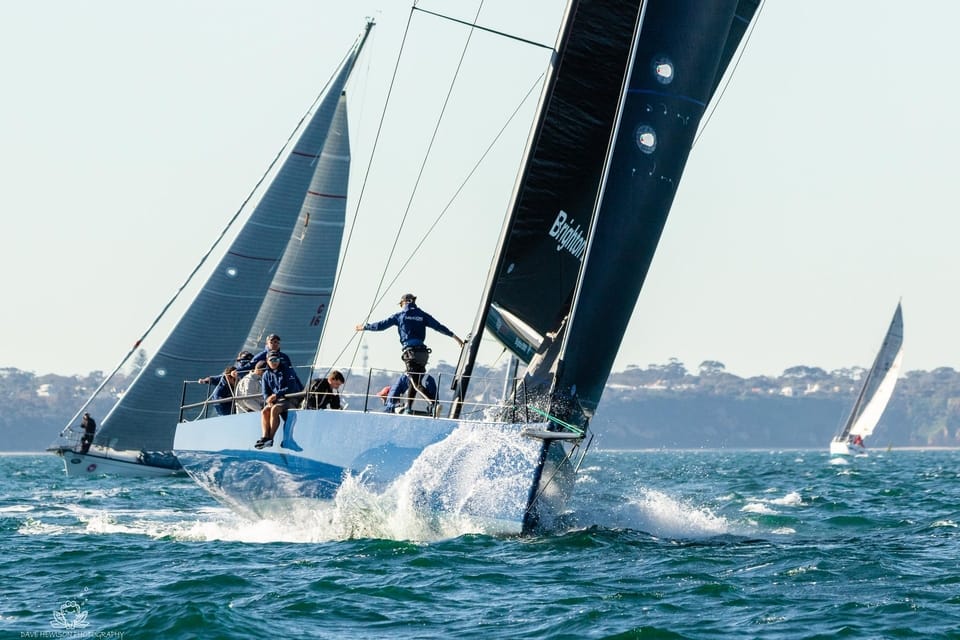
The best feature of catamarans is that all of the rooms are on the same level. The four-cabin arrangement is common with sailing cats and is popular among charter companies. Owner versions usually feature three staterooms, with one hull serving as a big cabin for entertaining. Most catamarans have a big central living room with not one, but two narrow staircases leading down into the hulls—one on each side. It’s a little like living in a tube in the hulls. They’re too thin to accommodate walkaround double/queen berths like those found in monohulls. But, in case of an emergency, it would be impossible to communicate with someone in the opposite hull.
Obviously, a monohull has less space than a catamaran. This is due to the fact that a cat is broader and has a larger deck surface. It also has twice as many hulls as the other, giving you greater total space between them. People who want to host parties on their boats will appreciate the extra space. The catamaran is usually the party boat of choice at the docks, according to most boat owners. Even if you don’t like to host parties, the extra room might be useful for lounging on the balcony or tanning. The boat’s large open space also makes it simple to utilize as a fishing platform.
You also have more room for equipment like surfboards, rafts, and other equipment that can easily clutter a monohull’s deck. Even fishing from a catamaran can be easier because the deck allows for plenty of space between anglers. Owners of catamarans also have more room for carrying fresh water and installing generators and solar panels. A catamaran’s interior room is often larger, and in luxury catamarans, it’s easier to install heavy appliances like washers and dryers inside. These can be fitted to larger monohulls as well, though it will be more difficult than on a catamaran.
All of the extra space, on the other hand, means the catamaran owner has more room to maintain and clean. Furthermore, all of the other stuff that can be brought into the boat will add to its weight . And, as well all know, a heavier boat will consume more fuel and move at a slower speed.
Maneuverability
With their twin motors, catamarans are incredibly agile . On a catamaran, the engines are widely apart, making navigating more easier and more precise than on a monohull, unless the monohull incorporates a bow thruster. Most of the time, a bow thruster isn’t required because the engines are around 20 feet apart. When there’s no bow thruster (as do few monohulls) you have to rely on prop-walk and prop wash on the rudder. On her own axis, a contemporary catamaran can turn 360 degrees. A monohull would be unable to accomplish this while it has a larger turning circle.
A monohull under sail, on the other hand, is far more maneuverable and will tack much faster than a catamaran. But, the ease of movement under motor on a catamaran, especially in close quarters, is substantially superior. They also feature shallow drafts , allowing you to maneuver into areas that a monohull cannot, as well as anchor closer to shore . However, monohulls are more maneuverable as you don’t have to deal with two hulls. They can make sharper turns and travel through small channels and small areas easier than cats. In addition, their hull displacements lessen the negative impacts of crosswinds in confined spaces.
Anchoring and Docking
While docking a catamaran is simple, its big size makes it difficult to fit into a standard slip. However, with some skill and good planning, finding room should be no problem. You may even anchor or moor the boat and dock it with the dinghy, which is much easier than a monohull. However, keep in mind that in most cases docking, hauling, and slipping a monohull is significantly easier, takes up less room, and is far less expensive.
Moreover, docking a catamaran can be a challenging task. This is due to the fact that catamarans are frequently too wide to dock in the marina’s core regions. As a result, they must be docked at the far end of the dock. Therefore they have fewer docking options and raise the cost of docking. Owners of catamarans sailing through places where there aren’t many catamarans may find it difficult to find a dock at all. This is especially true in the northern Atlantic, where monohulls outnumber catamarans.
Keep in mind that one of the most significant advantages of a sailing multihull is its stability . Not only at sea, when heeling simply does not – or should not – occur to any significant extent, but also at anchor. It also greatly expands one’s anchorage options to include areas influenced by the swell. This is quite common in the Caribbean, where a slight shift in wind direction may make a previously flat, quiet anchorage intolerable in a monohull. In addition, its fairly shoal draught expands the options even more.
Catamarans have a large platform, making them ideal for relaxing at anchor without the rolling motion that monohulls are prone to in a swell. Many monohull sailors had to leave anchorages because of the uncomfortable anchoring. This is because large rollers or swells entering an anchorage can make the situation extremely uncomfortable and dangerous.
Also, a bridle is tied to both bows and down to the anchor chain on catamarans , resulting in a fairly secure position at anchor . In heavy winds, many monohulls tend to sail at anchor since the bow acted as a sail (due to the high freeboard). They sail in one direction until the chain snatches, then tack across and sail in the opposite direction, almost completely dislodging the anchor. The catamaran, on the other hand, is much more stable at anchor and does not sway as much.
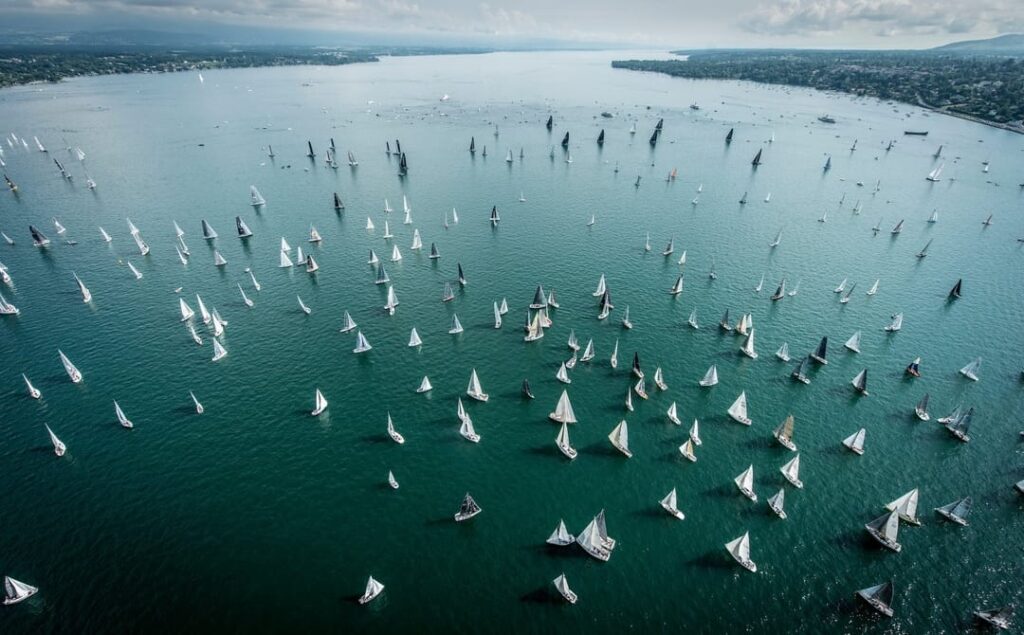
Sailing Abilities
Most cruising multihulls won’t point like a monohull with a deeper keel upwind, and the motion may be rather unpleasant when sailing in rough weather. You must also keep a close eye on the sail area, but we’ll analyze this further below.
Moreover, catamarans are not suitable for racing and sailing sports. They can be fantastic for a holiday or even living aboard, but most racers would never buy one because of the stability. There is no sense of wind, waves, flying, or the boat itself on a catamaran. It’s quite tough to tell when it’s time to reef. While this can be done by feel on a monohull, there is specific instruction for catamarans as to what winds the sail area should be reduced.
When sailing to higher latitudes, like the North Atlantic, then a monohull would be a better solution than a catamaran. Residential areas are easy to heat and keep warm, and traditional metal may even melt thin ice. The contrary is true in the tropical zone, where huge catamaran salons would be unbeatable.
Monohulls can sail higher into the wind than most catamarans due to their keel. Daggerboards, which serve the same role as a keel and boost windward performance significantly, are common in some catamarans. However, daggerboards are not seen on 95 percent of cruising cats (those available for charter). Also, a monohull will be much easier to tack than a catamaran and glide lightly through the water. Moreover, in rougher seas, certain catamarans experience an annoying slapping of water on the bridge decks. A monohull responds to the helm more quickly than a multihull (in other words, they turn faster). This is due to the fact that most cruising cats have small “spade rudders” whose depth is dictated by the need for a modest draft. While with a keel, a monohull can have a more responsive rudder for its draft.
Monohull spreaders are 90 degrees to the mast, however, catamaran spreaders must be backswept. The reason for this is that a monohull has a backstay, and by combining it with the intermediates, you can achieve a lovely pre-bend in the mast. Keep in mind that the pre-bend is to flatten out the mainsail and allow for better performance.
Also, in order to pre-bend the mast on a catamaran without a backstay, you’ll have to utilize the backswept spreaders and diamonds. The reason I bring this up is that if you want to broad reach or run on a catamaran, you can’t let the mainsail out all the way because the backswept spreader tips could puncture the cloth. Because the spreaders on a monohull are at 90 degrees, you can let the main and boom out much wider, which is obviously more effective. This is one of the reasons why a catamaran should broad reach and tack downwind.
- Maintenance
Because catamarans have two of everything, there is a clear trade-off between maintenance costs, reliability, and redundancy. One of the most significant advantages of having two of everything is that you have a backup . As a result, even if one component fails, you can typically still utilize the boat, such as running on one engine while the other fails. While redundancy is fine, lower maintenance and repair costs are generally preferable. Although having two of everything provides you some redundancy, I doubt you’ll want to take the boat out if one of the two hulls “fails.” Of course, this means two hulls to clean and antifoul, double the engine maintenance, and so on , but having two of the important pieces of equipment, such as engines, outweighs the disadvantages.
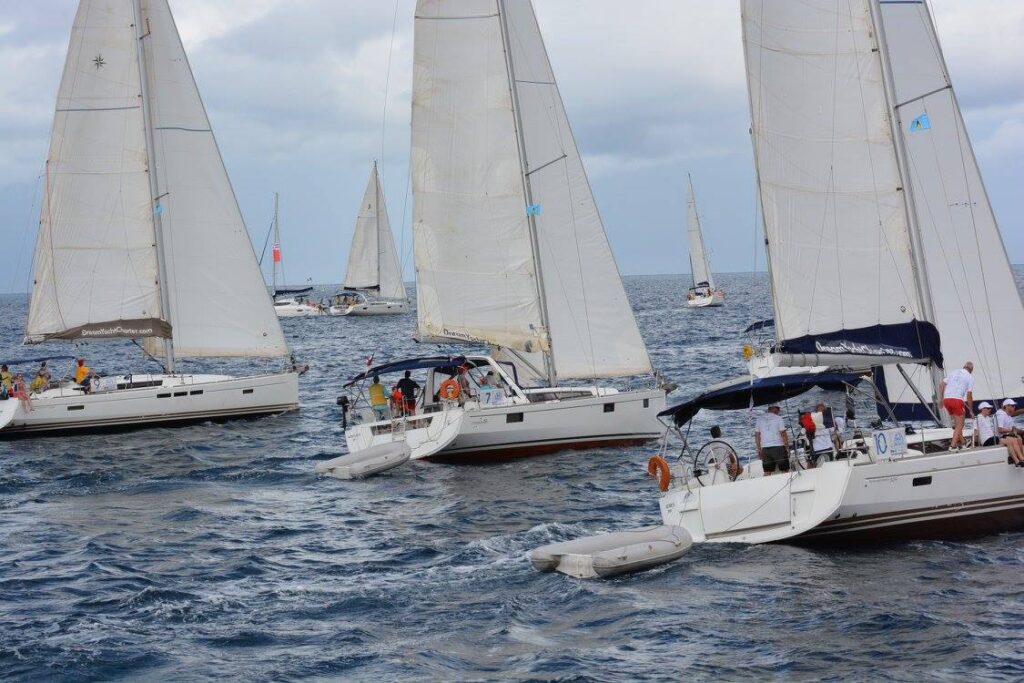
Due to their weight-bearing, catamarans have minimal to no heeling and do not roll at anchor. With sudden gusts, heeling on a monohull can be dangerous and uncomfortable, not to mention seasickness. Again, the trade-off is a noisy ride and fast movement, which many people find uncomfortable in bad weather. However, the heeling action of a monohull sailboat offers stability, spills wind from the sails, and provides safety.
Catamarans, unlike monohulls, do not have ballast in their keels, therefore they rely on beam and buoyancy for stability. Typical cruising catamarans have a beam-to-length ratio of around 50%, while several modern designs exceed this figure. A 45-foot catamaran will be around 22 feet wide, offering a highly solid sailing platform. Monohulls, unlike catamarans, cannot overcome rolling and pitching because of their narrow beam and lead ballast.
Rolling and pitching on a monohull while underway is quite dangerous. But, walking around on the deck of a catamaran while underway is easier because the boat is considerably more stable and does not heel. Sail adjustments and reefing are also significantly easier and safer for the crew as a result of this. The risk of falling overboard on a catamaran is far lower than on a monohull because of the rolling and pitching motion.
Generally, buying a catamaran is substantially more expensive than a monohull. So, if you opt for a cat you should also consider your budget before even starting your research. Pre-owned monohulls, on the other hand, are extremely inexpensive to purchase due to a current supply that considerably outnumbers the demand.
Nowadays, catamarans are in high demand , and they normally keep their worth far better and longer than other types of boats. And that’s why the market is currently centered to manufacture lots of them. Bear in mind that looking for a catamaran under $250,000 your options will be limited, and finding a catamaran under $100,000 is nearly difficult. Unless you opt with older boats like the Prouts or the less priced Geminis, a monohull is your best bet in this instance.
The cost of a cat rises if you need at least two of everything. But, keep in mind that due to their popularity, catamarans have a high resale value and a low depreciation rate , and they normally sell faster than monohulls. Due to the fact that most catamarans are not made in the United States, delivery expenses must be considered when purchasing the boat. Multihulls are becoming more popular, and as a result of the increased demand, they command greater prices in both the new and brokerage markets. Lastly, when considering a purchase, keep in mind that maintenance costs are substantially higher than on a monohull.
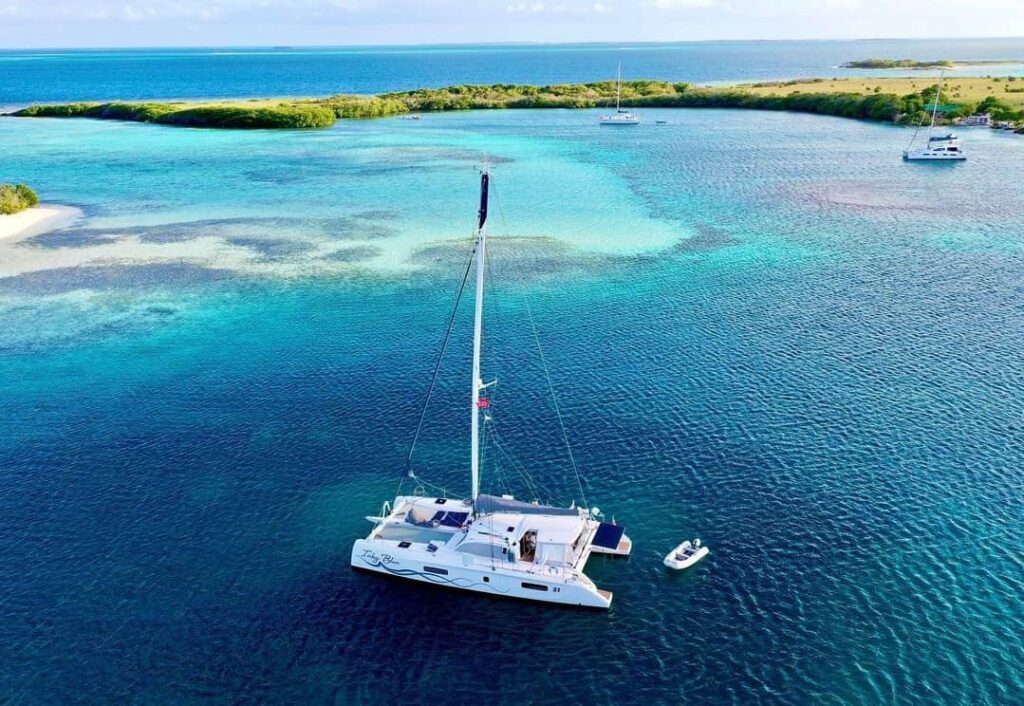
Catamarans vs Monohulls – The Bottom Line
So, this is it! We’ve come to the end of this highly discussed topic among sailors. Obviously, everything would be determined by two basic factors: personal preferences and budget considerations. Both monohulls and multihulls have their pros and cons and it’s totally up to you to decide which one suits you best. Because the two types of vessels provide such a different experience, it is highly recommended that you rent and test each one before purchasing to compare everything. In any event, it’s reasonable to say that a catamaran is an excellent choice for a charter, if not for purchase. Despite its high price, it provides comfort, space, and stability but you have a better overall sailing experience with a monohull. So, I hope that this article will help you make the right choice according to your needs. I wish you good luck with your research!
Peter is the editor of Better Sailing. He has sailed for countless hours and has maintained his own boats and sailboats for years. After years of trial and error, he decided to start this website to share the knowledge.
Related Posts

The Ultimate Guide to Choosing the Best Fishing Line for Trolling

Lagoon Catamaran Review: Are Lagoon Catamarans Good?

Best Inboard Boat Engine Brands

Are O’Day Sailboats Good? A Closer Look at a Classic Brand
- Buyer's Guide
- Destinations
- Sailing Info
Hit enter to search or ESC to close.

Sailboat Data Comparison: Monohulls vs. Catamarans
Published by oceanwave on august 18, 2023.
Ah, the sea—a vast body of water that beckons with freedom and adventure. As you stand at the shore, gazing at the horizon, a thrilling question arises: What vessel will carry you into the heart of this blue realm? The decision between monohulls and catamarans in the world of sailing presents an alluring conundrum. It’s a decision that intertwines design, performance, and the very essence of your sailing experience. Imagine harnessing the wind’s force, feeling the salt on your skin, and surfing the waves with grace. But hold on, let’s take a closer look at the fascinating comparison between these two sailing giants before you lift the sails.
Have you ever thought about:
What are the dimensions and stability differences between monohulls and catamarans?
What do the figures indicate about their acceleration, flexibility, and interior volume?
What secrets do the LOA, draft, beam, and SA/D ratios unveil about your chosen path?
Welcome to a voyage of discovery, where sailboat data becomes a compass guiding us through the depths of comparison. Join us as we raise the sails of knowledge and explore the complex waters of design. We will solve the puzzles surrounding the dimensions, stability, and performance of well-known monohulls and catamarans using thorough analysis and practical examples. As we embark on this journey, prepare to uncover the essence of each vessel and find the answer to the question that lingers at the heart of your sailor’s soul: Which vessel will become your gateway to boundless horizons?
Sailboat Data Comparison
Those who enjoy sailing are frequently forced to decide between monohulls and catamarans. Due to differences in design, size, and performance, each variety offers a distinctive sailing experience. In order to assist you in choosing a boat that matches your preferences, let’s check out Sailboat Data Comparison on monohulls and catamarans.
Length Overall (LOA) Comparison
| Boat Type | Monohull | Catamaran |
|---|---|---|
| Length Overall | 35 ft | 40 ft |
Analysis: Catamarans typically have a longer overall length (LOA) than monohulls. Catamarans are a desirable option for those seeking comfort and roominess due to their additional length, which frequently translates to more interior space.
Stability Comparison
| Boat Type | Monohull | Catamaran |
|---|---|---|
| Draft | 6 ft | 3 ft |
| Beam | 10 ft | 20 ft |
Analysis: Compared to monohulls, catamarans typically have shallower drafts and wider beams. They can sail effortlessly in shallower waters thanks to their exceptional stability, which is a result of this. In some circumstances, monohulls may perform better to the windward due to their deeper drafts.
Sail Area-to-Displacement Ratio (SA/D) Comparison
| Boat Type | Monohull | Catamaran |
|---|---|---|
| SA/D | 16 | 20 |
Analysis: Comparing sailboat data to monohulls, catamarans frequently have a higher Sail Area-to-Displacement Ratio (SA/D). This suggests that catamarans may be able to use the wind more effectively, leading to faster speeds. The specific design and sail plan, however, are equally important in this regard.
Comparing the Experience: Beyond the Numbers
Although Sailboat Data Comparison can provide insights, choosing between monohulls and catamarans requires more than just numerical comparisons. Due to their deep drafts, monohulls may perform and maneuver more effectively during upwind sailing. They provide a classic sailing experience by heeling in response to the wind’s force.
On the other hand, stability and space are valued more highly in catamarans. They can easily venture into remote anchorages and shallow waters thanks to the shallower draft. They are well-liked for cruising and liveaboard situations because of the spacious deck area, which provides lots of space for unwinding and socializing.
The decision between monohulls and catamarans ultimately comes down to your sailing preferences, goals, and the kind of experience you’re looking for. Understanding the data enables you to make a decision that is in line with your sailing goals, regardless of whether you place a higher priority on performance, stability, comfort, or a combination of factors.
Sailboat Data Comparison – Famous Monohulls and Catamarans
| Boat Type | LOA (ft) | Draft (ft) | Beam (ft) | SA/D |
|---|---|---|---|---|
| Beneteau Oceanis 45 | 45 | 6.9 | 14.9 | 18 |
| Jeanneau Sun Odyssey 419 | 41.6 | 5.8 | 13.9 | 17 |
| Lagoon 450 | 45 | 4.3 | 25.9 | 24 |
| Leopard 44 | 42 | 4.9 | 23.9 | 20 |
Beneteau Oceanis 45: The Beneteau Oceanis 45 exhibits a well-balanced design that places an emphasis on both performance and comfort while sailing. It balances spaciousness and maneuverability with a reasonable LOA of 45 feet. With a 6.9-foot draft, it should perform well windward and be ideal for a variety of sailing conditions. A pleasant experience is guaranteed while on board because of the 14.9-foot beam, which enables a comfortable interior design. The SA/D ratio of 18 indicates a well-balanced sail area to displacement ratio, highlighting the boat’s adaptability to changing wind conditions.
Jeanneau Sun Odyssey 419: The Jeanneau Sun Odyssey 419 is the pinnacle of contemporary design and cruising comfort. It is nevertheless very maneuverable and has a generous amount of interior space despite having a somewhat reduced LOA of 41.6 feet. 5.8 feet of draft, which strikes a compromise between stability and accessibility to shallower seas, makes the boat well-suited for coastal and offshore sailing. A more streamlined design with a narrower beam of 13.9 feet is indicated, making it perfect for people who value ease of handling. A sailboat built for leisurely cruising with a SA/D ratio of 17 is likely, as it will provide a calm and comfortable experience on the water.
Lagoon 450: The Lagoon 450 is proof of the steadiness and roominess that catamarans are renowned for. The 45-foot LOA and opulent living quarters make it popular among liveaboard enthusiasts. It has a 4.3-foot shallow draft, which makes it easy to enter remote anchorages and bays. The large 25.9-foot beam ensures outstanding stability and a roomy deck area for socializing. It has the potential for exceptional speed and performance, especially when using the wind’s energy, as indicated by the high SA/D ratio of 24.
Leopard 44: The Leopard 44 caters to both cruising enthusiasts and sailors by striking a balance between performance and comfort. It offers a pleasing balance of internal spaciousness and maneuverability with a LOA of 42 feet. A balance is struck between stability and access to shallower waters by the 4.9 feet of draft. The large beam of 23.9 feet guarantees stability while underway and at anchor, improving the onboard experience. An adaptable option for various situations, the SA/D ratio of 20 suggests its potential for a great sailing experience.
The strengths and traits of monohulls and catamarans can be clearly seen with Sailboat Data Comparison between the two types of boats. These vessels’ handling characteristics on the water are shown by the size, stability, and performance measurements shown in the charts. But keep in mind that these numbers only make up a portion of the picture; the fun of sailing is in discovering the boat that speaks to your heart and spirit, making each voyage an exciting and fulfilling excursion.
To discover more about various sailboats , yachts, and catamarans, check out this Sailboat Data page. You may discover comprehensive details on different sailboat models and their performance here, making it easy for you to pick the best boat for your requirements with Ocean Wave Sail !
Related posts.

How to Buy the Best Beginner Sailboat?
Sailing is an alluring activity because it offers the possibility of independence on the broad sea and the rush that comes from using the wind. You’re in for a gratifying experience if you’ve made the Read more…

OceanWaveSail updates
How to anchor a boat.
One of the key abilities you must acquire before setting sail on your boat, whether it’s for a weekend getaway or a long-distance trip, is how to anchor a boat. While you’re out on the Read more…

How Fast Does a Cruise Ship Go?
Have you ever pondered “How fast does a cruise ship go?” while standing on a cruise ship’s deck and looking out at the great ocean? Many people have this thought on their minds when they Read more…
Subscribe to our newsletter
Don’t miss new updates on your email.
© OceanWave Sail. All Rights Reserved 2022
Terms & Conditions – Privacy Policy – Cookie Policy
About Us – Privacy Policy
- New account
Forgot your password?
Lost your password? Please enter your email address. You will receive mail with link to set new password.
Back to login
Privacy Overview
| Cookie | Duration | Description |
|---|---|---|
| _GRECAPTCHA | 5 months 27 days | This cookie is set by the Google recaptcha service to identify bots to protect the website against malicious spam attacks. |
| apbct_cookies_test | session | CleanTalk sets this cookie to prevent spam on comments and forms and act as a complete anti-spam solution and firewall for the site. |
| apbct_page_hits | session | CleanTalk sets this cookie to prevent spam on comments and forms and act as a complete anti-spam solution and firewall for the site. |
| apbct_prev_referer | session | Functional cookie placed by CleanTalk Spam Protect to store referring IDs and prevent unauthorized spam from being sent from the website. |
| apbct_site_landing_ts | session | CleanTalk sets this cookie to prevent spam on comments and forms and act as a complete anti-spam solution and firewall for the site. |
| apbct_site_referer | 3 days | This cookie is placed by CleanTalk Spam Protect to prevent spam and to store the referrer page address which led the user to the website. |
| apbct_timestamp | session | CleanTalk sets this cookie to prevent spam on comments and forms and act as a complete anti-spam solution and firewall for the site. |
| apbct_urls | 3 days | This cookie is placed by CleanTalk Spam Protect to prevent spam and to store the addresses (urls) visited on the website. |
| cookielawinfo-checkbox-advertisement | 1 year | Set by the GDPR Cookie Consent plugin, this cookie is used to record the user consent for the cookies in the "Advertisement" category . |
| cookielawinfo-checkbox-analytics | 11 months | This cookie is set by GDPR Cookie Consent plugin. The cookie is used to store the user consent for the cookies in the category "Analytics". |
| cookielawinfo-checkbox-functional | 11 months | The cookie is set by GDPR cookie consent to record the user consent for the cookies in the category "Functional". |
| cookielawinfo-checkbox-necessary | 11 months | This cookie is set by GDPR Cookie Consent plugin. The cookies is used to store the user consent for the cookies in the category "Necessary". |
| cookielawinfo-checkbox-others | 11 months | This cookie is set by GDPR Cookie Consent plugin. The cookie is used to store the user consent for the cookies in the category "Other. |
| cookielawinfo-checkbox-performance | 11 months | This cookie is set by GDPR Cookie Consent plugin. The cookie is used to store the user consent for the cookies in the category "Performance". |
| CookieLawInfoConsent | 1 year | Records the default button state of the corresponding category & the status of CCPA. It works only in coordination with the primary cookie. |
| ct_checkjs | session | CleanTalk–Used to prevent spam on our comments and forms and acts as a complete anti-spam solution and firewall for this site. |
| ct_fkp_timestamp | session | CleanTalk sets this cookie to prevent spam on the site's comments/forms, and to act as a complete anti-spam solution and firewall for the site. |
| ct_pointer_data | session | CleanTalk sets this cookie to prevent spam on the site's comments/forms, and to act as a complete anti-spam solution and firewall for the site. |
| ct_ps_timestamp | session | CleanTalk sets this cookie to prevent spam on the site's comments/forms, and to act as a complete anti-spam solution and firewall for the site. |
| ct_sfw_pass_key | 1 month | CleanTalk sets this cookie to prevent spam on comments and forms and act as a complete anti-spam solution and firewall for the site. |
| ct_timezone | session | CleanTalk–Used to prevent spam on our comments and forms and acts as a complete anti-spam solution and firewall for this site. |
| elementor | never | This cookie is used by the website's WordPress theme. It allows the website owner to implement or change the website's content in real-time. |
| JSESSIONID | session | The JSESSIONID cookie is used by New Relic to store a session identifier so that New Relic can monitor session counts for an application. |
| viewed_cookie_policy | 11 months | The cookie is set by the GDPR Cookie Consent plugin and is used to store whether or not user has consented to the use of cookies. It does not store any personal data. |
| Cookie | Duration | Description |
|---|---|---|
| _zcsr_tmp | session | Zoho sets this cookie for the login function on the website. |
| Cookie | Duration | Description |
|---|---|---|
| __gads | 1 year 24 days | The __gads cookie, set by Google, is stored under DoubleClick domain and tracks the number of times users see an advert, measures the success of the campaign and calculates its revenue. This cookie can only be read from the domain they are set on and will not track any data while browsing through other sites. |
| _ga | 2 years | The _ga cookie, installed by Google Analytics, calculates visitor, session and campaign data and also keeps track of site usage for the site's analytics report. The cookie stores information anonymously and assigns a randomly generated number to recognize unique visitors. |
| _ga_SMBZQHCWN2 | 2 years | This cookie is installed by Google Analytics. |
| _ga_W40VWSXK09 | 2 years | This cookie is installed by Google Analytics. |
| _gat_gtag_UA_231294427_1 | 1 minute | Set by Google to distinguish users. |
| _gid | 1 day | Installed by Google Analytics, _gid cookie stores information on how visitors use a website, while also creating an analytics report of the website's performance. Some of the data that are collected include the number of visitors, their source, and the pages they visit anonymously. |
| CONSENT | 2 years | YouTube sets this cookie via embedded youtube-videos and registers anonymous statistical data. |
| Cookie | Duration | Description |
|---|---|---|
| test_cookie | 15 minutes | The test_cookie is set by doubleclick.net and is used to determine if the user's browser supports cookies. |
| Cookie | Duration | Description |
|---|---|---|
| __gpi | 1 year 24 days | No description |
| 1e5a17c8ab | session | No description available. |
| apbct_headless | session | No description |
| apbct_pixel_url | session | No description |
| ct_checked_emails | session | No description |
| ct_has_scrolled | session | No description |
| ct_screen_info | session | No description |
| ZCAMPAIGN_CSRF_TOKEN | session | No description available. |
Call Us (561) 445-5664
Catamaran vs. Monohulls: Pros and Cons
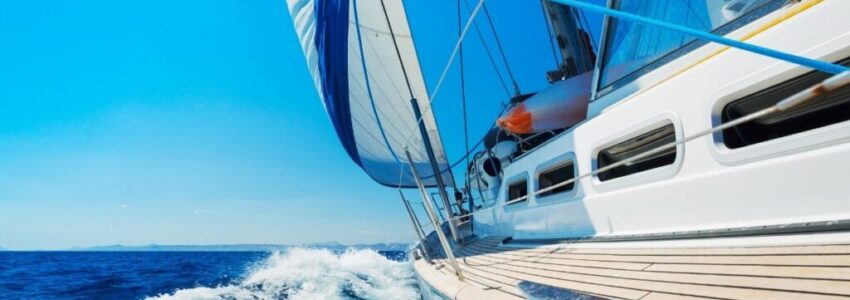
Published Aug 30, 2021
Going on a trip but don’t know what boat to use? If you have been eyeing Catamaran and Monohull boats, you are in the right place. If you can’t choose between the two, knowing their pros and cons should help you decide. In this article, we will be battling catamaran vs. monohulls to determine which one is more suitable for you.
What is Catamaran?
A catamaran is a sailboat with multihulls that features two parallel hulls of equal size. This type of boat has been popular ever since because of its stability and size. In addition, vacationers tend to sail with catamaran boats because of their space above and below.
What are Monohulls?
Unlike catamaran boats, a monohull is a boat that comes with only one hull. Monohull boats are the most widely used form of waterborne vessel. Sailing in a monohull may satisfy a person’s inner sailor self and give them the whole sailing experience. In addition, this type of boat is cheaper than other boats since it only caters to one hull.
Since catamaran and monohulls are completely different boats, we should compare and contrast their characteristics.
Spaciousness
The multihulls of catamarans give the boat additional space for the galley, cockpit, and more rooms when it comes to space. Catamaran boats also feature shallower draft, smaller displacement, and less hull volume than monohull boats. Therefore, this boat is more spacious than a monohull boat. It should be what you’re looking for if you’re sailing with family or friends.
On the other hand, monohull boats provide limited space, and most spaces are below the waterline. This might be concerning, especially for non-sailors, like vacationers. However, long-time sailors are most likely used to this situation. In addition, a monohull is smaller than most catamarans since it only consists of one hull.
Stability and Comfort
Another advantage of having multi-hulls is inheriting more stability than a one-hull boat. Catamarans are less prone to rocking and heeling, which makes them an ideal boat for family vacations. Large families usually include kids or seniors that get out of balance easily. Sailing in a catamaran boat would surely be more comfortable for you. Catamaran also features a separated skipper cabin that separates the crew and boat guests. Some larger skipper cabins provide full equipment like an isolated shower, sink, and toilet. In catamaran boats, you can sunbathe, lounge, or even jump on a trampoline while onboard.
Monohull boats are obviously less stable than multi-hull catamarans. From the word “mono,” monohulls only have one hull, which makes it prone to being rocky than a multihull boat. A rocking boat might not be an ideal vacation boat for families.
Here are the advantages and disadvantages of sailing for both boats:
Catamaran boats are often faster than monohulls when sailing downwind, reaches, and broad. Moreover, they have low bridge decks likely to slap on the undercarriage when the boat is sailing upwind. That is what slows the speed of the catamaran boats.
Monohulls sail through water without any slapping or pounding that may slow down the boat. They tend to be faster than catamaran boats when going upwind since the slapping slows down the multihull.
Pounding and slapping
Multihulls are made so that guests and sailors can get the most out of their vacation. That is why producers of catamarans try their best to add as much platform in the boat as the low bridge deck. Unfortunately, the low bridge deck of a catamaran tends to pound and slap the undercarriage of the boat, especially when sailing upwind. Some people find the pounding and slapping sound annoying.
Monohulls don’t have a low bridge deck, so sailing comes smoothly for monohull boats. Monohull guests wouldn’t have a problem with the noise at all.
Maneuvering and docking
Multihulls are powered by two engines. Having two engines can be extremely helpful when it comes to an emergency. These engines make it possible for the boat to rotate to a full 360 degrees. Catamarans also have two rudders which makes it easier to dock the boat.
Monohulls are easier to maneuver because of their size. However, the monohull only consists of one engine for the whole boat. The engine of the monohull can be combined with a front bow thruster so the yacht/boat can move sideways, which is helpful for tight spaces. This function makes it easier for the sailor to dock the boat.
Catamaran boats are more expensive than most monohulls because of their features. They are known as a high-quality boat that reassures sailor’s guests that it’s safer than most boats and costs a lot of building materials as catamaran boats are more spacious. Catamaran boats may cost more because it’s a high demand boat. The cost for docking for this type of boat also costs double the price of a monohull since it’s bigger.
Monohulls usually cost cheaper than most catamaran boats because of the monohull’s building materials. Multihull boats typically need to double the building materials required for a catamaran. Therefore, monohull boats with the same sleeping capacity and equipment as the catamaran may cost cheaper than buying a catamaran.

Catamaran vs. Monohulls: What to Choose?
Catamarans are more expensive, but it’s a family vacation-friendly boat that offers a lot of advantages. On the other hand, monohull boats are cheaper, simpler, and perfect for aspiring sailors. In the end, it all comes down to the person’s preference, budget, and what suits their needs. So I will ask you, catamaran vs. monohulls? (Related: What to Know Before Renting a Catamaran Charter )
Experience Yacht Charters With Seafari In Boca Raton Florida
Looking for a great time on the water in Boca Raton Florida? Seafari Yacht Charters is number choice for yacht rentals in Boca Raton . Book our yachts for parties , exciting day trips to the Bahamas, romantic yacht dinner cruises , and much more. Come experience all South Florida has to offer with us.
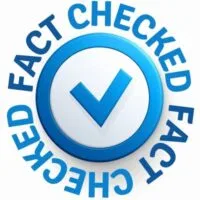
Fact Checked By Experts
Our team of internal experts has conducted rigorous fact-checking on this content. Explore the editorial standard for our website to dive deeper into our commitment to excellence.

About The Author
Krizzia Paolyn has a bachelors degree in Psychology and a passion for yachting in South Florida. She has a desire to be heard and to encourage others to make their voices heard as well.
Related Posts
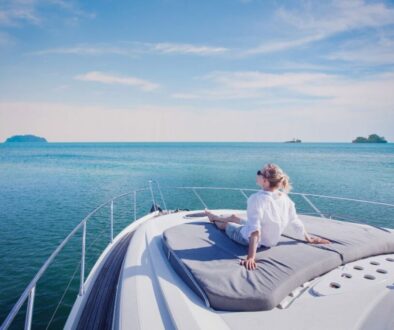
Yachting Benefits You Might Not Know
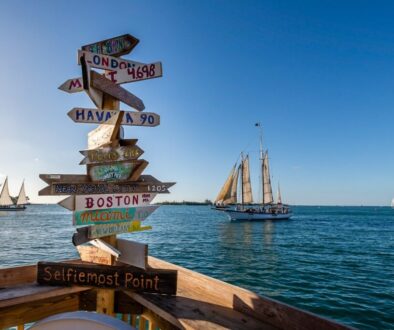
Most Popular , Yachting
How To Charter A Boat From Miami To Key West
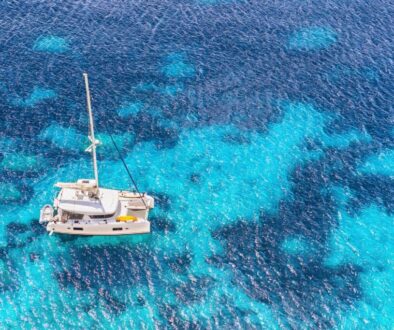
What To Know Before Renting A Catamaran Charter
Find us on social media.

© SeafariYachtCharters.com 2024
View Our Privacy Policy
Website design by Correct Digital
Catamaran vs Monohull in Rough Seas: Which is Better?
Catamarans and monohulls have different designs that affect how they handle rough sea conditions. In fact, they have an advantage over each other when sailing in heavy seas. Let's try to compare each type of vessel based on their performance, design, and stability, to help you decide which can give you a safer and more comfortable journey on the open water.
Regarding speed, efficiency, and stability, a catamaran may be the better option for you. Because they have twin hulls, they are more comfortable to sail in rough seas. A monohull can become more advantageous in rough seas when sailing upwind since it can point higher into the wind and can handle strong winds easily.
Catamarans with two rudders also allow for better control and maneuverability in rough seas compared to monohulls, which only have one rudder. Let's look at more of the comparison between these two types of boats when sailing through big waves in the sea.
- When it comes to stability and comfort, catamarans can provide more stability. They are also less likely to cause seasickness and offer more living space and privacy.
- In terms of speed, catamarans are also faster than monohulls because they have a smaller displacement. Their structure also makes them less likely to capsize or sink.
- A monohull is advantageous when it comes to sailing upwind, and handling stronger winds. Their deep keel also provides them with increased stability and reduces drag, which can be an advantage in rough seas.

Catamarans Vs. Monohulls in Rough Seas
If you're planning to buy a boat, and you're deciding whether to go for a catamaran or a monohull, one of the many things you may need to consider is how they perform in rough seas. Rough seas can be challenging for any vessel, but some boats are better equipped to handle them than others. Below is a table summarizing how well these boats perform in rough seas:
| Two hulls connected by a deck | Cruising, chartering, racing | More stable in terms of roll stability | Generally faster and more efficient due to twin hulls | Not as good as monohulls | |
| Only one hull | Day sailing, racing, cruising | Better at handling heavy seas and high winds | Not as fast or efficient due to single hull | Better than catamarans |
A catamaran is a boat with two hulls connected by a deck. Because they have two hulls , catamarans are known for their speed, stability, and spaciousness. They are often used for cruising and chartering, as well as racing. They also have a wider beam than monohulls, which means they offer more living space and stability. They are less likely to heel or tilt to one side, are more buoyant, and have a shallow draft.
On the other hand, monohulls are the most common type of boat with only one hull. They are known for their simplicity, versatility, and affordability. Monohulls are often used for day sailing, racing, and cruising.
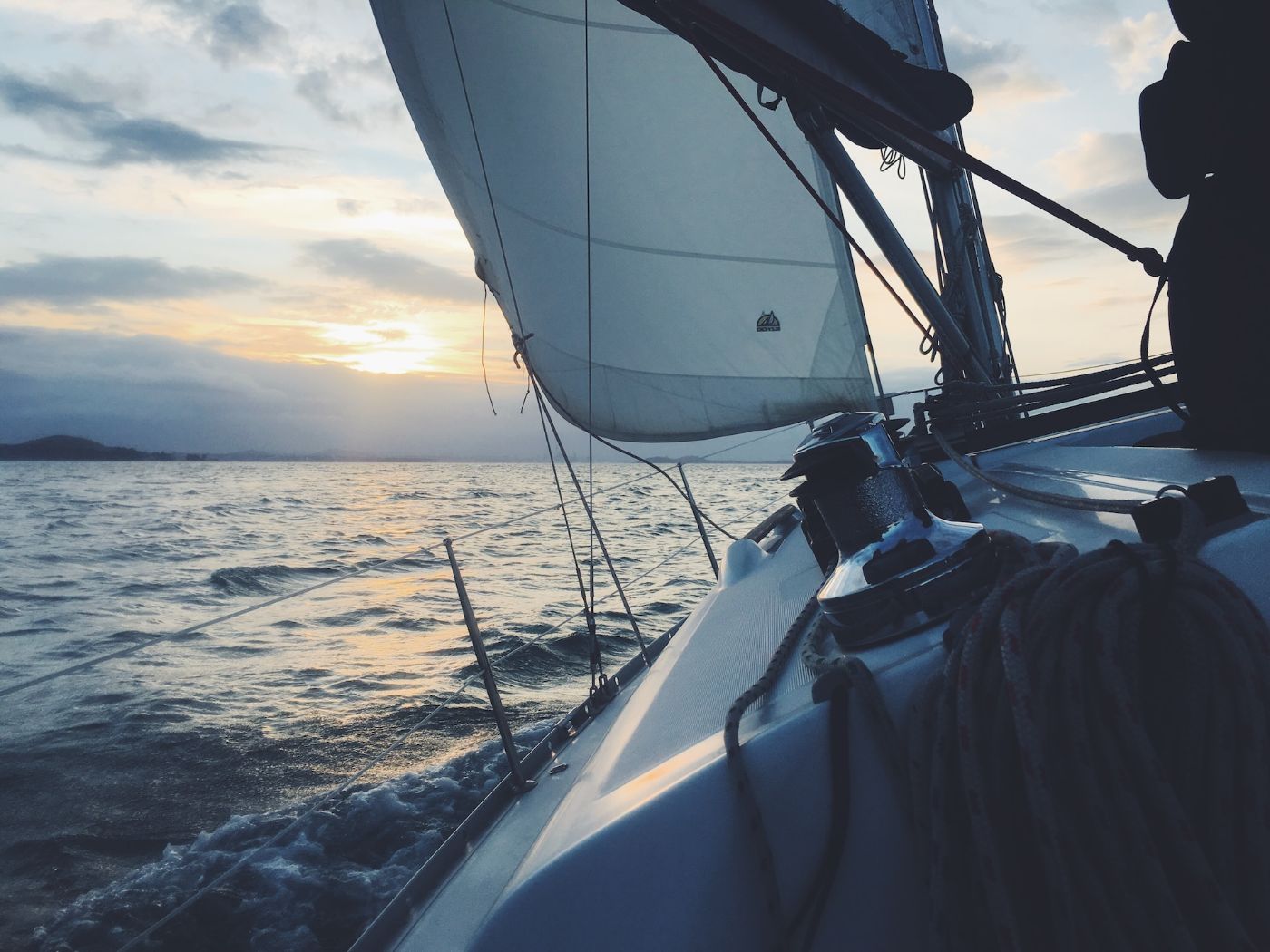
When it comes to rough seas, catamarans are generally more stable than monohulls in terms of roll stability. Monohulls, on the other hand, are better at handling heavy seas and high winds, but they can be more prone to rolling and pitching, and can significantly heel more than a catamaran.
If you are aiming for speed, efficiency, and stability, then a catamaran may be the better option for you. They are generally faster and more efficient due to their twin hulls, and their stability can make for a more comfortable ride in rough seas.
On the other hand, if you prioritize upwind sailing performance, sailing feels and responsiveness, and the traditional look and feel of a sailboat, then a monohull may be the better option for you. Monohulls sail closer to the wind and have a unique feel to them that some sailors prefer.
Detailed Comparison Between Catamaran And Monohull
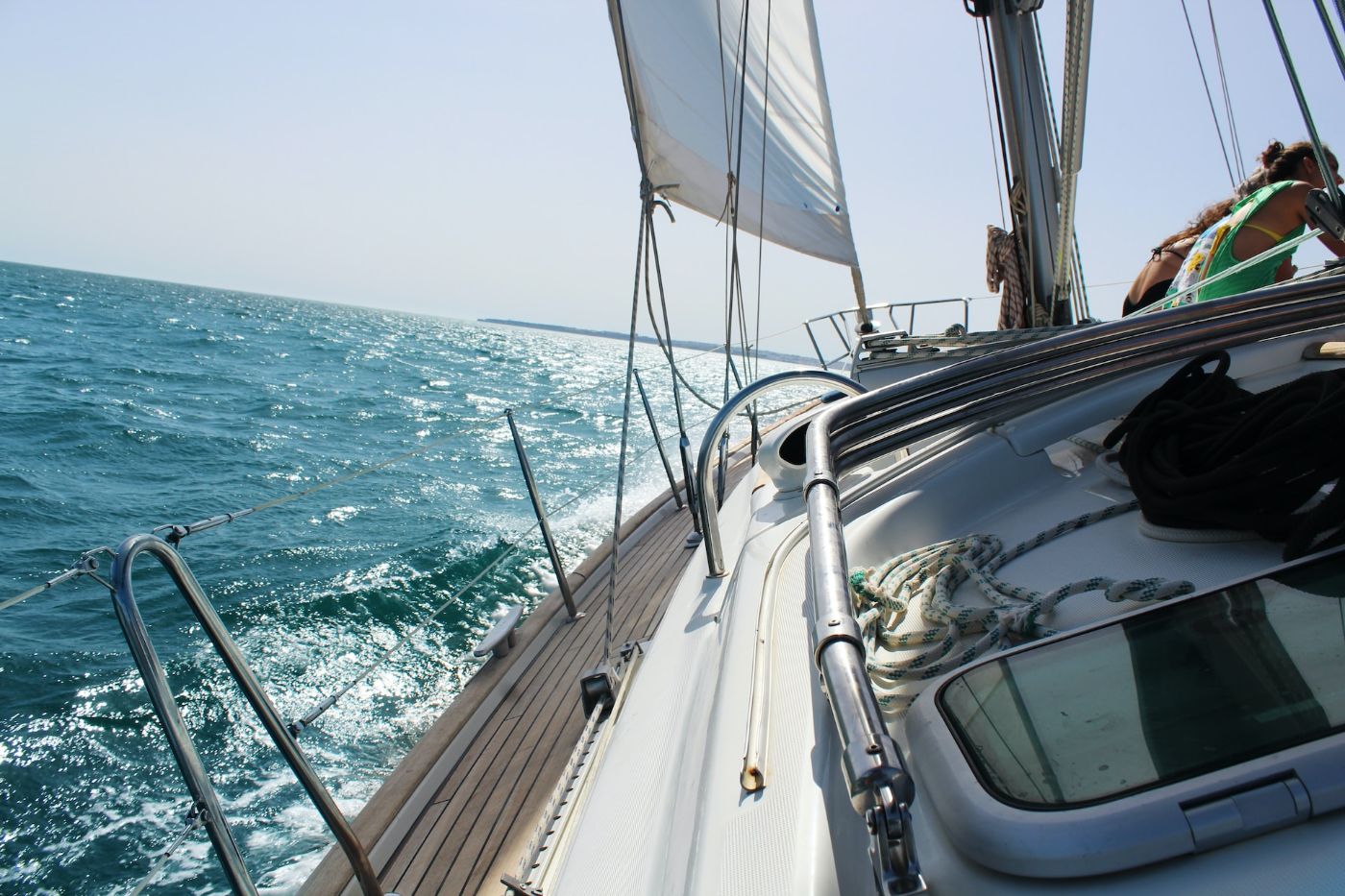
Catamarans provide better stability and comfort
Catamarans are more stable, less likely to cause seasickness and offer more living space and privacy. Below is a table summarizing why catamaran is more advantageous in this category:
| More stable, less likely to roll or heel | More likely to pitch and roll | |
| Less likely to cause seasickness | More likely to cause seasickness | |
| More living space and privacy due to two hulls | Less living space and privacy due to single hull |
In terms of motion in rough seas
Catamarans are more stable in rough seas because they have two hulls instead of one. This means that they are less likely to roll or heel, which can make for a more comfortable ride. Monohulls, on the other hand, tend to pitch and roll more in rough seas.
In terms of handling seasickness
If you are prone to seasickness, a catamaran may be a better choice for you. The stability of a catamaran means that it is less likely to cause seasickness than a monohull. Additionally, the living space on a catamaran is often spread out between the two hulls, which can help to reduce the feeling of confinement that can contribute to seasickness.
In terms of living space and privacy
Catamarans also tend to offer more living space and privacy than monohulls. Because the living space is spread out between the two hulls, each hull can function as a separate living space. This can be especially beneficial if you are traveling with a group of people and want to have some privacy.
Both boat types have specific advantages in performance and speed
A catamaran is generally faster and more stable than a monohull, but a monohull can be easier to handle in certain conditions.
| Less efficient | More efficient | |
| More stable due to wider beam | Easier to handle |
In terms of navigating upwind
When sailing upwind, a monohull has the advantage over a catamaran due to its ability to point higher into the wind. This means that a monohull can sail closer to the wind than a catamaran, which will need to tack more often. However, a catamaran can make up for this disadvantage with its speed. A catamaran can sail faster than a monohull , which can help it to cover more distance in less time.
In terms of handling strong winds
In strong winds, a catamaran is generally more stable than a monohull due to its wider beam. This means that a catamaran is less likely to heel over, making it more comfortable for passengers. However, a monohull can be easier to handle in strong winds due to its ability to reef the sails. By reducing the sail area, a monohull can reduce the amount of wind it catches, making it easier to control.
Catamarans and monohulls have different designs and function
Catamarans offer more deck and cabin space, shallow draft, and increased buoyancy, while monohulls have a deeper draft, reduced drag, and increased stability.
| Has wider beam and two hulls | Has a single hull | |
| Has a shallow draft | Has a deeper draft and keel |
In terms of the deck and cabin space
One of the advantages of catamarans over monohulls is their wider beam, which provides more deck space. This means more room to move around and increased stability, which is important in rough seas.
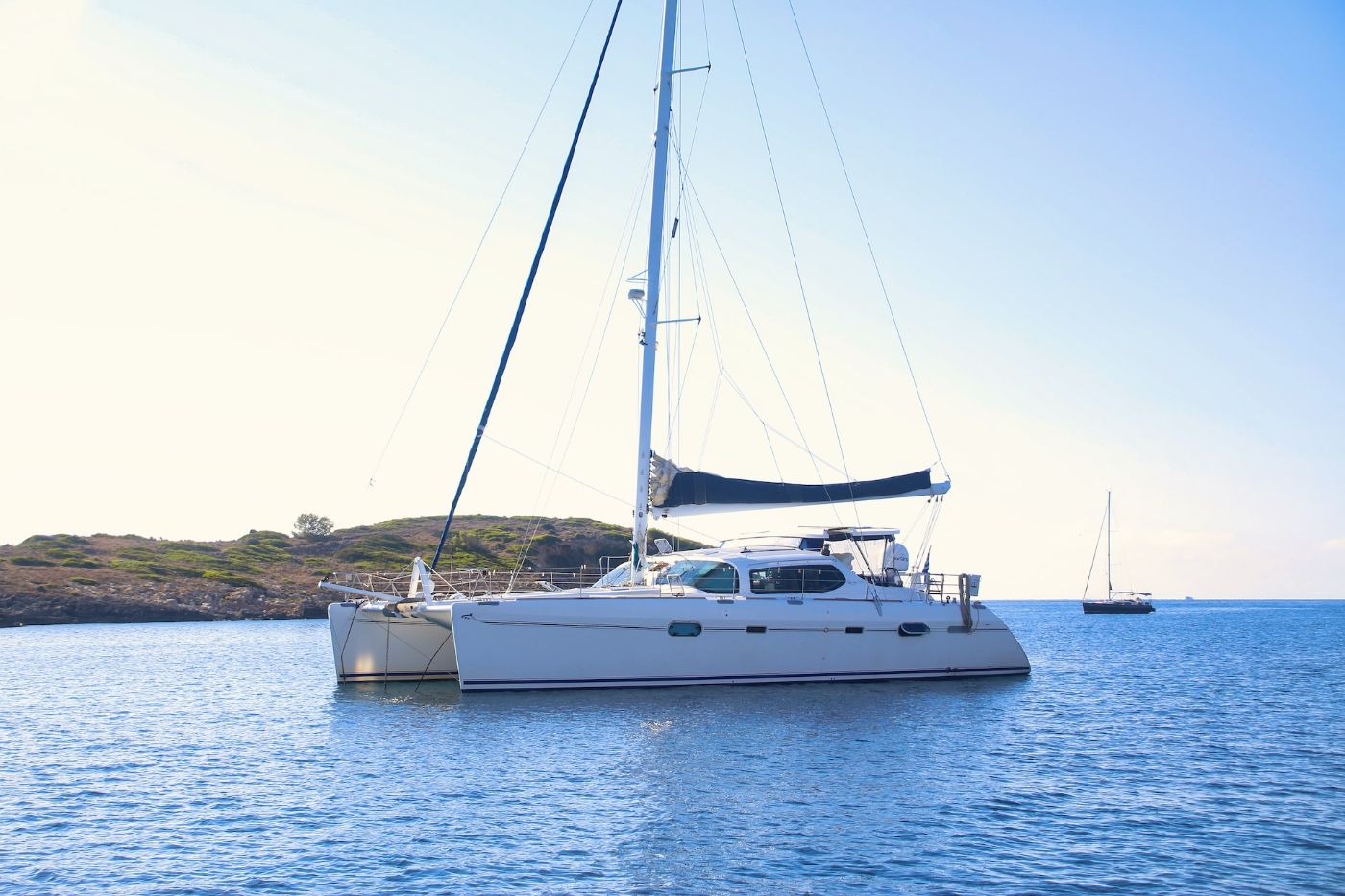
Additionally, catamarans usually have two hulls, which means more cabin space and privacy for the crew and passengers. On the other hand, monohulls have a single hull, which means less deck and cabin space. However, monohulls usually have a deeper draft, which allows them to sail closer to the wind and tack more efficiently.
In terms of draft and buoyancy
Catamarans have a shallow draft, which means they can sail in shallow waters and anchor closer to shore. This makes them ideal for exploring shallow coves and bays. Also, catamarans have two hulls, which provide increased buoyancy and stability in rough seas.
Monohulls, on the other hand, have a deeper draft, which makes them less suitable for shallow waters. However, their deep keel provides increased stability and reduces drag , which can be an advantage in rough seas.
Both boat types have unique safety considerations
Safety is a top priority when sailing in rough seas. Catamarans are generally more stable and easier to control, while monohulls have a greater risk of capsizing but are also more maneuverable in certain situations.
| Less likely to capsize and are virtually unsinkable | Has a keel and ballast that increase the risk of capsizing | |
| With two rudders that provide better control | Only has one rudder and is more susceptible to being pushed off course by waves and wind |
In terms of the risk of capsizing
One of the biggest safety concerns when sailing in rough seas is the risk of capsizing. Catamarans have two hulls, which make them more stable than monohulls. This means that they are less likely to capsize in rough seas. Catamarans are also technically unsinkable , meaning that they will not sink even if one hull is damaged or flooded.
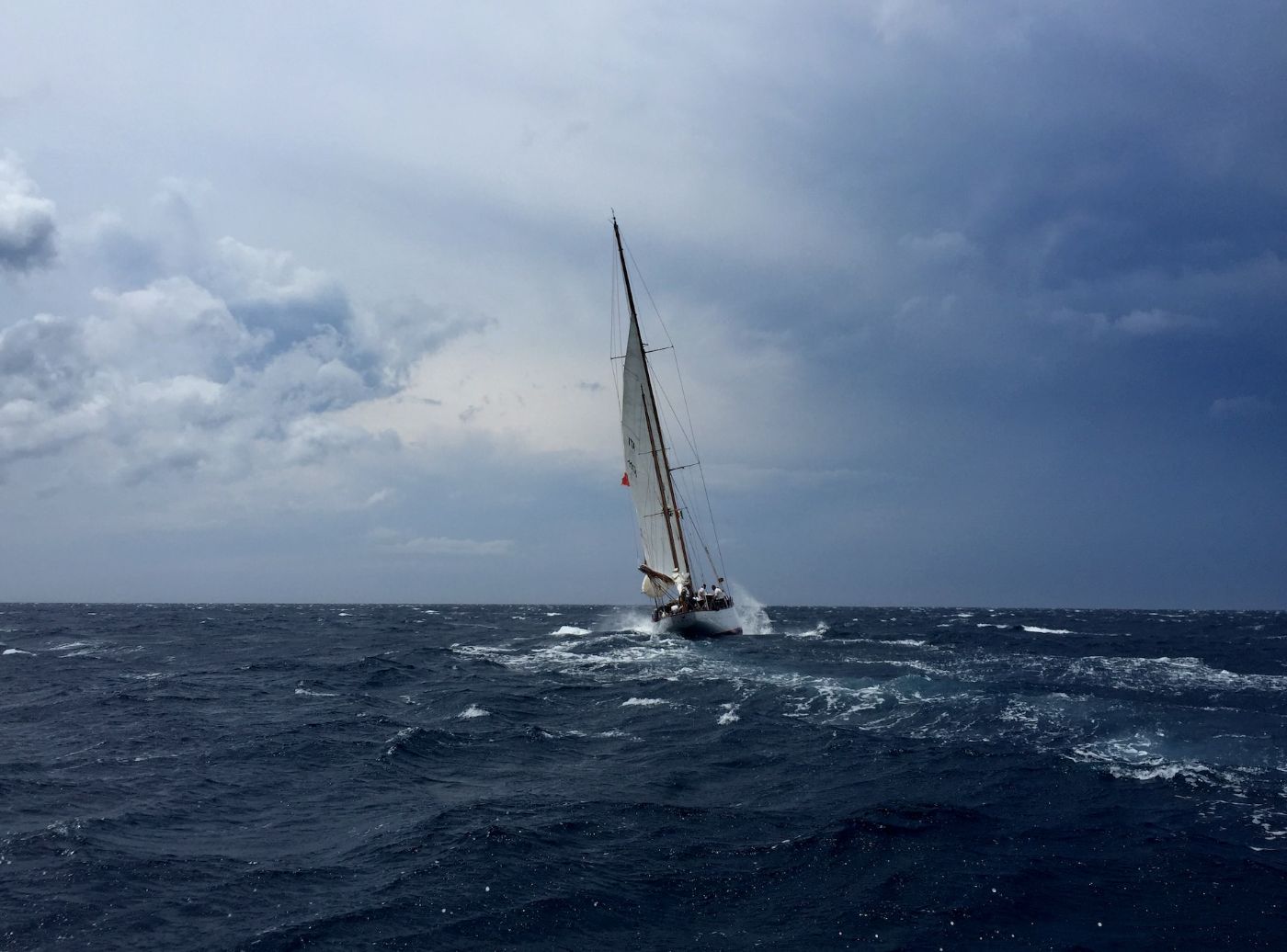
On the other hand, monohulls have a keel and ballast, which provide stability but also increase the risk of capsizing. If a monohull capsizes, it can be difficult to right the boat and prevent it from sinking.
In terms of navigational control
Catamarans have two rudders, which provide additional control and maneuverability in rough seas. This means that you can steer the boat more easily and avoid obstacles like rocks and other boats. Meanwhile, a monohull only has one rudder.
However, despite the number of rudders involved, the ability to control and maneuver the boat, whether a catamaran or a monohull, still depends on the design and construction of the boat, as well as the skill of the captain and crew in handling the boat.
Other practical considerations when choosing between catamaran and monohull
| Docking and anchorage | Easier to dock or anchor but can be more difficult to maneuver in tight spaces due to size | Generally easier to maneuver in tight spaces |
| Storage and equipment | Has more storage space | Only suited for certain types of equipment, such as fishing gear or diving equipment, due to the layout of the boat. |
| Crew accommodations | More spacious accommodations, which can be an advantage for longer trips or larger crews | May offer more privacy for individual crew members due to separate cabins and tighter quarters |
In terms of docking and anchorage
Docking and anchorage can be easier with a catamaran due to the wider beam, which provides more stability. However, catamarans can be more difficult to maneuver in tight spaces due to their size. On the other hand, monohulls are generally easier to maneuver in tight spaces, but they may be less stable in rough seas.
For docking costs, catamarans tend to have higher docking rate costs due to their size and wider beam. Read this article to know more about the costs of docking a catamaran in different locations.
In terms of storage and equipment
Catamarans typically have more storage space than monohulls due to their wider beam and larger deck area. This means they can carry more gear and supplies, making them a good choice for longer voyages or liveaboard situations. They can accommodate larger equipment such as dinghies, kayaks, and paddleboards - making them a great choice for water sports enthusiasts who want to bring their gear along.
Monohulls, on the other hand, have less storage space due to their narrower beam and smaller deck area. This means they are better suited for shorter trips or day sailing, where less gear and supplies are needed. Monohulls may also be better suited for certain types of equipment, such as fishing gear or diving equipment, due to the layout of the boat.
In terms of crew accommodations
Catamarans tend to have more spacious accommodations than monohulls, which can be an advantage for longer trips or when traveling with a larger crew. However, monohulls may offer more privacy for individual crew members due to the separate cabins and tighter quarters.
Catamarans generally have more living space than monohulls so they can offer more room for sleeping, lounging, and cooking, which can be especially beneficial for larger crews or families. They also often have large, open salons and cockpits that allow for easy socializing and entertaining. This can be a great feature for crews who enjoy spending time together.
Monohulls, on the other hand, have less living space than catamarans due to their narrower beam. This means they may be better suited for smaller crews or shorter trips. They often have cabins located closer together, which can make it easier to communicate and work together as a crew, which is a plus for racing or cruising in crowded areas.
Choosing boat type based on personal preferences
In terms of aesthetics and personal taste.
One of the first things that come to mind when choosing between a catamaran and a monohull is aesthetics. Both types of boats have their unique look, and it is up to personal preference which one you find more appealing. Some people prefer the sleek and modern look of a catamaran, while others prefer the classic look of a monohull.
Another thing to consider is personal taste. If you are someone who prefers a more spacious and open boat, then a catamaran might be the right choice for you. On the other hand, if you prefer a more traditional sailing experience, then a monohull might be the better option.
In terms of suitability for families and couples
Basically, catamarans are known for their stability and spaciousness, making them a great choice for families with children or couples who want to have more space and privacy.
Monohulls, on the other hand, might not be as spacious as catamarans, but they offer a more traditional sailing experience. If you are a couple or a small family who wants to experience the thrill of sailing and doesn't mind being in close quarters, then a monohull might be the right choice for you.
Leave a comment
You may also like, cost of catamaran vs. monohull: which is more expensive.
The market for monohull sailboats is a lot bigger than that of catamarans, which is one of the reasons why they are so much cheaper.
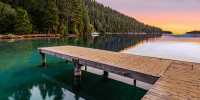
How Much Does It Cost to Dock a Catamaran? (7 Locations)
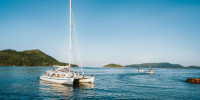
The Perfect Size Catamaran to Sail Around the World

17 Sailboat Types Explained: How To Recognize Them
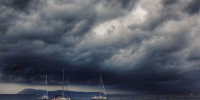
What Type of Hull Handles Rough Water the Best?
- About Sailonline
The One Source For Yacht Charters And Charter Yacht Ownership

- What is boat chartering
- Choose your best charter type
- Choose your charter company
- Choose a cruising area
- Choose the right boat
- Booking your charter
- Your sailing resume
- Yacht Charter Destinations Chart
- Catamarans vs. monohulls
- Bareboat Destination Skills
- Sailing Area Table
- Caribbean weather info
- What to pack for your charter
- Charter boat checklist
- Internet access on charter
- Briefing your charter crew
- Saving money on charter
- All boat charter tips in 1 file
- Budget Charter Fleets
- Provisioning a charter boat
- Booking directly with a boat owner
- The charter days you really get
- Managing your boat on charter
- Boat charter with kids
- Seasickness tips
- Starting a charter from the USVI
- If you damage a charter boat
- Flotilla charters
- Charter with a handicapped child
- Crewed yacht charter myths
- Organize a crewed charter
- Crewed charter tips
- Browse The Database
- Submit your Boat Listing
- Yacht Management Contract
- Buying a boat with a partner
- Bareboat vs. crewed yacht
- Charter Yacht Phase-out
- Phase-out punch list
- Yacht & Marine Surveyors
- Charter Boat Owners forum
- Yacht financial management tools
- 2nd tier fleets financial comparo
- Active ownership FAQ
- Layman guide to charter boat ownership
- Is Buying A Charter Boat For You?
- Buying a used charter boat
- Yacht buyer representation
- Bareboat vs. crewed yacht ownership
- Active Yacht Ownership
- Customers' Testimonials
- Cruising Logs
- Captain licenses
- 'Heaving to' maneuver: A must
- Charter Boat Seamanship Manual
- Yacht Crew Certification: All answers
- Snorkeling & kayaking safely
- Rules of the Road
- MOB Crash-Stop Maneuver
- 5 Knots you must know
- Flag Etiquette
- Emergencies on charter
- Distress calls at sea
- Navigation on a yacht charter
- Navigation aids sheets
- Estimate distances at sea
- Heavy weather basics
- Caribbean weather information
- VHF use: The basics
- Raising Main Sail | UnPC
- Anchoring technique & hand signals
- Catamaran sailing tips
- Docking: Avoid the embarrassment!
- Mooring technique
- Med-mooring technique
- Dinghy handling: make the best of it!
- Reefing a Catamaran
Remember Me
- Forgot your password?
- Forgot your username?
- Create an account
Catamarans - Monohulls: Pros and Cons

With catamarans vastly popular in the charter industry, and showing no sign of abating, let's compare the pros and cons of monohull and catamaran strictly on the charter work point of view . The reason why this distinction is important – and I write this as a monohull fanatic myself - is because for charter companies, catamarans are in huge demand due to the overwhelming number of advantages they offer. Out of charter use, there is no question for me that, when the offshore going gets tough, I would much rather be on a solid monohull than on a catamaran - although the catamaran builders have come a long way to strengthen comstruction. But this is just a matter of opinion!
Catamaran Pros
On deck The cockpit, highlight of catamarans, is usually huge, since it spans over both hulls. The cockpit and the salon are on the same level, which enhances the feeling of light and spaciousness, along with the typical huge panoramic windows. The foredeck area is very large as well and sports a big pair of nets between the hulls, the notorious trampolines, which make a great sun bathing area. In any case, it is a great observation spot and a kids' favorite. As a result of this roominess, a catamaran rarely feels crowded, as it is relatively easy to get some seclusion and quietness from other members of the party. Most cats are equipped with dinghy-davits at the transom, which is absolutely great: no more towing the dinghy, thus no more drag on the boat speed.
Down below The catamaran will provide you with considerably more room than a monohull almost everywhere on the boat: in the cabins and in the salon. Besides, there is ample headroom everywhere. A typical 43/47 ft. cat will have 4 large staterooms, with rectangular queen-size beds – no more of those pointy beds! - each with en-suite bathroom. A 38 to 42ft. will have 3/4 staterooms and 2/3 bathrooms. Most cats have an enormous salon/cockpit combination capable to entertain about 20 people in style! Because of the cats’ layout configuration, there is full privacy in every cabin and one does not hear anything from one cabin to the other.
Stability The key fact is that catamarans have a phenomenal stability: they do not heel under way and do not roll at anchor. This usually makes seasickness a non-event. Incidentally, it makes it somewhat safer for kids running around. Whether at anchor or under way, a catamaran is always much more stable than a monohull. Stability is also a good factor for elderly people and/or first time sailors. As a matter of fact, a catamaran will give the latter an excellent impression for their first cruise, instead of memories of being seasick!
Speed & maneuverability There is no question that catamarans are faster under power or sail. Whatever your cruising goals are, catamarans will usually move you about more quickly than a monohull. Catamarans have shallow drafts. This means catamarans can get into places monohulls yachts often cannot reach, and that they can also anchor closer to shore. However, more and more charter cats now have small "sacrificial" keels to improve close-hauled performance. Lastly, I personally enjoy the phenomenal maneuverability of the cats. With 2 engines spread apart, you can pivot a cat of any size literally around the boat's central axis – and without the help of the rudders. The autopilot works particularly well on cats, on a tracking standpoint.
Catamaran Cons
A hard-core monohull sailor once said: "When I sail a cat, it feels like I am driving my living room!" He meant that a cat does not convey the "real" feeling of sailing, with the "rail in the water" as sailors say. That is precisely because a cat does not heel, whereas a monohull does, and sometimes a lot. So if you are in for hard, pure sailing, you will not get that felling on a cat. Only a monohull will give you the full experience!
A cat does not typically sail well upwind and needs a different technique for tacking and anchoring. ( See tips for cat handling ).
It is often said that anchoring a catamaran can be more difficult. This is due to the fact that catamarans have more “windage” than monohulls, and, without keel and ballast, they have a tendency to “bob” on the water when a gust hits. ( See tips for cat anchoring )
Obviously, catamarans take up twice as much docking space as monohulls. This can be a bit of a problem in chartering areas where spending nights in marinas is a necessity.
If you are bringing with you a party of first-time sailors, or older people, or people who could feel apprehensive at sea, you probably will better off with a cat.
- PREMIUM FILES
- Pre-Owned Yachts
- Charter Boat Owners/Buyers Forum
- Favorite Links
|
|
| Built their boat. |
Copyright ©2000 - 2022 Sailonline.com. Unauthorized reproduction prohibited. Sailonline is not affiliated with any charter company.

- Find A School
- Certifications
- North U Sail Trim
- Inside Sailing with Peter Isler
- Docking Made Easy
- Study Quizzes
- Bite-sized Lessons
- Fun Quizzes
- Sailing Challenge

Come aboard and soak in the stunning views of downtown St. Petersburg, Florida, and the vast expanse of Tampa Bay with Intelligent Sailing’s top-notch experiences. Cruise on our cutting-edge luxury yachts for personalized, one-on-one coaching tailored to your skill level – whether you’re up for a laid-back “fun day” or aiming for advanced training and ASA certifications with our seasoned instructors. As ASA’s longest-serving Sailing School in St. Petersburg, Florida, boasting over 20 years of experience, we feature an entire fleet of new model yachts, ranging from just a few months to a few years old. With Intelligent Sailing, you sail and snooze on brand-new yachts!
Indulge in luxury with our Intelligent Sailing School or opt for our Yacht Club Membership program, or why not both? Gain exclusive access to our impeccably maintained fleet of yachts, including monohulls and catamarans ranging from 32 to 51 feet, each decked out with lavish amenities like multiple cabins, air conditioning, generators, refrigerators/freezers, fresh-water electric heads, and more.
Nestled in the prestigious Harborage Marina, our spot offers unparalleled convenience, with mega-yacht slips, a charming grilling area, swimming pool, lounge, showers, and laundry facilities. Enjoy easy access to downtown St. Pete’s vibrant scene, top beaches, and Tampa International Airport.
At Intelligent Sailing, we’re all about going above and beyond. From private cruises to beginner classes, corporate team-building events to special charters, we’ve got it all. Plus, explore ASA Sailing Certification Courses to boost your skills and confidence on the water.
Ready to turn your sailing dreams into reality? Our services include yacht brokerage, guiding you through every step of the process. With our Owner options, leave the care and maintenance to us while enjoying passive income opportunities based on usage.
Dive into the lively spirit of Tampa Bay and downtown St. Petersburg with Intelligent Sailing – where every journey promises extraordinary adventures.
Why settle for ordinary? Instead, join Florida’s premier sailing school and elevate your adventure with Intelligent Sailing. Choose from our fleet of new yachts and take your sailing escapades to new heights.
American Sailing Certifications Offered

Other Services Available
- Couples Courses
- Private Courses
- Weekday Courses
- Weekend Courses
- Corporate Team Building Courses
- ASA 'Challenges'
- Day Sail Charters (public)
- Day Sail Charters (member-only)
- Sunset Cruises
- Sailboat Cruises
- Racing Courses
- Spinnaker Courses

ASA Veterans Sailing Education Program - Sign Up Now >>
At ASA we recognize the sacrifices made by the brave men and women who have served or are serving in our country's armed forces. As a token of our appreciation, and our way of saying thank you, we are inviting veterans and active military personnel to share our passion for sailing by offering a discount on our ASA 101 Basic Keelboat Sailing course. Intelligent Sailing is offering a minimum of $50.00 or 10% off their ASA 101 Basic Keelboat Sailing course.
Sailing School Reviews / Testimonials
David - Intelligent Sailing
Trey - Intelligent Sailing
Payton - Intelligent Sailing
Contact Information
| Address | 1110 3rd Street SouthSt. PetersburgFL33701USA |
|---|---|
| Phone | (727) 688-3007 |
| Website | |
| | |
Other Popular Schools...

- Learn To Sail
- Mobile Apps
- Online Courses
- Upcoming Courses
- Sailor Resources
- ASA Log Book
- Bite Sized Lessons
- Knots Made Easy
- Catamaran Challenge
- Sailing Vacations
- Sailing Cruises
- Charter Resources
- International Proficiency Certificate
- Find A Charter
- All Articles
- Sailing Tips
- Sailing Terms
- Destinations
- Environmental
- Initiatives
- Instructor Resources
- Become An Instructor
- Become An ASA School
- Member / Instructor Login
- Affiliate Login
Sie verwenden einen veraltete Webbrowser. Aktualisieren Sie Ihre Version von Internet Explorer oder Installieren Sie einer modernen Webrowser um diese Site in vollen Umfang zu erleben.

Welcome to Intelligent Sailing.
(left to right) - i.s 42 jeanneau - i.s 35 beneteau - i.s 32 jeanneau., bavaria, beneteau, jeanneau, lagoon, leopard, seawind, now in our 21st year. featuring monohulls and catamarans , we are a sailing school, a boat club & we offer captained charters., exclusive to the harborage marina with premium slips, offering brand new yachts - all yachts range from new to in service a few years.., i ntell i gent sa i l i ng offer i ng monohull & catamaran opt i ons to sa i l introducing the intelligent sailing fleet -, the i .s 38c - new 2023 seawind 1160 catamaran, the i .s 42c - new 2024 leopard 42 catamaran, & the following monohulls, i .s 32 new 2021, i .s 34 new 2023, i .s 35 new 2020, i .s 38 new 2022 go b i g, i .s 42 new 2021 go b i gger, i .s 51 new 2023 go bold, we continuously bring you brand new yachts, i .s 32 new 2021 jeanneau 319, i .s 34 new 2023 bavaria 34, i .s 35 new 2020 beneteau 35.1, i .s 38 new 2022 bavaria 38, i .s 42 new 2021 jeanneau 410, i .s 51 new 2023 jeanneau 490.

The global authority in superyachting
- NEWSLETTERS
- Yachts Home
- The Superyacht Directory
- Yacht Reports
- Brokerage News
- The largest yachts in the world
- The Register
- Yacht Advice
- Yacht Design
- 12m to 24m yachts
- Monaco Yacht Show
- Builder Directory
- Designer Directory
- Interior Design Directory
- Naval Architect Directory
- Yachts for sale home
- Motor yachts
- Sailing yachts
- Explorer yachts
- Classic yachts
- Sale Broker Directory
- Charter Home
- Yachts for Charter
- Charter Destinations
- Charter Broker Directory
- Destinations Home
- Mediterranean
- South Pacific
- Rest of the World
- Boat Life Home
- Owners' Experiences
- Conservation and Philanthropy
- Interiors Suppliers
- Owners' Club
- Captains' Club
- BOAT Showcase
- Boat Presents
- Events Home
- World Superyacht Awards
- Superyacht Design Festival
- Design and Innovation Awards
- Young Designer of the Year Award
- Artistry and Craft Awards
- Explorer Yachts Summit
- Ocean Talks
- The Ocean Awards
- BOAT Connect
- Between the bays
- Golf Invitational
- BOATPro Home
- Superyacht Insight
- Global Order Book
- Premium Content
- Product Features
- Testimonials
- Pricing Plan
- Tenders & Equipment

Shadowcat reveals 73m "adventure" catamaran concept Catfish
Support yacht specialist Shadowcat has revealed a 72.8-metre catamaran concept known as Catfish. The design has been created in collaboration with Berlin-based T. Fotiadis Design, who recently shared a 140-metre trimaran concept with BOAT International . Naval architecture has been completed by Incat Crowther .
Catfish is characterised by wave-compensation davits which can handle operations in 1.5-metre seas, unlike monohulls "which are often limited to launch and recovery in harbour conditions". She can function as a support vessel for a larger yacht or an explorer vessel in her own right.
This "superior stability" is complemented by the ability to carry and deploy a custom 18.6-metre sportfish, three bespoke tenders, a seven-person Triton submersible and an EC135 helicopter from a certified pad and hangar. Commercial off-shore davit and crane technology, lifts and foldable decks would work to maneuver the extensive list of equipment, which also encompasses five Jet Skis and a 12.2-metre RIB.
A noteworthy feature is the "mariner's den", designed with a large fold out balcony, lounge, bar and gyroscopic pool table. A glass-enclosed submersible garage and various toys are visible through the lounge’s roll up door. Other highlights include a gym, a dedicated spa and a beach club. Accommodation is for 10 guests and 19 crew,
On the support side, Catfish is equipped with hospital facilities and a chamber room, diver room, fish station, fish freezer and bait and tackle shop.
The vessel is expected to reach a top speed of 21 knots, a cruising speed of 14 knots and a range of 5,000 nautical miles. Key numbers include a 15.5-metre beam, a draft of 2.45 metres and a volume of 2,200GT.
Further details will be revealed at this year's Monaco Yacht Show .
For those attending the Monaco Yacht Show, visit Stand DS103 to say hello to the BOAT International team.
Sign up to BOAT Briefing email
Latest news, brokerage headlines and yacht exclusives, every weekday
By signing up for BOAT newsletters, you agree to our Terms of Use and our Privacy Policy .
More stories
Most popular, from our partners, sponsored listings.

IMAGES
VIDEO
COMMENTS
The final answer will depend on a number of factors, including: experience, crew, budget and the destination. There are pros and cons to both catamarans and monohulls so here's what to consider and how to maneuver them both like a pro. Your Experience And Familiarity. Managing a catamaran is not like driving a monohull in both good and bad ways.
Upwind sailing performance: While catamarans have the edge at straight-line speed, monohulls sail closer to the wind. When you're racing or you have to sail upwind to get to the next island, this can get you there faster. Sailing feel and responsiveness: The "feel" of sailing a monohull is much better.With a single hull, you'll feel wind pressure and trim adjustments immediately for a ...
Monohulls have a single hull, and catamarans have two hulls side-by-side. Catamarans are faster than monohulls of the same length and displacement, but monohulls are stronger and more spacious. Monohulls are also cheaper and easier to build than multi-hulls. In this article, we'll cover the differences between catamarans and monohulls, along ...
Catamarans have significantly shallower drafts than monohulls, allowing for safer anchorages closer to shore. Most catamarans in the 40-ft to 50-ft range draw between 3-ft to 4.5-ft, so they can anchor in places that a monohulls can not even consider. In the shallow waters of the Bahamas for example, the catamarans have a big advantage.
Growing Families: Many of these sailors transitioned as their families grew, valuing the additional space and privacy catamarans offer.. Long-Term Living: For those living aboard full-time, the comfort and stability of catamarans became increasingly attractive.. Performance vs. Comfort: While many started with performance-oriented monohulls, the balance of performance and comfort offered by ...
One of the most significant decision points when thinking about catamarans versus monohulls is your budget. If your budget is under $100,000, a monohull will be your best bet. If your budget is between $100,000 and $250,000, you can consider a smaller, older catamaran. Catamarans such as PDQs, Prouts, and Geminis will be in your budget.
This all means monohulls tend to come at a lower cost than their equivalent catamaran. In addition: Monohulls take up half the space at a marina than catamarans, and therefore generally cost you half as much. Monohulls are more readily available used in good shape, and cost less to charter for equal sleeping capacity. 5. Monohulls sail better ...
Generally speaking, monohulls tend to be less stable than catamarans, especially in rough waters. This is because the single hull has to work harder to maintain balance, and can be more prone to tipping or rolling. With two hulls connected by a platform, catamarans are the kings and queens of stability.
Among smaller catamarans and monohulls, pricing will vary, and a lightweight beach cat may be less expensive than a heavier monohull keelboat of similar length. Catamaran vs. Monohull, Pros and Cons. Depending on a variety of factors, there are plenty of catamaran and monohull pros and cons. These are some to keep in mind when comparing the two ...
Monohulls, due to their keeled design, tend to excel upwind. Their ability to 'point' into the wind is usually superior to that of a catamaran. On the other hand, catamarans, with their lighter weight and reduced drag, often have the upper hand in downwind and lighter wind conditions. Another factor to consider is load carrying capacity.
Monohulls and catamarans can both hold dinghies. The larger the boat, the larger the dinghy can be. However, catamarans have a wide area at the rear of the boat that is perfect for holding dinghies. This makes getting in and out of the dinghy easier.
Catamarans vs Monohulls - The Bottom Line. So, this is it! We've come to the end of this highly discussed topic among sailors. Obviously, everything would be determined by two basic factors: personal preferences and budget considerations. Both monohulls and multihulls have their pros and cons and it's totally up to you to decide which one ...
Jul 30, 2018. Original: Aug 17, 2015. Two sailboat experts argue monohull vs. catamaran. Contributed by Denison Yacht Sales. The great debate over which is better—one or two hulls—boils down to several factors, each with distinct advantages and disadvantages. The verdict usually defaults to personal preference and intended use of the vessel ...
20. Analysis: Comparing sailboat data to monohulls, catamarans frequently have a higher Sail Area-to-Displacement Ratio (SA/D). This suggests that catamarans may be able to use the wind more effectively, leading to faster speeds. The specific design and sail plan, however, are equally important in this regard.
Since catamaran and monohulls are completely different boats, we should compare and contrast their characteristics. Spaciousness. The multihulls of catamarans give the boat additional space for the galley, cockpit, and more rooms when it comes to space. Catamaran boats also feature shallower draft, smaller displacement, and less hull volume ...
Also, catamarans have two hulls, which provide increased buoyancy and stability in rough seas. Monohulls, on the other hand, have a deeper draft, which makes them less suitable for shallow waters. However, their deep keel provides increased stability and reduces drag, which can be an advantage in rough seas.
This means catamarans can get into places monohulls yachts often cannot reach, and that they can also anchor closer to shore. However, more and more charter cats now have small "sacrificial" keels to improve close-hauled performance. Lastly, I personally enjoy the phenomenal maneuverability of the cats. With 2 engines spread apart, you can ...
Catamarans differ from monohulls in some very significant ways; Cats are more stable, faster, offer more space, and have two hulls. Monohulls offer heeling, faster steering response, less noise from water slapping, are cheaper to buy and maintain and have one hull.
Monohulls heel upwind and when the wind is on the beam, while catamarans stay flat, but pitch upwind. Downwind, cats feel like a house gliding on the ocean at speed, while monos roll from side to side. The movement is very different in itself: catamarans will generally have a jerky, fast motion, while monohulls tend to be more gentle and slow.
Gain exclusive access to our impeccably maintained fleet of yachts, including monohulls and catamarans ranging from 32 to 51 feet, each decked out with lavish amenities like multiple cabins, air conditioning, generators, refrigerators/freezers, fresh-water electric heads, and more. ... Cruising Catamaran Learn to skipper an auxiliary-powered ...
I ntell i gent Sa i l i ng offer i ng monohull & Catamaran opt i ons to sa i l Introducing the Intelligent Sailing Fleet - ... NEW 2023 Seawind 1160 Catamaran The i.S 42C - NEW 2024 Leopard 42 Catamaran & the following Monohulls. i.S 32 New 2021. i.S 34 New 2023. i.S 35 New 2020. i.S 38 New 2022 Go B i g. i.S 42 New 2021 Go B i gger. i.S 51 New ...
These powerboats use the following propulsion options: outboard engine. There are a wide range of Power Catamaran boats for sale from popular brands like World Cat, Aquila and Invincible with 613 new and 680 used and an average price of $490,186 with boats ranging from as little as $21,900 and $8,940,000.
The most viewed brands for catamaran sailing vessels this month were Custom, Fountaine Pajot, Gemini, Lagoon and Leopard. With 305 catamaran sailboats currently listed for sale, as well as 33 added in the past 30 days, Boat Trader is confident that you'll find the boat you are looking for. Find catamaran sailboats for sale near you, including ...
Support yacht specialist Shadowcat has revealed a 72.8-metre catamaran concept known as Catfish. The design has been created in collaboration with Berlin-based T. Fotiadis Design, who recently shared a 140-metre trimaran concept with BOAT International.Naval architecture has been completed by Incat Crowther.. Catfish is characterised by wave-compensation davits which can handle operations in 1 ...